Meyers Manx company sold to new owners. November 10th 2020.
The “dune buggy” has fully and completely wiggled itself into American car culture as a permanent fixture over the last 50 years or so. The dune buggy that started it all is the Meyers Manx.
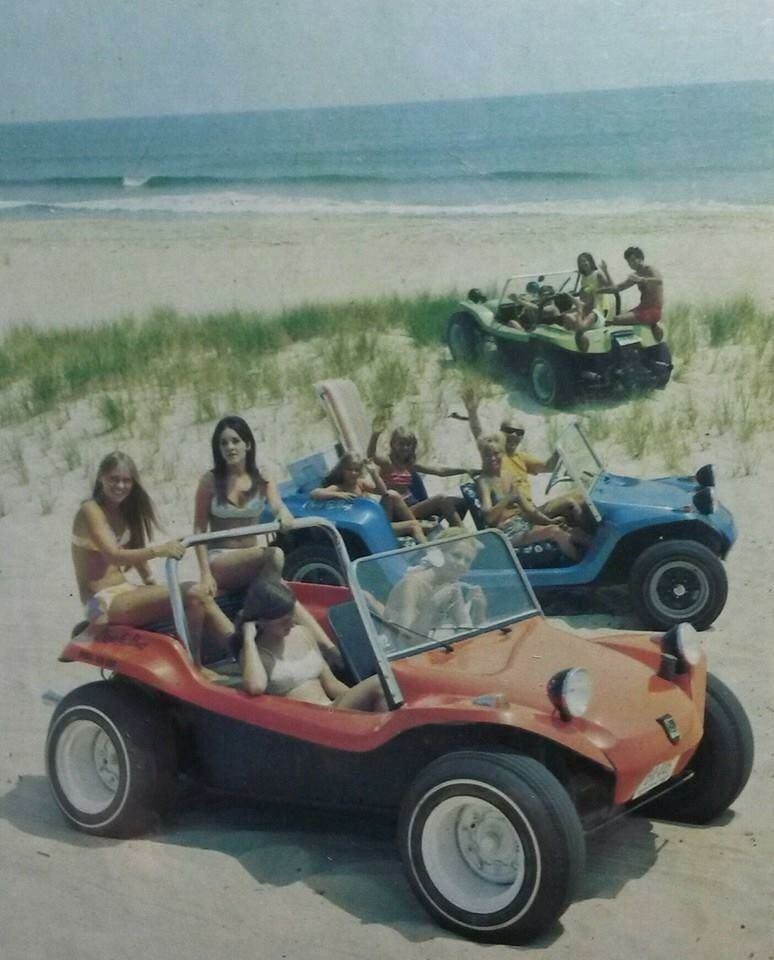
This icon of fiberglass fabrication is equally heartwarming and it is badass.
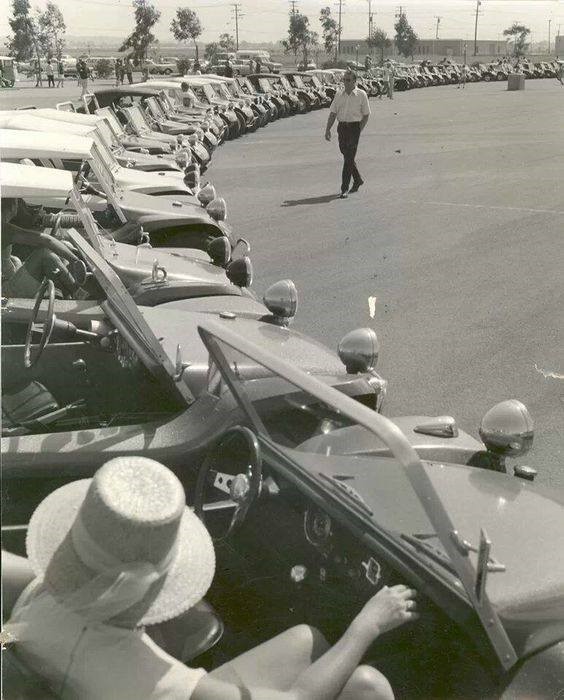
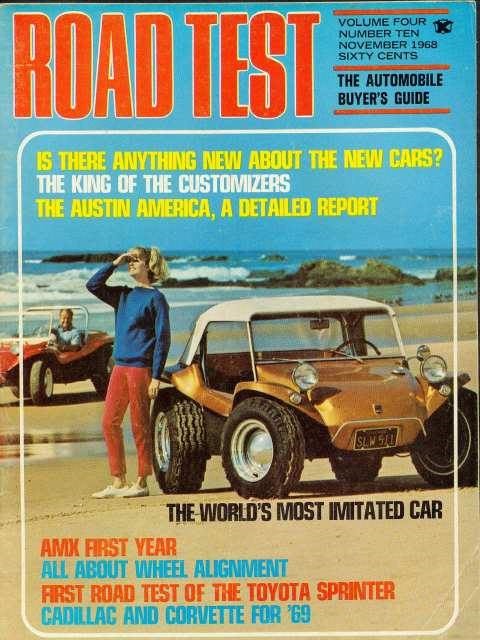
Performance, simplicity and raw joy has always been the defining nature of it.
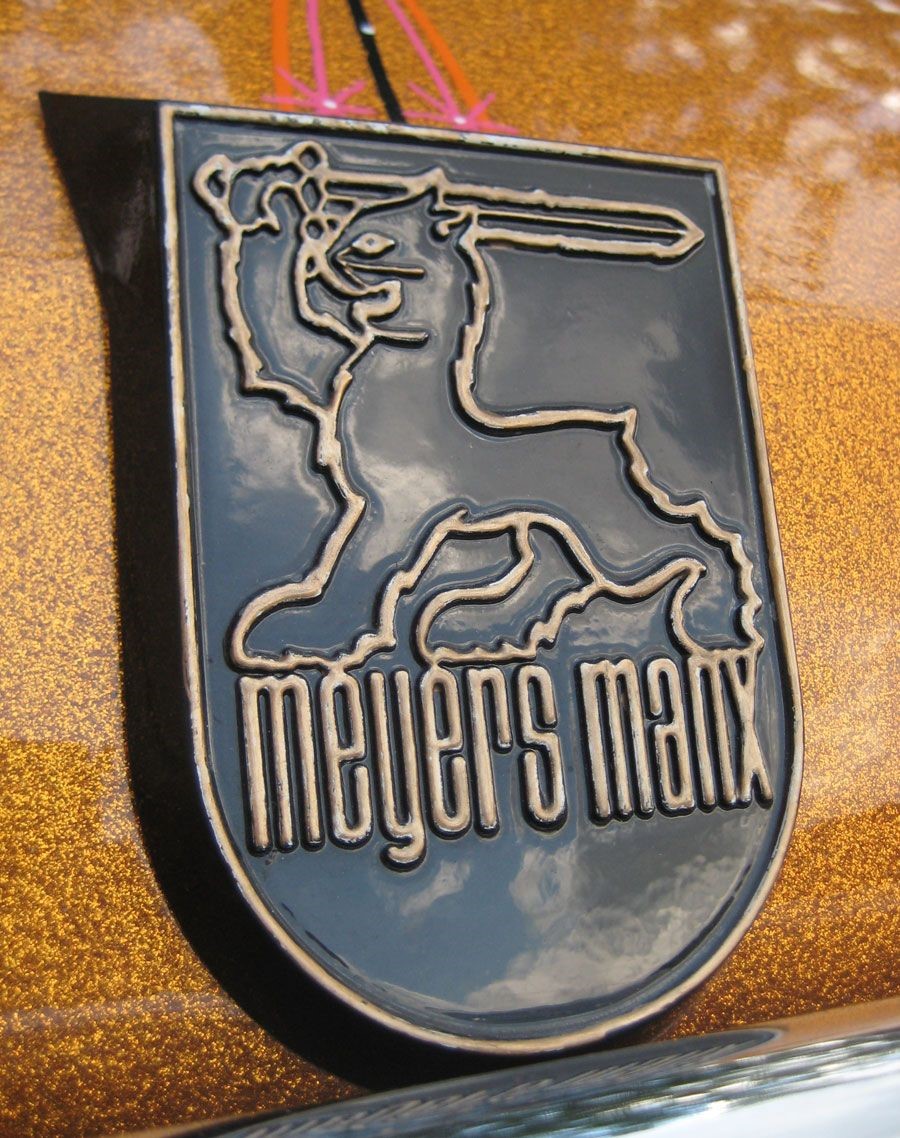
It’s no coincidence that Meyers Manx is the coolest car company once you know how cool its creator is. Bruce and his wife Winnie have run the company the same way they run their lives, simply and with a smile.
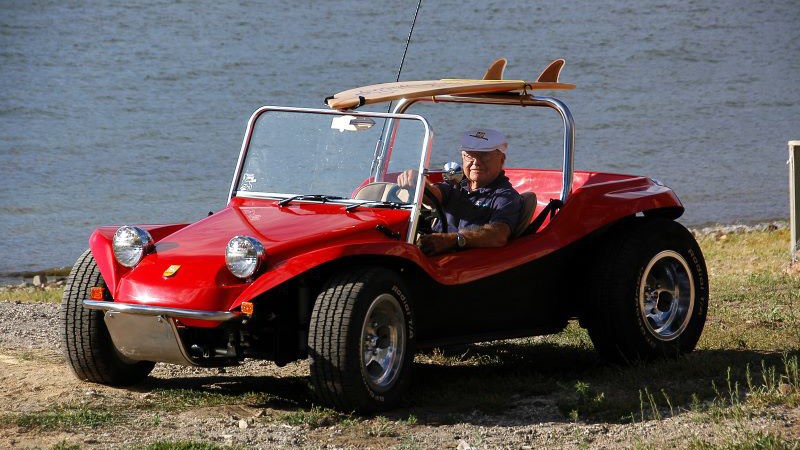
Bruce Meyers at 94 is finally letting his baby go.
The Meyers Manx dune buggy, the iconic Southern California car that inspired the dune buggy craze, is a small recreationally-oriented automobile, designed initially for desert racing by Californian engineer, artist, boat builder and surfer Bruce F. Meyers. New vehicles inspired by the original Manx buggy have been produced by Meyers's re-founded operation, Meyers Manx, Inc., since 2000.
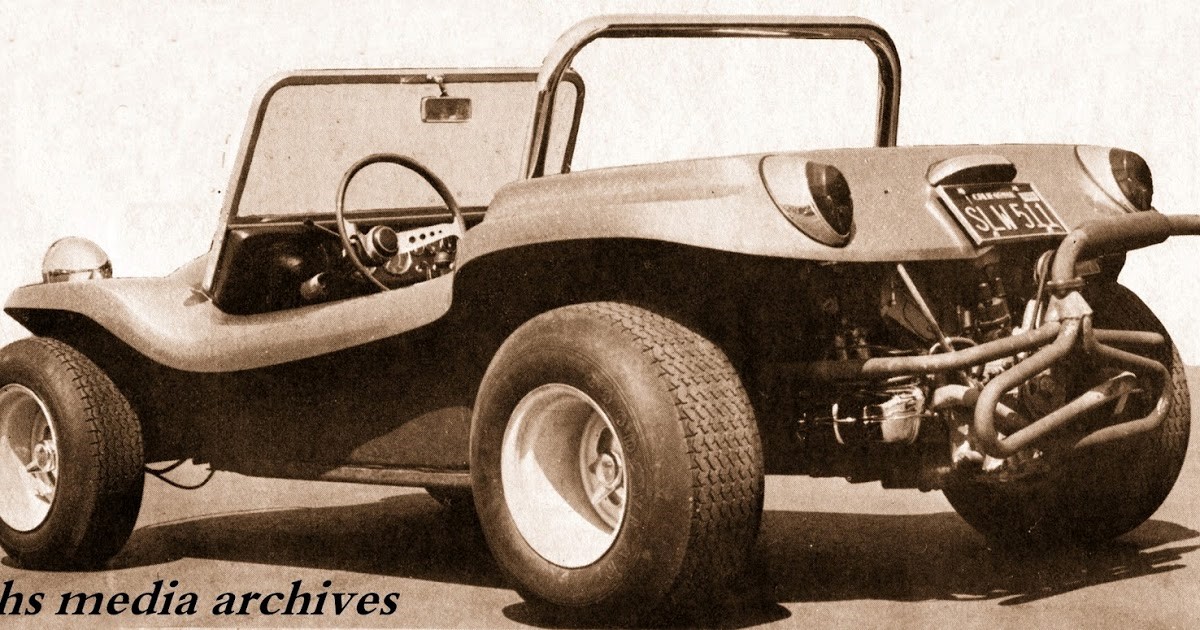
Body style: open-wheeled.
Engine: 1.2L VW H4, 1.3L VW H4, 1.5L VW H4, 1.6L H4.
Transmission: 4-speed manual transaxle, 2-wheel drive.
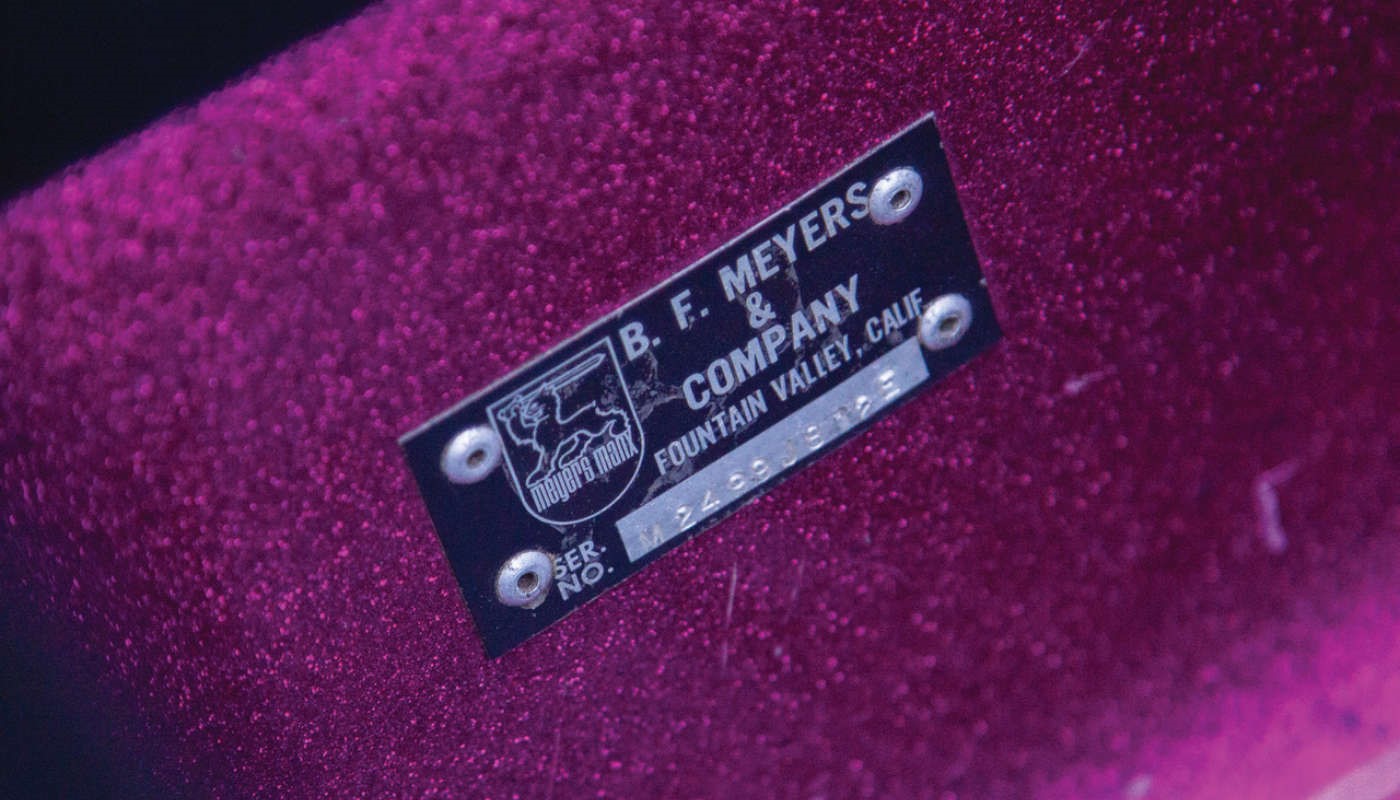
Bruce F. Meyers, known for launching the Meyers Manx dune buggy with his Fountain Valley company in 1964, produced until 1971 and then resumed in 1999, has decided to sell its business and brand.
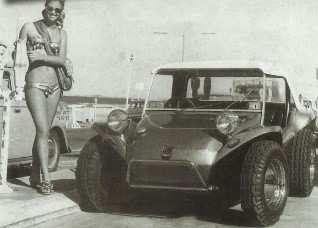
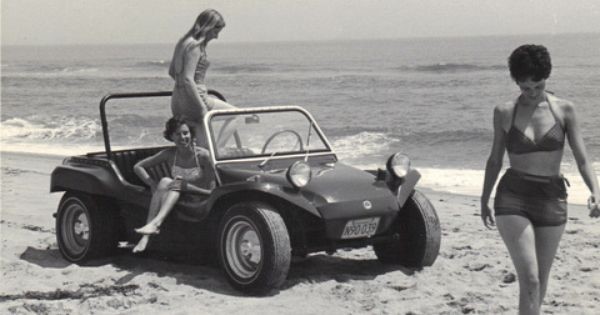
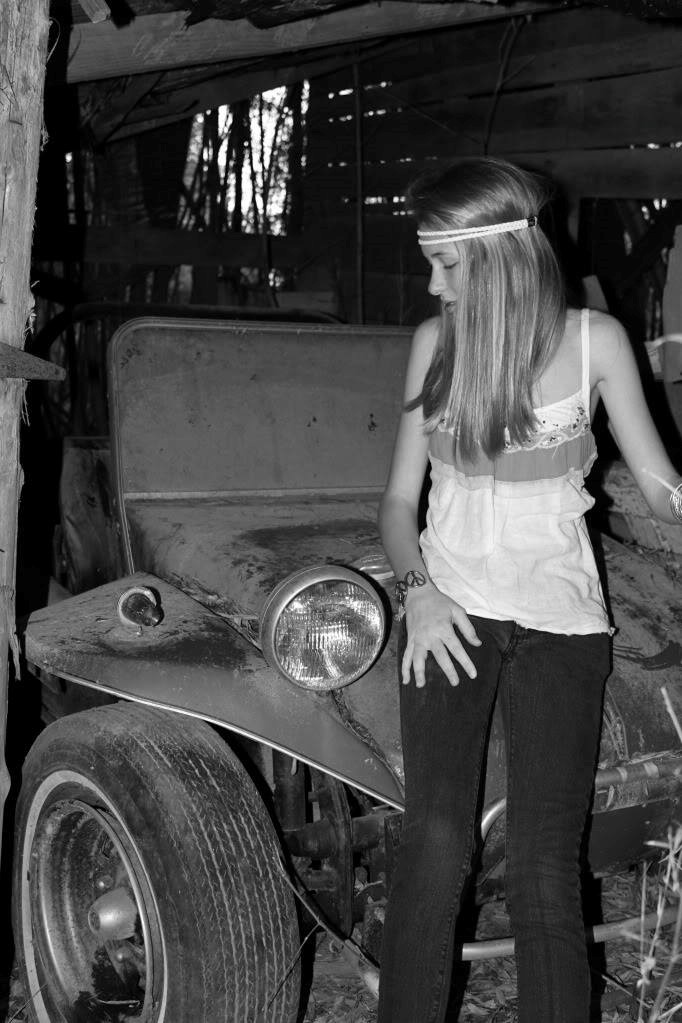
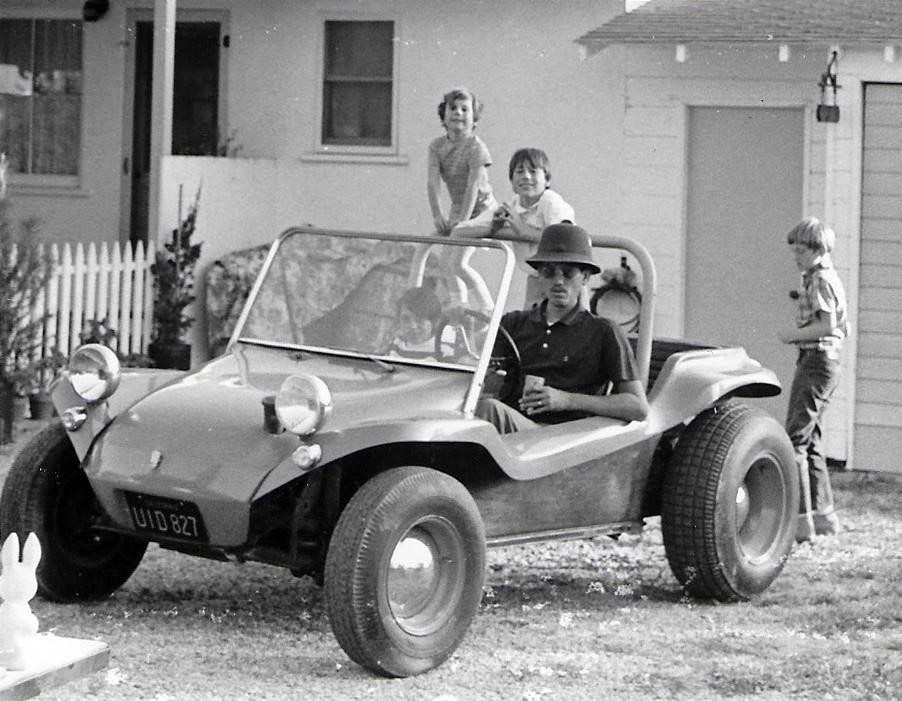
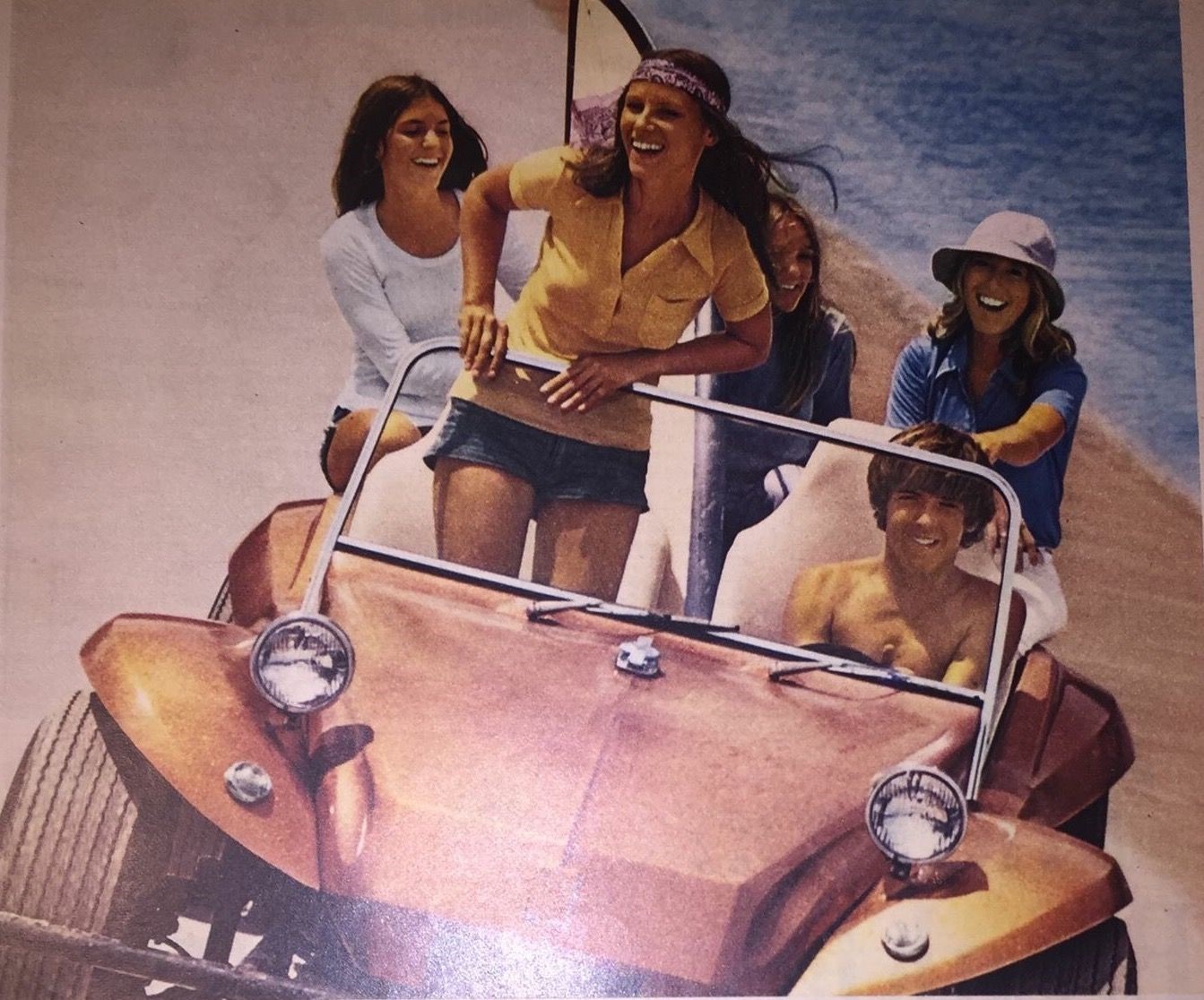
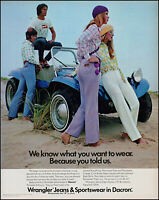
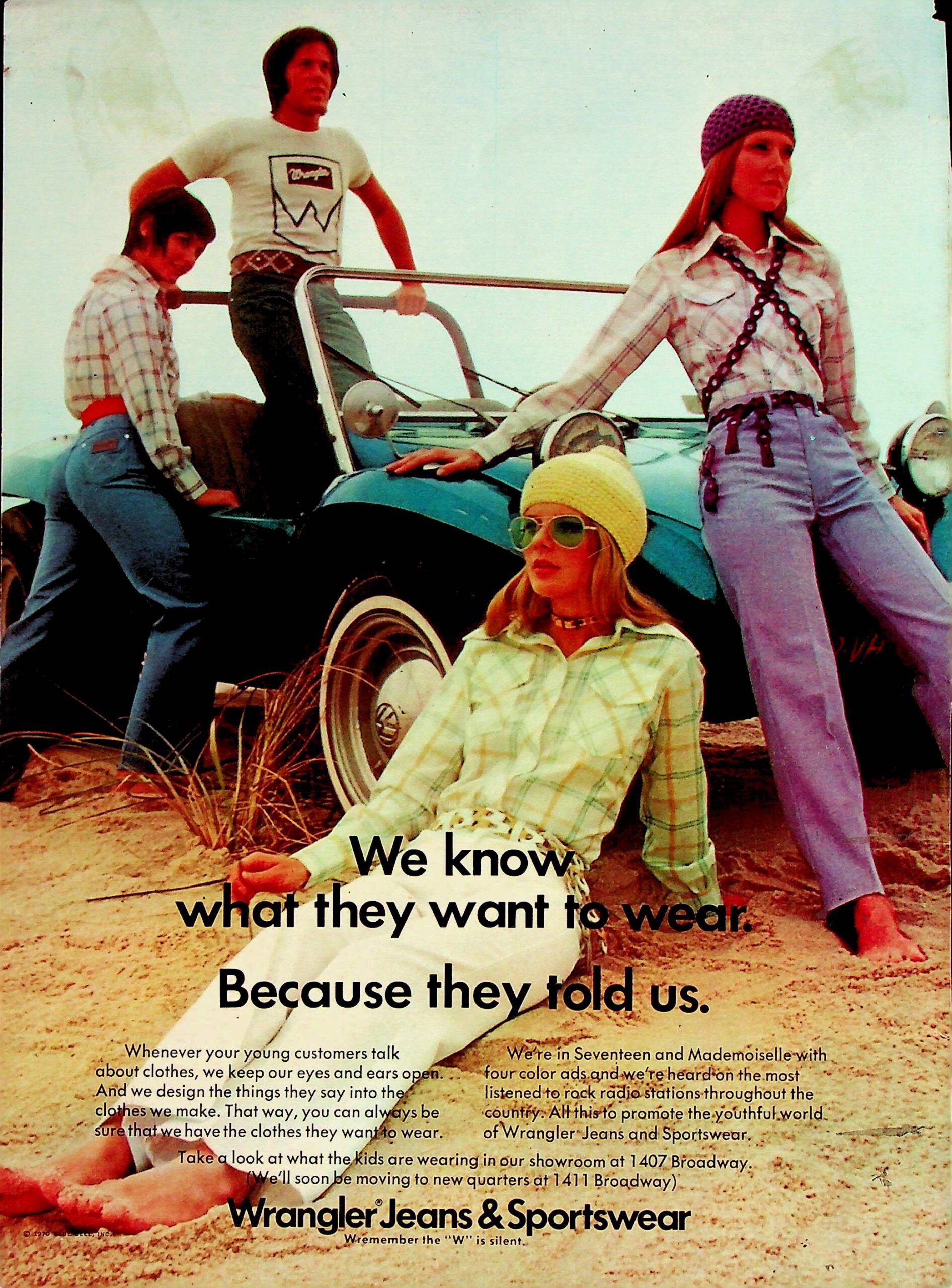
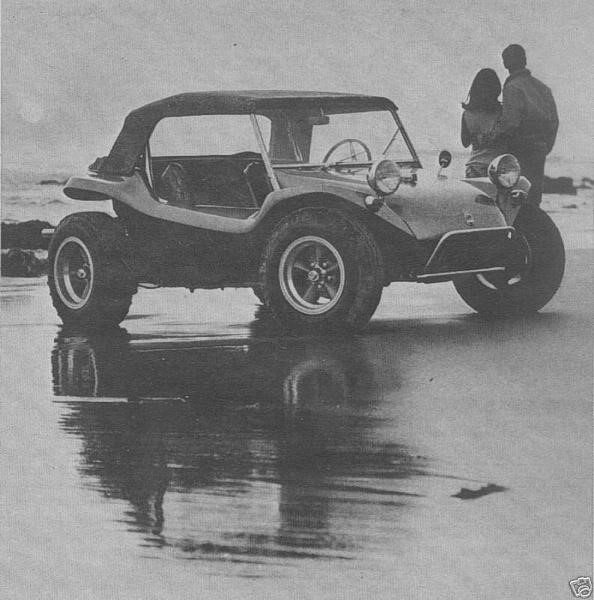
The news would have little relevance, except for the point of view of fans of the Beach Boys and the 'surfin' lifestyle of the '60s and' 70s, were it not that Bruce F. Meyers made this decision at the beautiful age of 94 years, after spending 56 years at the helm of his company.
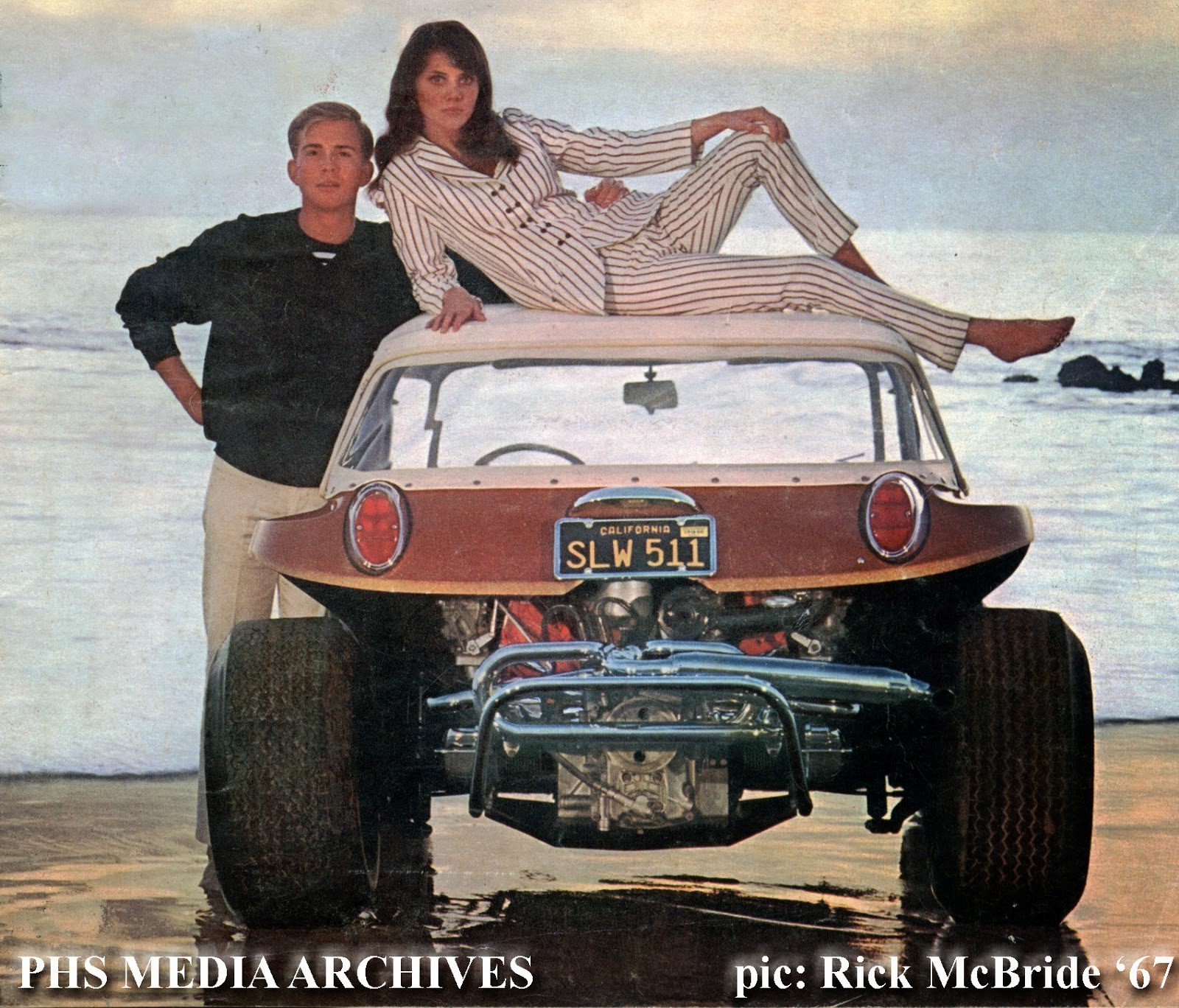
Manx 1967.
The first buggy, built like all subsequent ones on the chassis of the Volkswagen Beetle, was launched in 1964. Although the total number of Meyers Manx built is not known (we are talking about 6,000 specimens but they are probably many more as mounting kits were not listed as new cars), the model designed by Bruce F. Meyers was certainly one of the best known and most appreciated.
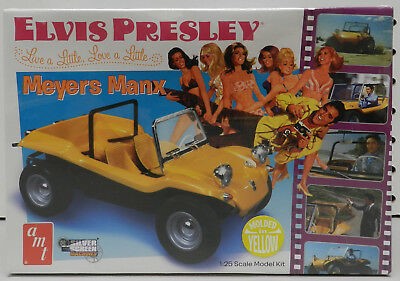
Yellow Elvis Presley Meyers Manx Volkswagen Dune-Buggy.
Fans of this strange but funny type of car include Steve McQueen, Elvis Presley, Terence Hill and Bud Spencer. Notably Steve McQueen and Faye Dunaway drove a dune buggy with a 6-cylinder Chevrolet Corvair engine in the 1968 film 'The Thomas Crown Affair', while Presley appears behind the wheel of a buggy in the film 'Live a Little, Love a Little'. And it is famous the presence of a red dune buggy (built in Italy by Puma) that Terence Hill and Bud Spencer drive in the movie 'Watch out, we’re mad'. The soundtrack of this 1974 film, by Oliver Onions, perfectly expresses the enthusiasm that a vehicle of this type could arouse: 'I feel like a king in my Buggy. / Just the crown is missin’, but that's alright. / Come on people, come on my Buggy. / Come and feel the power of a starry night''.
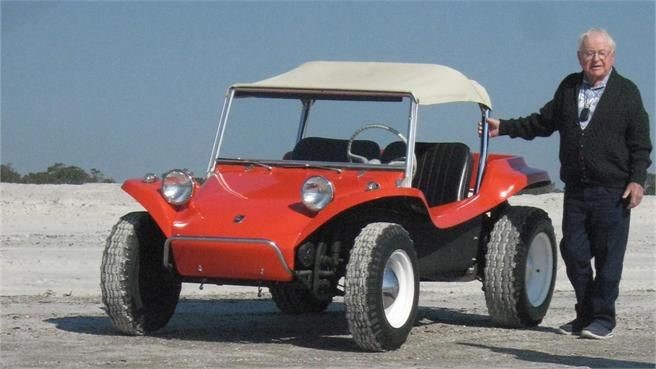
The Meyers Manx company has found new ownership for the first time. Bruce Meyers has officially sold his decades-old company to an investment firm called Trousdale Ventures. Bruce (pictured above) ran the company with his wife, Winnie, from the beginning in 1964.
Thankfully, Trousdale Ventures (owned by Phillip Sarofim, a billionaire, venture capitalist, car collector and racer with a passion for cool cars) is putting the company into the hands of some capable folks. The new CEO and chief creative officer is Freeman Thomas, a former designer at VW, Porsche and Audi. Some of his more iconic designs include the concepts for the new Beetle and Audi TT. He even spent some time at Daimler Chrysler designing some especially American icons like the Dodge Charger and Chrysler 300 with Ralph Gilles.
We called Thomas at home soon after the announcement.
“I have a lot of reverence for what Bruce created,” he told Autoweek. “It transcends being this four-wheeled thing. It’s a pop culture icon.”
The new company will be headquartered in a purpose-built building in the beach city of Oceanside, California and staffed with an international roster of designers, fabricators and builders.
It seems everyone is happy about this development. Meyers has been making Manx kits since that first one, called Old Red. He and wife Winnie are said to be delighted with this new development.
Bruce Meyers released a joint statement on Facebook with the new owners about the selling of the company: "it is with great pleasure and happiness that Winnie and I would like to introduce you to the new future of Meyers Manx. Maintaining the old and introducing the new is what lies ahead. We feel that Meyers Manx LLC can and will do just that! With faith in their desire to continue our legacy, the future will be brighter, happier, sunnier than ever, a wonderful rebirth for what we have created!"
Bruce and Winnie are not entirely separated from the company yet, though. The two will continue on as ambassadors and manage the Meyers Manx Registry, too.
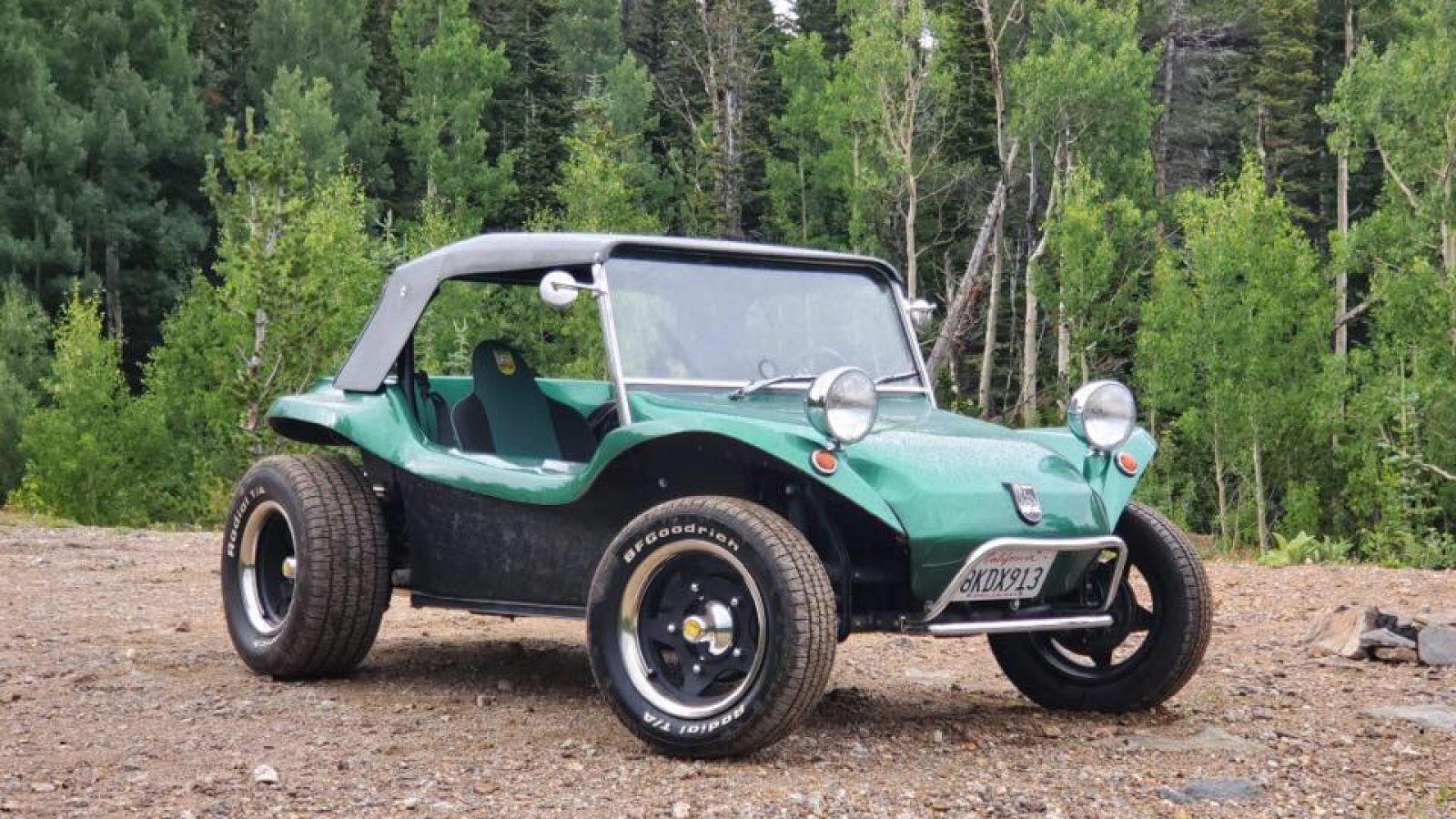
Beyond stating that it will continue the Meyers Manx legacy, Trousdale Ventures hasn’t revealed what it plans to do for new products yet, but a brief statement leaves us assured it will continue on with a similar philosophy as before. Expect Volkswagen chassis and who knows, maybe even something electrified?
“We are putting together an international dream team of passionate and creative souls to carry on the Meyers Manx legacy of fun, freedom and expression that Bruce and Winnie created,” Sarofim said. “The time is right for us all to get back to basics and simplify our lives! That is what Meyers Manx is all about! It celebrates authenticity, diversity and being a little different. It’s the beginning of an exciting journey in bringing new life to a legendary California icon. The timeless design and DNA of the Meyers Manx is the greatest smile machine I’ve ever experienced.”
Without getting specific, Thomas said there are definite products afoot, including some with battery electric power.
“I do I have a lot of ideas,” the former VW, Audi and Porsche designer said.
The products will be built on Volkswagen chassis, just like the originals. That will make the creations affordable to a wide audience, or “accessible,” as Thomas said, but it will also get the company around cumbersome and expensive Federal safety standards.
“At same time we are very conscious about safety and we are going to make the safest car we can make,” Thomas said.
Whatever the new company makes, it will be identifiable as a Meyers Manx.
“Part of it is processing the DNA so that whatever you come up with is going to be authentic, using the best processes we have,” Thomas said.
Looking forward to seeing what that is.
Of course, Volkswagen itself has recently shown interest in the original dune buggy by producing the ID Buggy Concept. We saw it at the New York Auto Show in 2019, where the company invited both Bruce and Winnie to witness the recreation of their buggy in electric form.
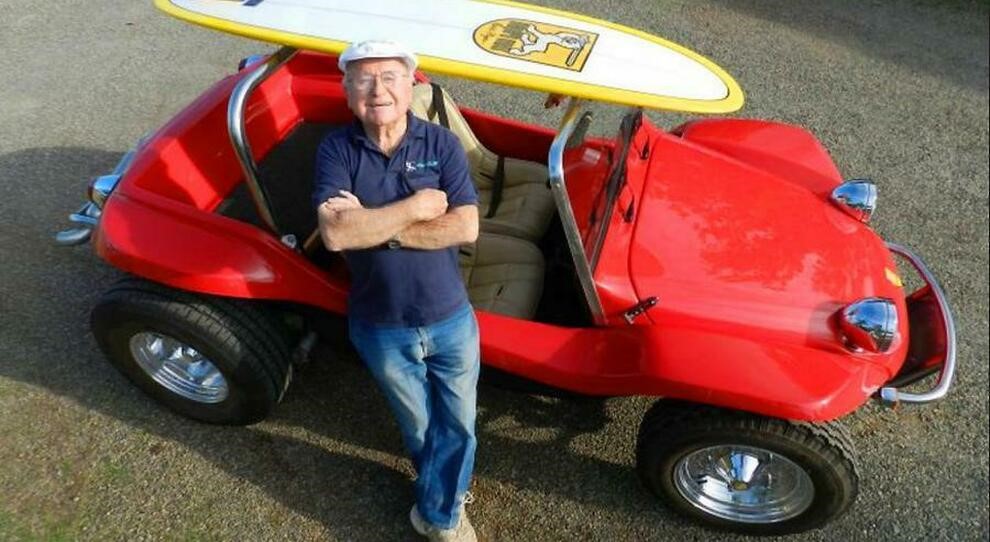
An unsung designer, an iconic design: Bruce Meyers and the Meyers Manx. January 1, 1970.
It’s every designer’s dream to come up with “the” iconic shape for a product category. Bruce Meyers did it back in the 1960s. Through a very random series of events, Meyers mastered a new production method, applied it creatively to an emerging group of objects and created what may be the ultimate manifestation of that object to date.
There are several design and business lessons in his story. Let’s dive in.
Background.
In the first half of the 20th Century, automobiles were still manufactured by human beings. Since anything bolted together by a factory worker can be unbolted by a consumer, it was just a matter of time before people started hacking cars.
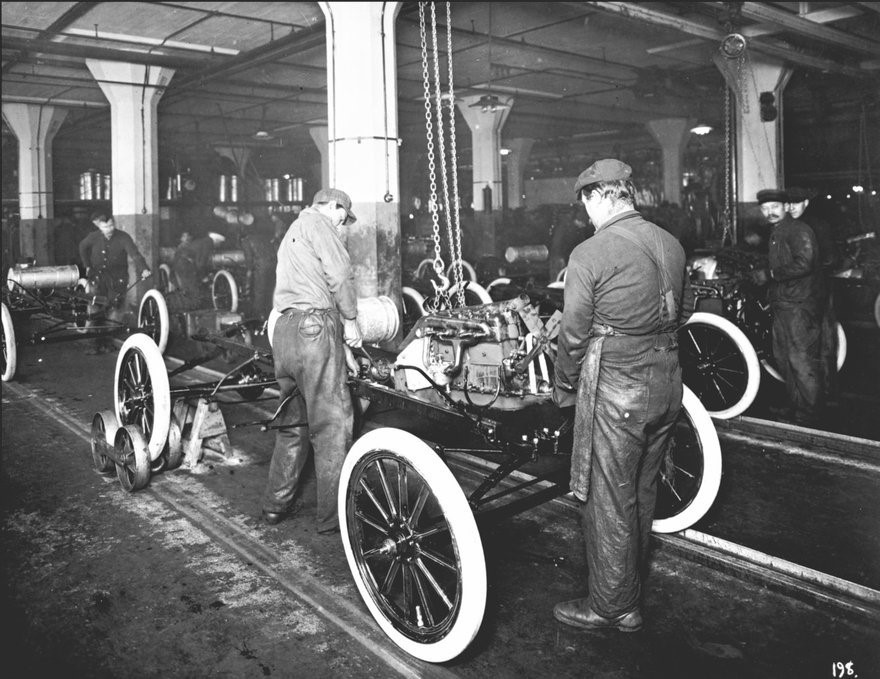
By the 1930s, if you wanted a fast car, there were manufacturers happy to sell you one. But as America was coming out of the Depression at the time, a handful of thrifty, mechanically-minded folk preferred to build their own swift rides out of spare parts. Ford Model A’s, B’s and T’s were plentiful and by cruising a junkyard, you could harvest enough unwrecked parts of these commonplace rides to Frankenstein together your own.
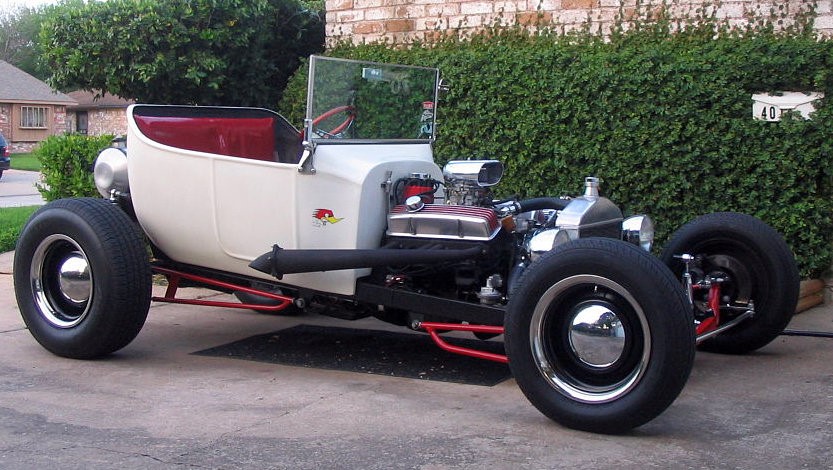
Image credit: Tfeverfred, Creative Commons Attribution-Share Alike 3.0 Unported.
And if you’re going to cobble your own car together, why not modify it a bit? A movement originating in southern California embraced this idea, wedging enormous engines into tiny cars, adding fatter wheels, modifying the bodies, adding fanciful paint jobs. They’d then race each other in the streets or even dry lakebeds for bragging rights. The “hot rod” subculture was born.
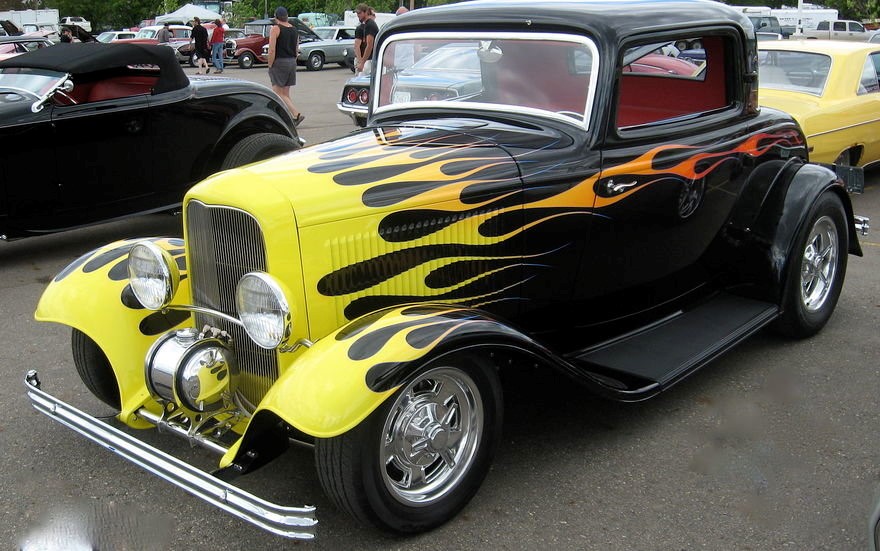
Image credit: Trekphiler, Creative Commons Attribution 3.0 Unported.
Just add sand.
In the decades that followed, the hot rod gained a weird cousin: the dune buggy. In several scattered pockets of the country – Idaho, Oklahoma, Michigan, southern California – people began hacking old cars not for street speed, but for cruising around on the sand dunes present in those regions.
Driving through sand, with no demarcated road lines, was fun. It was also challenging, with traction being a major issue. Four-wheel-drive was a rare luxury, so clever methods had to be developed to give more common rear-wheel-drive cars some decent grip.
Jeep and tractor tires were experimentally added. The driver’s seat, which was often little more than a crude DIY bench, was moved all the way back to the rear axle, to put the driver’s weight directly over the drive wheels. The sheer weight of a car would lead to it being bogged down in the sand, so to shed pounds body panels were removed, roofs were cut off. (Primitive roll bars were sometimes created by harvesting the handrails from swimming pools).
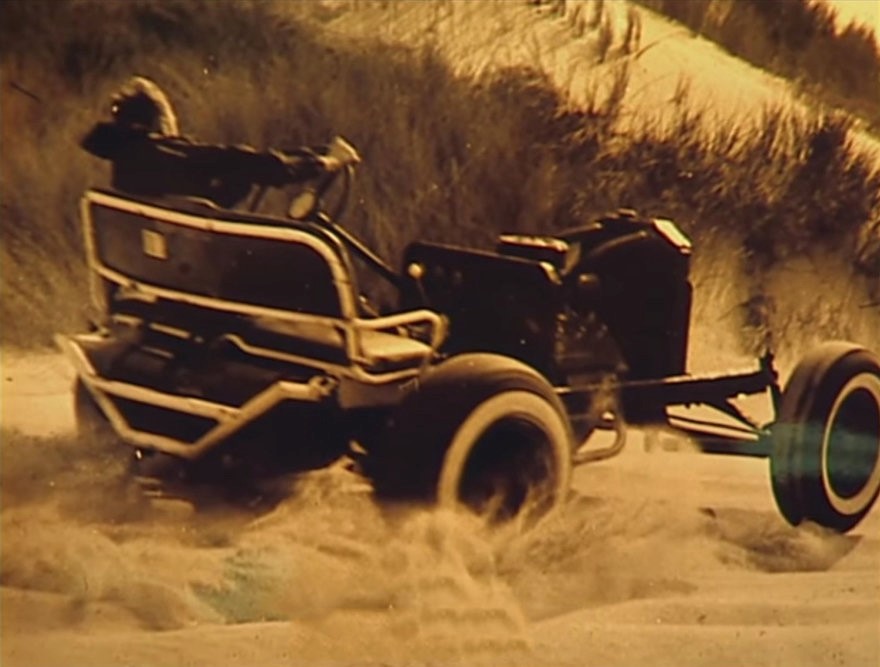
As dune buggies began (literally) gaining traction in the ’50s and ’60s, a southern Californian hot-rodder and art student named Bruce Meyers was watching them buzz past him on the beach. “I’d surf, smoke a little grass, go to art school, race a ’32 Highboy Ford at the [Bonneville] lake beds, chase pretty girls and hang out in Pismo beach, watching the water pumpers [named after their water-cooled engines] – the first dune buggies,” Meyers told “Top Gear”.
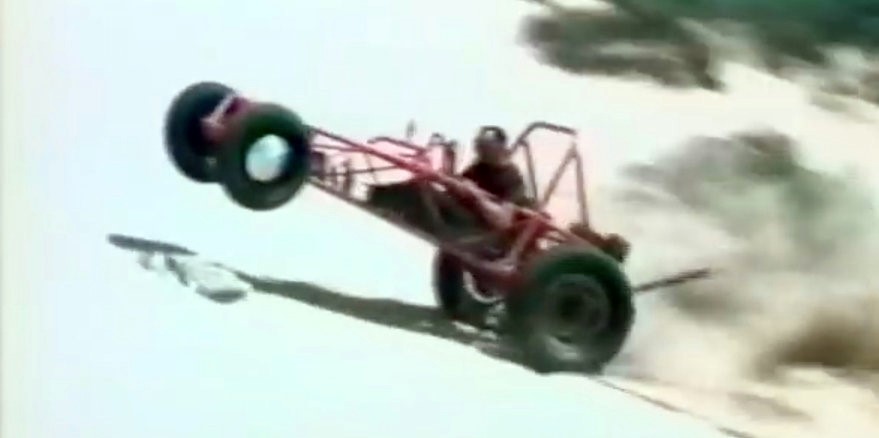
These “Mad-Max” hack jobs could do the work, but they were ugly, the domain of dedicated motorheads unconcerned with any aesthetic philosophy. Body panels were removed or frames were welded up from scratch, yielding artless metal skeletons. “I despised what they were doing,” Meyers said in a 2005 interview. “I liked their function, but I didn’t like their looks.”
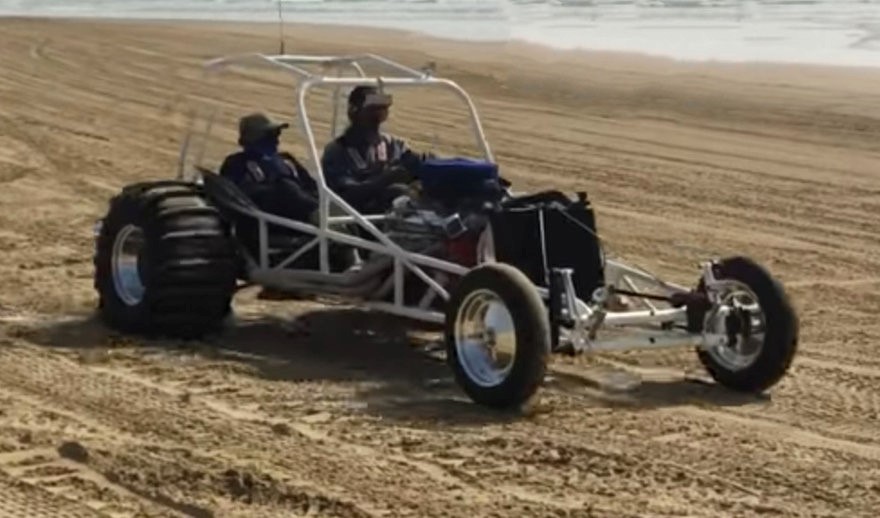
Beach-not-a-bum.
Meyers could be called a beach bum, if he wasn’t so darn productive. To give you some insight into his personality: when he was a child, one of his brothers drowned to death at the beach. His family subsequently forbade all of the Meyers children from ever swimming in the ocean. Meyers couldn’t resist the lure of the water and snuck back to the beach constantly. On the sly he even became a licensed lifeguard, ensuring that not only would he not drown, but he’d be able to help others at risk.
That training was put to the test during World War II. Meyers was a naval gunner on the aircraft carrier “Bunker Hill”, which sustained two direct hits from kamikaze airplanes within 30 seconds of each other. The order was given to abandon ship and Meyers made the 50-foot jump into the water. Not needing it, he pulled his life jacket off to give to a floundering sailor; he subsequently grabbed a badly burned pilot in the water and swam the man to a nearby destroyer for rescue.
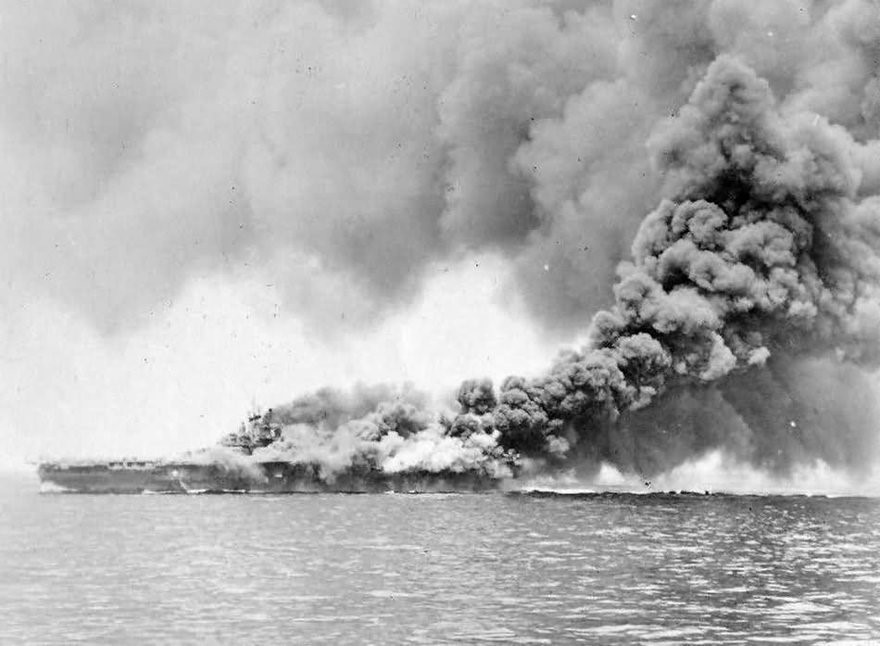
After the war, Meyers – who was handy with tools – was hired as part of a construction crew to build a trading post in the South Pacific. While living in Tahiti, he got a gig as a ukulele player with the local music radio station. He also mastered the sailing of the outrigger boats used by the natives.
Upon his return to California a couple years later, he began building his own catamarans, which were eventually spotted by a fellow named Jack Jensen.
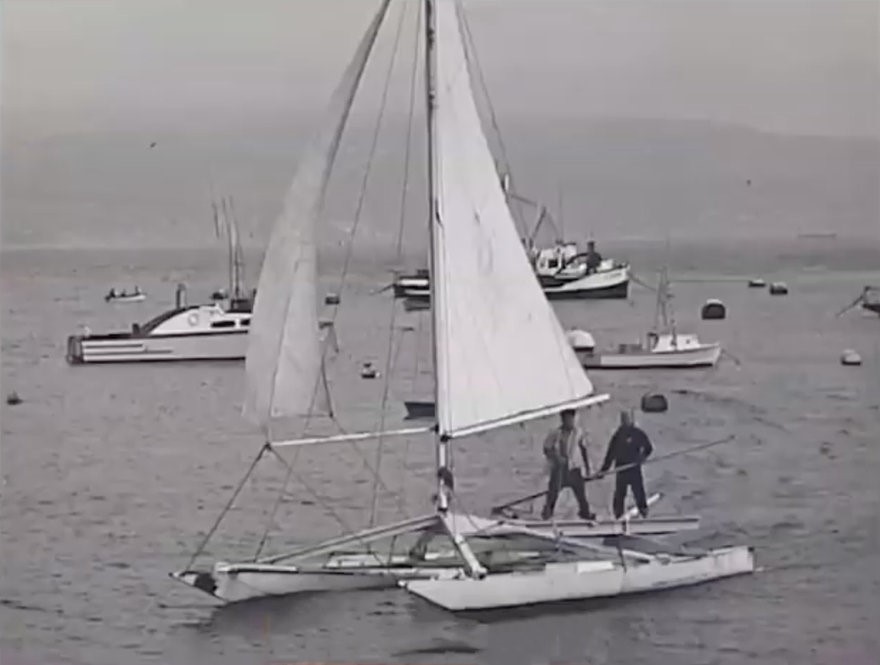
Learning to use a fancy new material.
Jensen was the founder of Jensen Marine, a major manufacturer of sailboats. After spotting Meyers’ work, “Jack said, ‘I need somebody that can do tooling,'” Meyers recalled. “He says ‘why don’t you come work for me?'”
Meyers took the job and soon began producing boats for Jensen. But these weren’t shaped from wood, like most sailboats. Jensen Marine, formed in 1957, was using a newfangled material known as glass-fiber reinforced plastic. Lightweight, yet stronger than a lot of metals, this material could be molded into virtually any shape one desired. Commercially it was referred to as “fiberglass” and it could be shaped in molds, yielding repeatability.
Meyers learned to work the material, becoming a master – a “genius,” “Automobile Magazine” would later write – with fiberglass. On the side he began using it to create his own surfboards and, eventually, a 42-foot catamaran of his own, with the plan of sailing it back to Tahiti. But the boat would take two people to sail and Meyers didn’t yet know that the guy who promised to make the trip with him would eventually flake out.
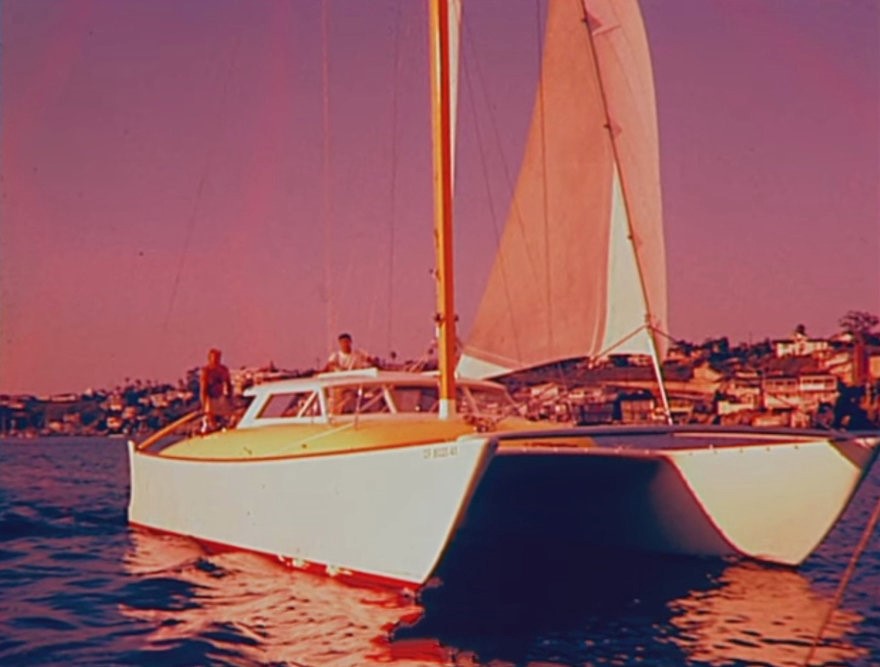
As we’ll see, Meyers would subsequently find another project to sink his time into.
Enter the Beetle.
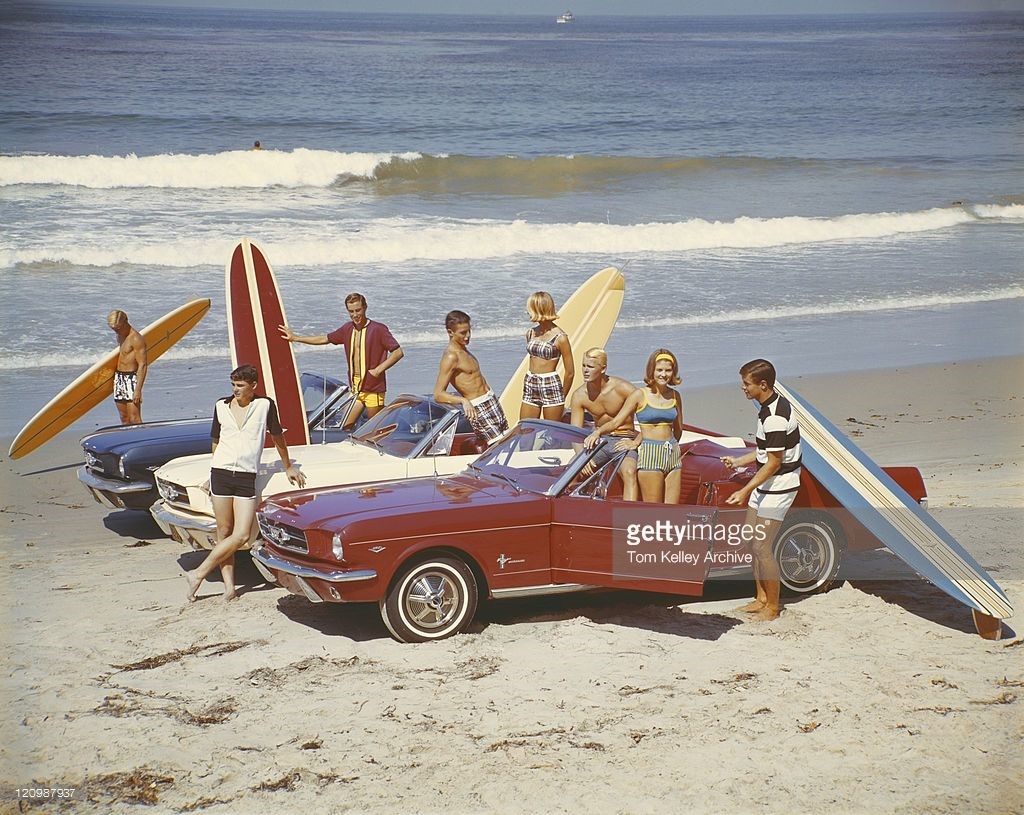
In the 1950s, Fords and Chevys ruled the day. The roads were covered with running models, the junkyards well-stocked with crashed ones waiting to donate parts. For anyone building a dune buggy, the availability of Ford and Chevy parts made them a go-to. They were the cars of the masses.
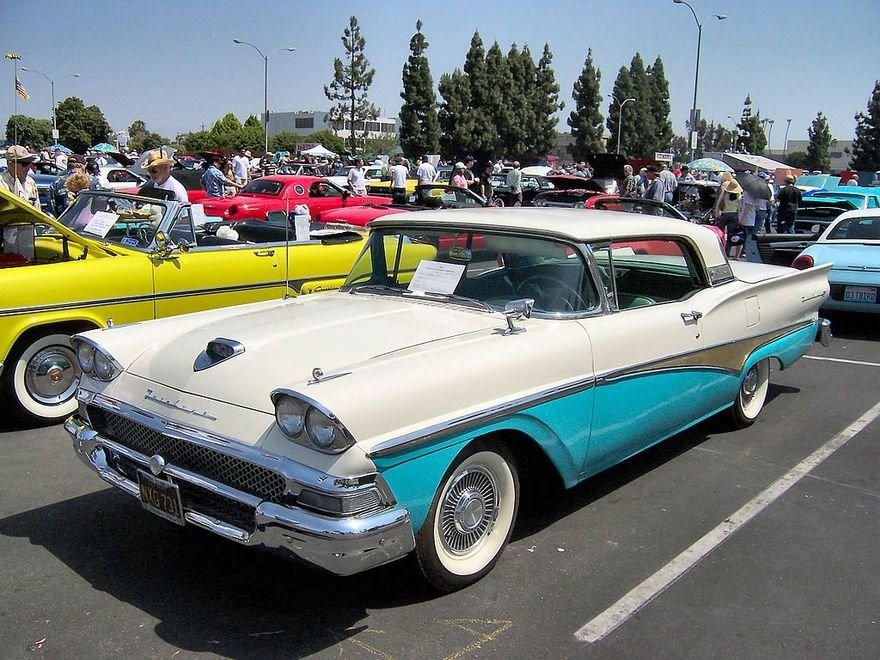
Image credit: Morven at the Fabulous Fords Forever show. Creative Commons Attribution-Share Alike 3.0 Unported.
But another sort of people’s car had begun making inroads in 1950s America. It was a quirky little car from Germany called a Volkswagen Beetle.
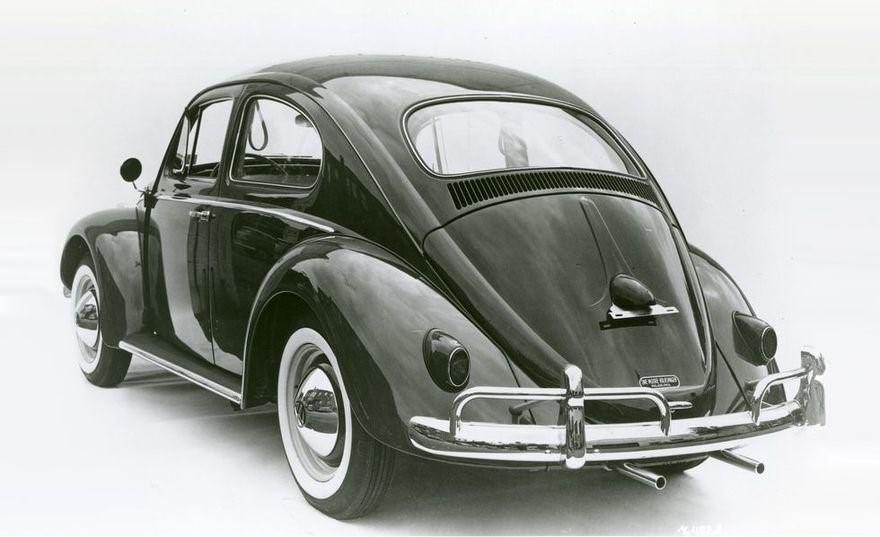
In 1950, just 328 Beetles had been sold.
In 1954, 8,086 units.
in 1957, an incredible 50,059 units and the numbers would continue to climb.
“There is no longer any doubt about it,” wrote “Road & Track” in October of 1956. “Dr. Ferdinand Porsche’s little ‘people’s car’ has done what no other [import] has ever been able to do: it has gained an unmistakable wheel-hold in the garages and hearts of the American car-buying public….”
“… The Volkswagen fulfills a need which Detroit had forgotten… a car that is cheap to buy and run, small and compact, light and maneuverable yet solidly constructed and perhaps, above all, utterly dependable and trouble-free.”
The car still wasn’t “cool”, particularly if you looked at one alongside a 1957 Chevy.
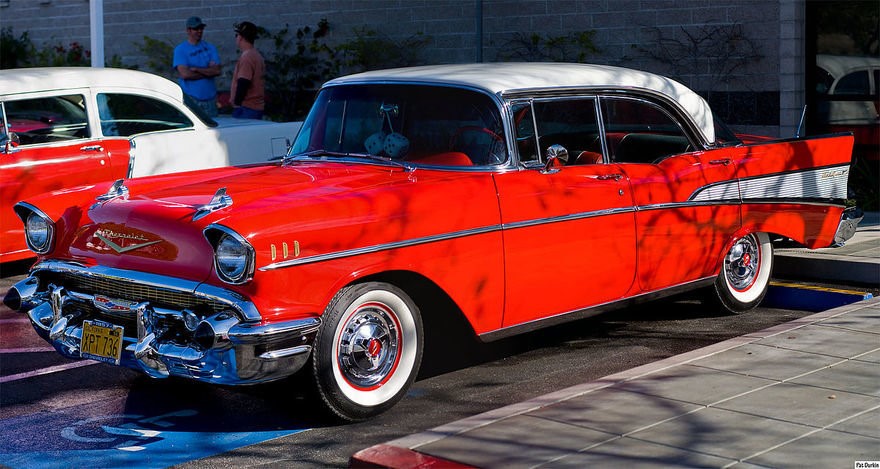
Image credit: Paddyspig, CC BY-SA 3.0.
The Beetle was weird. It was shaped like, well, a bug. It was tiny. It was slow. The engine was in the “back”, for chrissakes, where Americans liked to have a trunk. But in 1960, helped along by a self-deprecating advertising campaign by New York ad agency Doyle, Dane and Bernbach, VW sold 117,868 of these uncool cars in the ‘States.
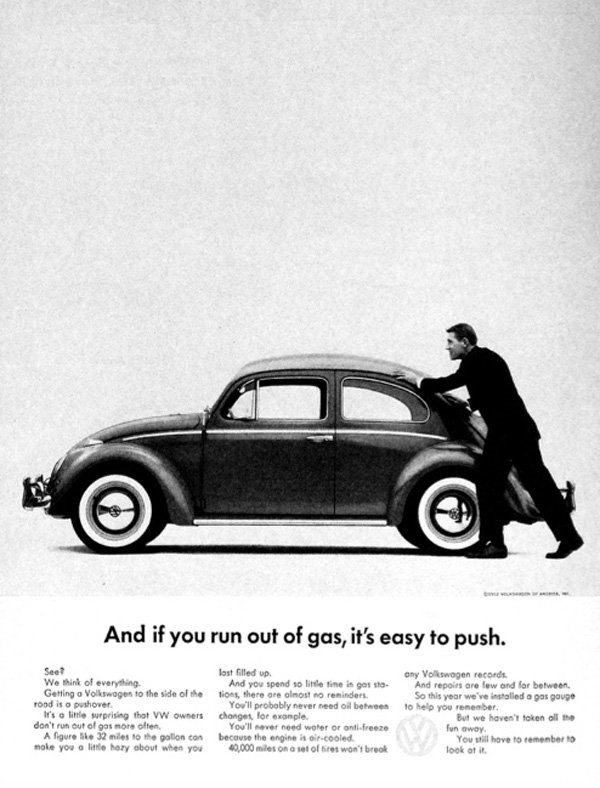
As Beetles proliferated on American roads, one person who took notice was Scott McKenzie, a brilliant race driver and car fabricator based in San Fernando, California. While most would laugh at the idea of a Beetle being involved in any kind of performance driving, McKenzie saw that it would be the perfect dune buggy underpinning. Small. Lightweight. Well-built. Engine in the back, putting the bulk of the weight over the drive wheels. And the Beetle was so cheap – $1,565 in 1960 dollars, about $13,500 today – that buying a brand-new one and stripping it down was a reasonable alternative to crawling around in a junkyard looking for parts to cobble together.
No one had used a Beetle to make a dune buggy before, so McKenzie, a pioneer, became the first (though he did replace VW’s engine with one that GM used in the Corvair).
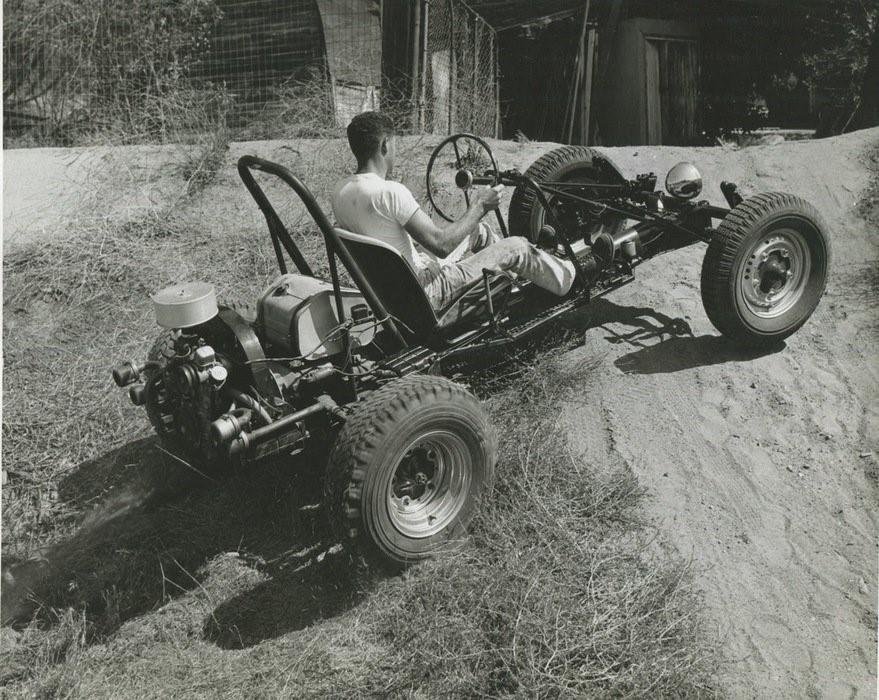
Scott McKenzie’s skinless, modified Beetle….
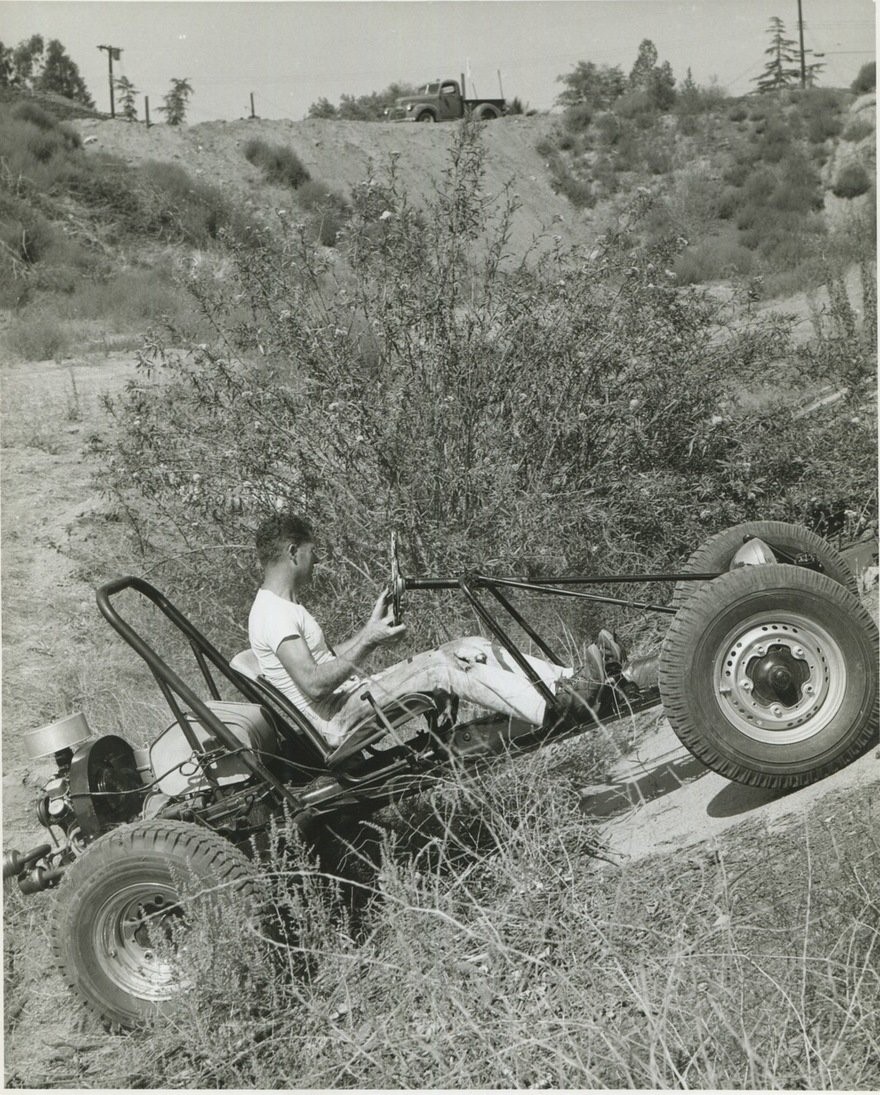
… could go just about anywhere.
In the surest sign that McKenzie’s concept was sound, others began copying him. Beetle-based dune buggies started to proliferate off-road, just as the unmodified ones had on-road. So it was that Bruce Meyers, watching dune buggies on the beach one day, had an epiphany. Most of the vehicles he saw “spat flames and were a lot of fun, but I knew they were inefficient,” he told “Top Gear”.
“Then I saw someone driving a Beetle floorpan. It skimmed around like a mosquito across water, even with 35bhp [horsepower] and four-inch tires. All the weight over the rear end made a lot of sense in the desert. It was why the Mexicans drove around with 50-gallon drums of water in the back of their pickups – the driven wheels got the best chance of traction, because they’re getting pushed down and onto the loose surface.”
No design considerations.
As the Beetle conversions grew in popularity, EMPI (Engineered Motor Products Incorporated), an L.A.-based VW dealership, saw an opportunity to capitalize on them. In the early 1960s they began selling the Sportster, a converted dune buggy Beetle that could be ordered in turnkey or kit form.
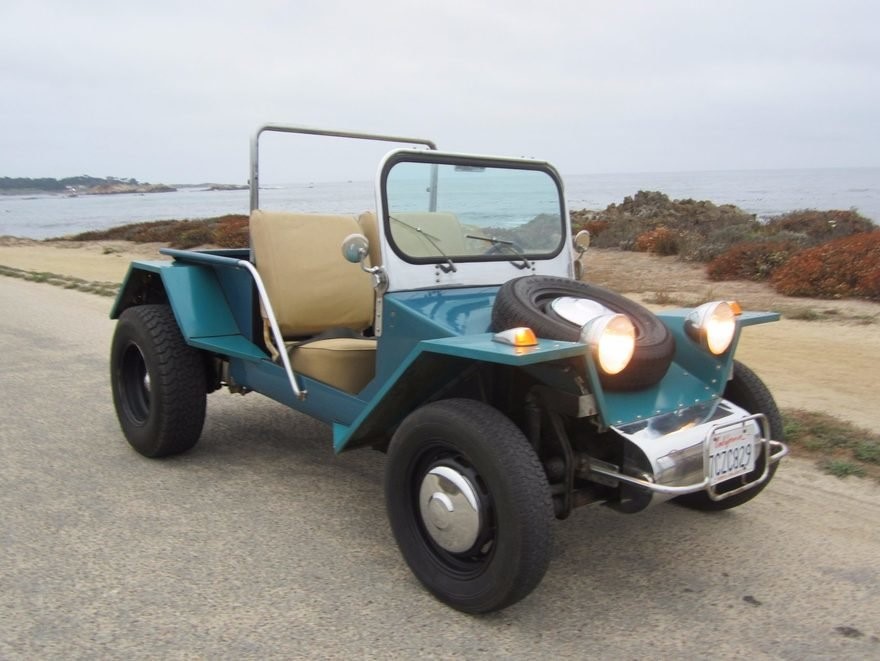
The EMPI Sportster.
So here we come to a phenomenon that roughly divides human beings into non-design-appreciators versus design-appreciators (or stylists, some might say, with some malice). The first group will look at the EMPI Sportster and say “hey, cool dune buggy.” The second group will think “that thing is hideously ugly.” And I’m not talking just about the proportions, I’m talking about the execution.
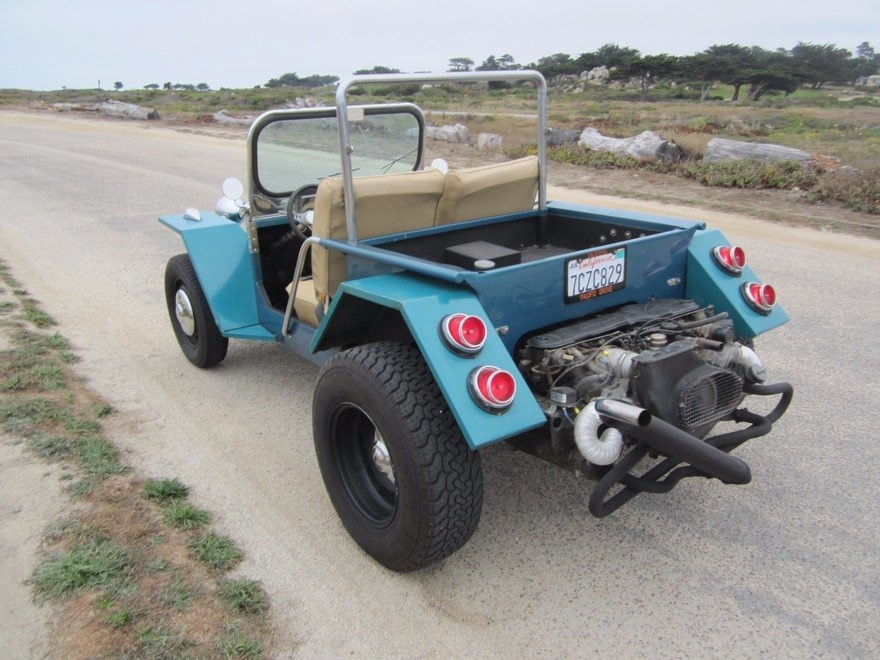
The EMPI Sportster.
Look at the seemingly-random lines on the car.
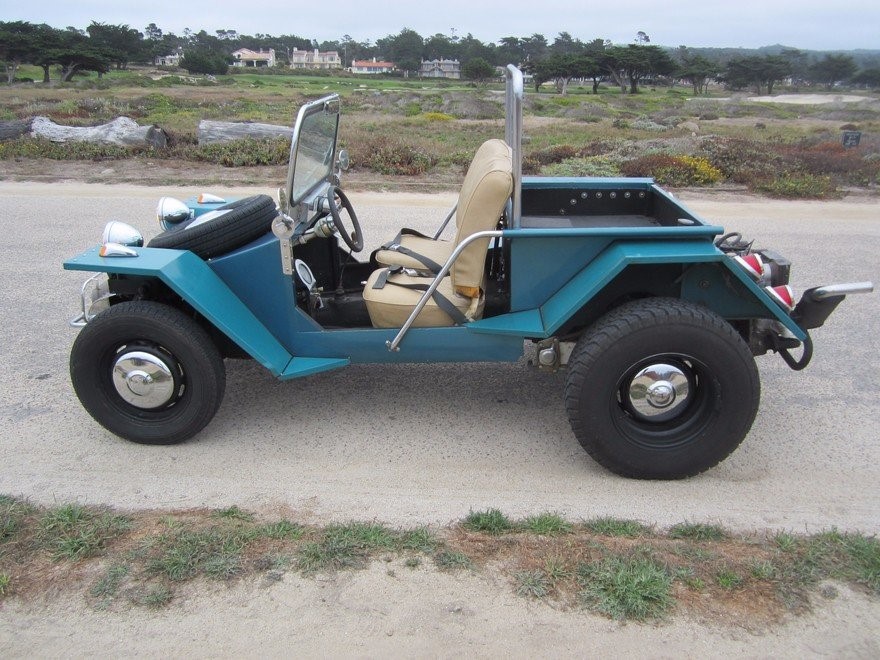
The EMPI Sportster.
Look at the way the flat pieces of sheet metal are assembled.
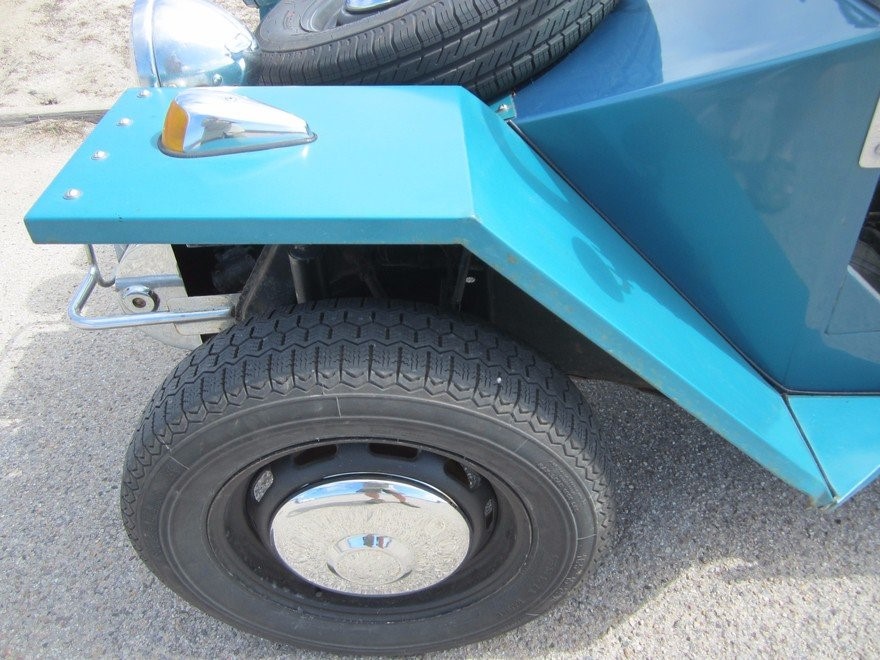
The EMPI Sportster.
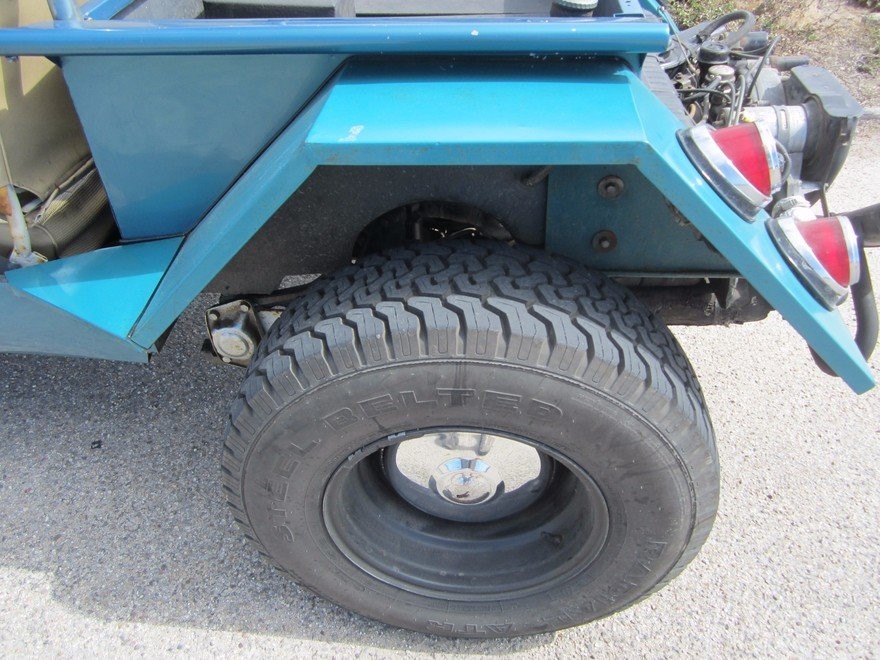
The EMPI Sportster.
It’s utilitarian, sure, but utilitarian doesn’t mean it has to be so artless. Jonathan Ward’s ICON vehicles, for instance, are both utilitarian and beautiful.
Nevertheless, the EMPI Sportster sold enough models that you can still find surviving ones at auctions. But Bruce Meyers wouldn’t be caught dead in one. Instead, in 1963, the beach-not-a-bum resolved to build his own and correct what he saw as the aesthetic flaws of all Bug-based buggies.
Plenty of design considerations (including beer).
“I’m an artist and I wanted to bring a sense of movement and gesture to the [form],” Meyers told “Top Gear”. “Dune buggies have a message: fun. They’re playful to drive and should look like it. Nothing did at the time.”
In a recent article for “Core77”, columnist Chris Schwarz wrote that you should be up front about your inspirations. Meyers was; he told automotive historian James Hale, for Hale’s book “Dune Buggies”, of at least four sources that inspired his creation. As “Hemmings” reports:
“Meyers wanted to combine the Volkswagen Schwimmwagen’s high fenders and short wheelbase, the Volkswagen Kubelwagen’s stand-up headlamps and simplicity, the open design of Italian beach cars and the wide wheels and tires he experimented with on his own Volkswagen Type 2, ‘all added together with a fine artistic sense of style.'”
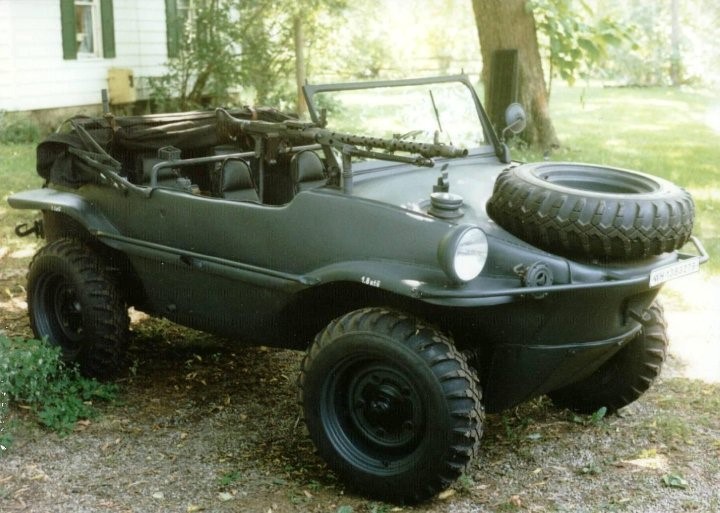
Volkswagen Schwimmwagen. Image credit Oldbug.com.
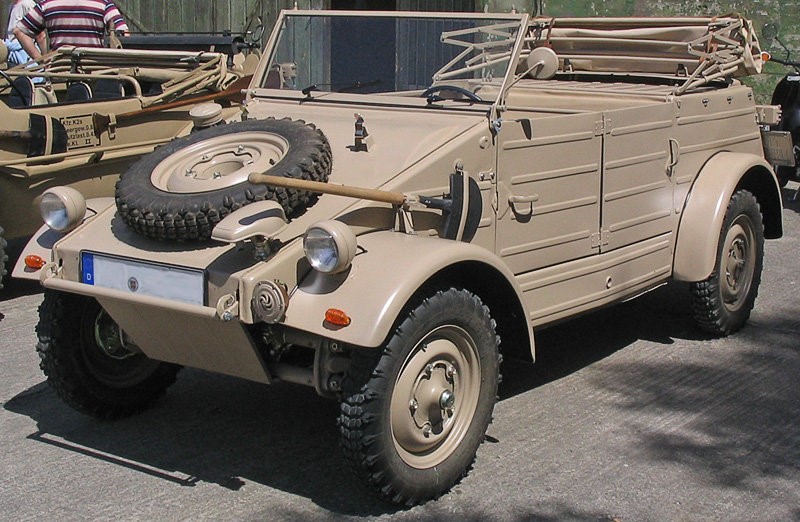
Volkswagen Kubelwagen. Image credit Darkone – Own work, CC BY-SA 2.5.
Meyers then combined those inspirations with his own wants: “the top of the front fenders had to be flat to hold a couple of beers, the sides had to come up high enough to keep the mud and sand out of your eyes, it had to be compatible with Beetle mechanicals and you had to be able to build it yourself.”
What Meyers was not going to do was make the car out of sheet metal. Instead, he turned to his then-rare skillset–forming gigantic pieces of fiberglass – and designed a then-revolutionary monocoque.
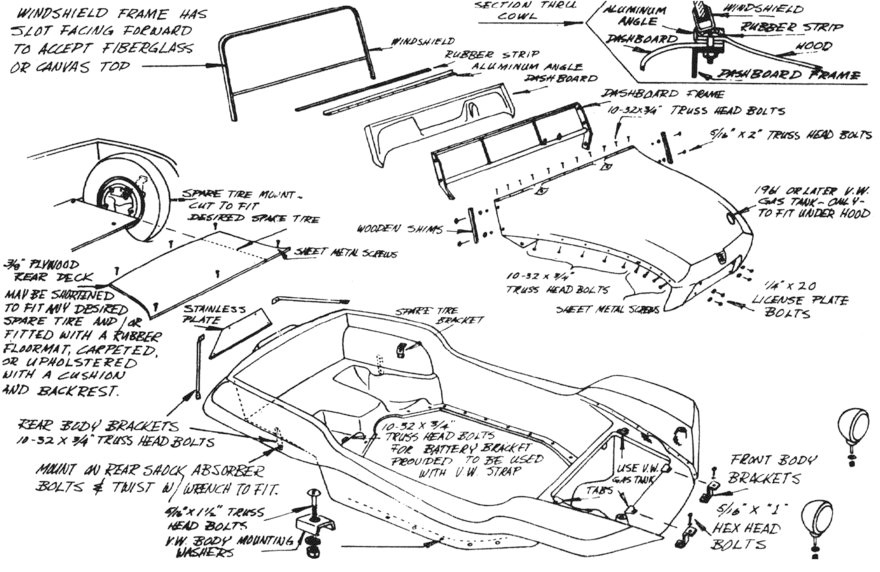
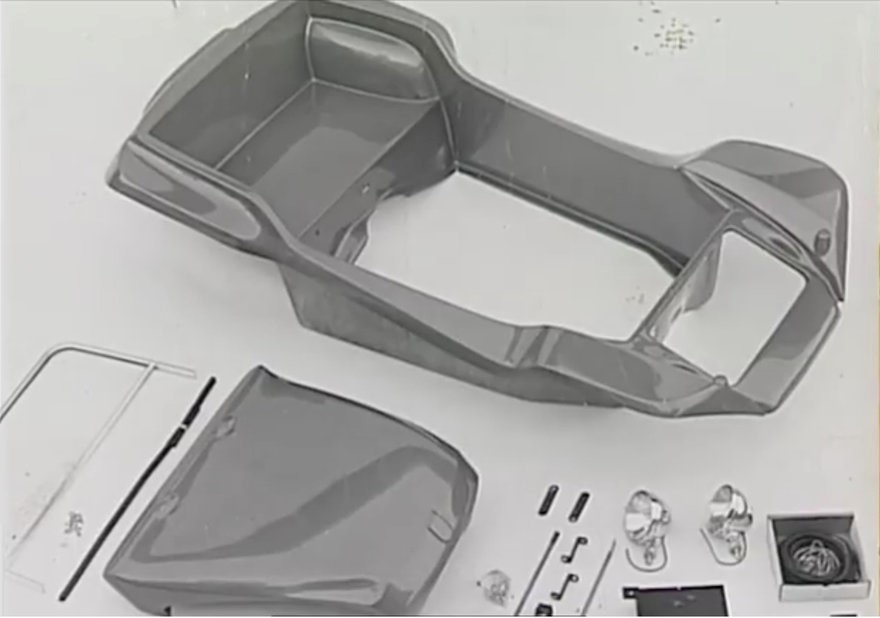
He then set about fabricating the first version in his one-car garage.
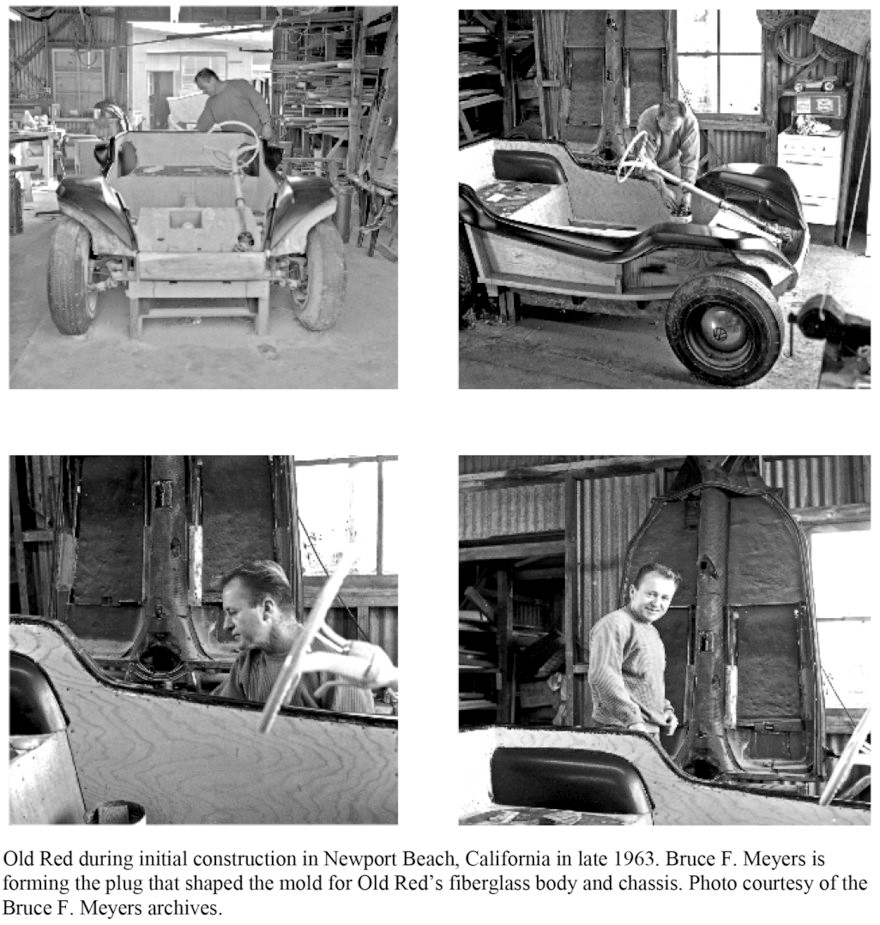
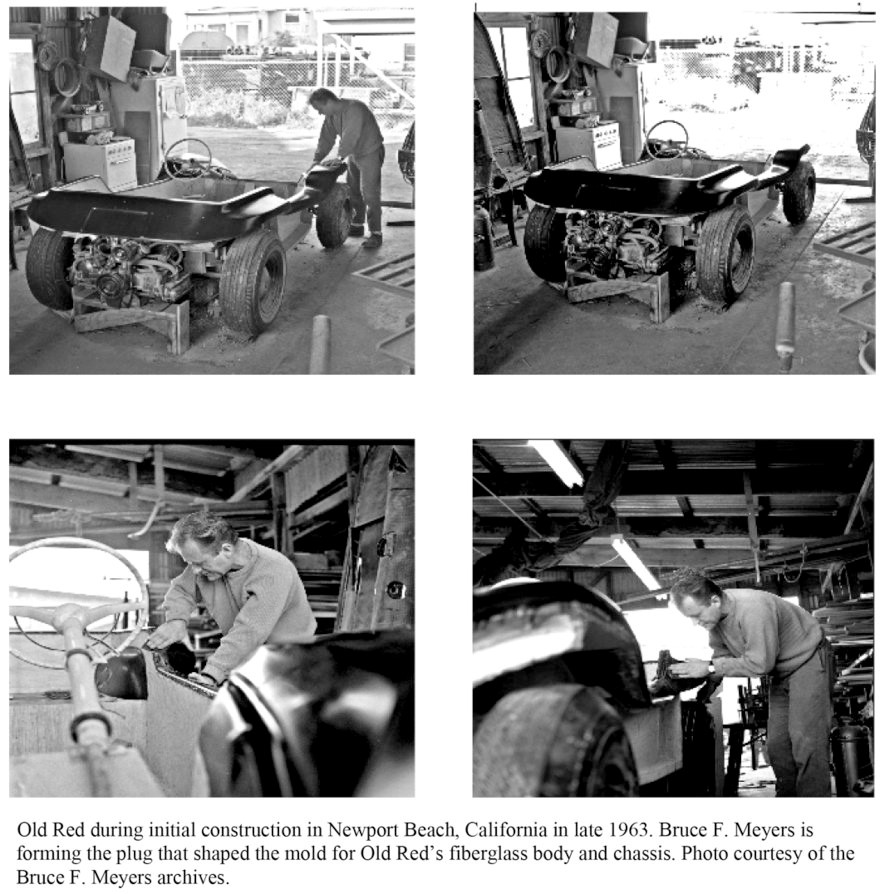
“I added all the line and feminine form and Mickey Mouse adventure I could,” Meyers said of the shape. He completed his prototype in 1964 and it came to be known as “Old Red:”
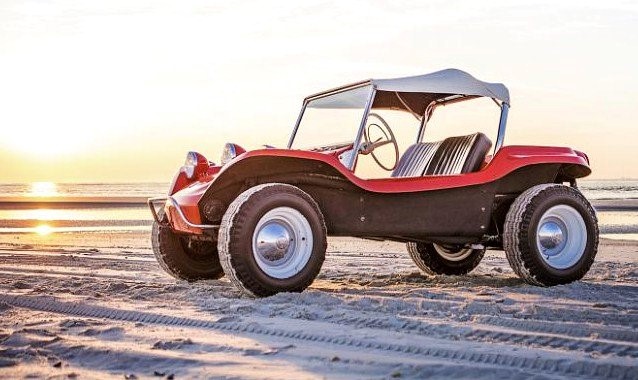
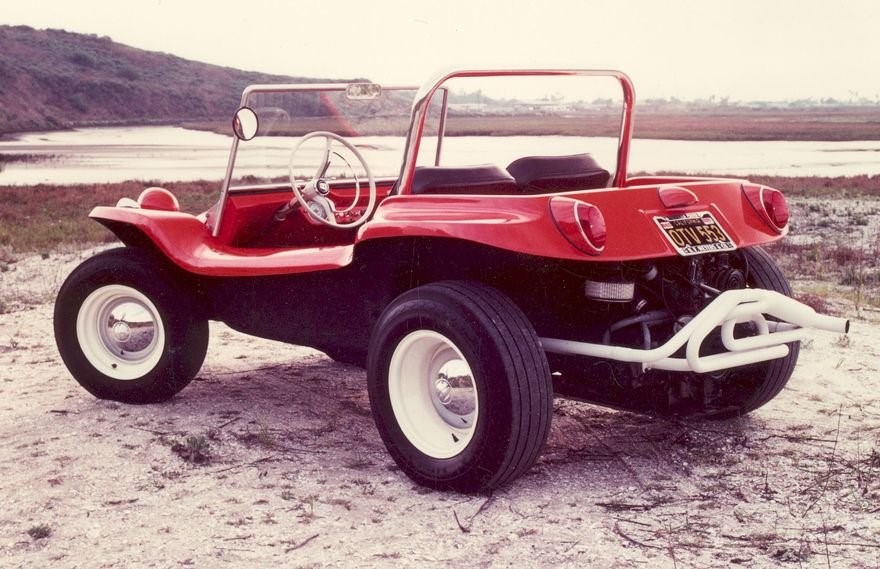
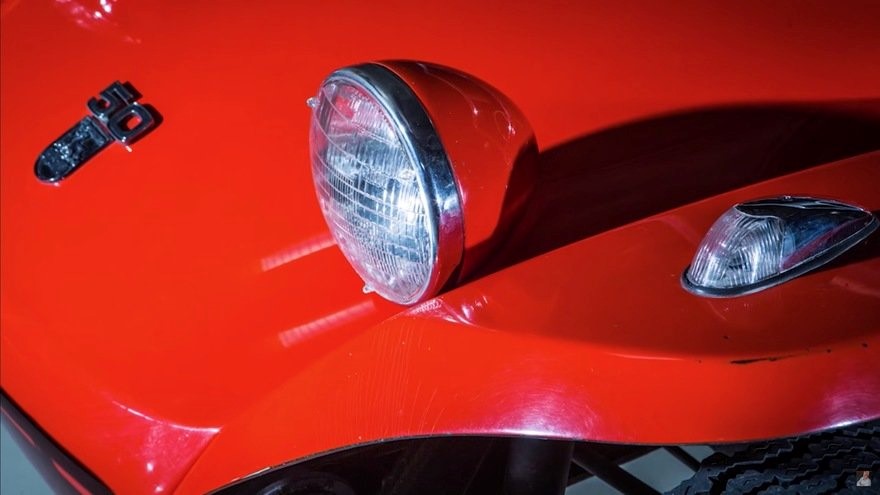
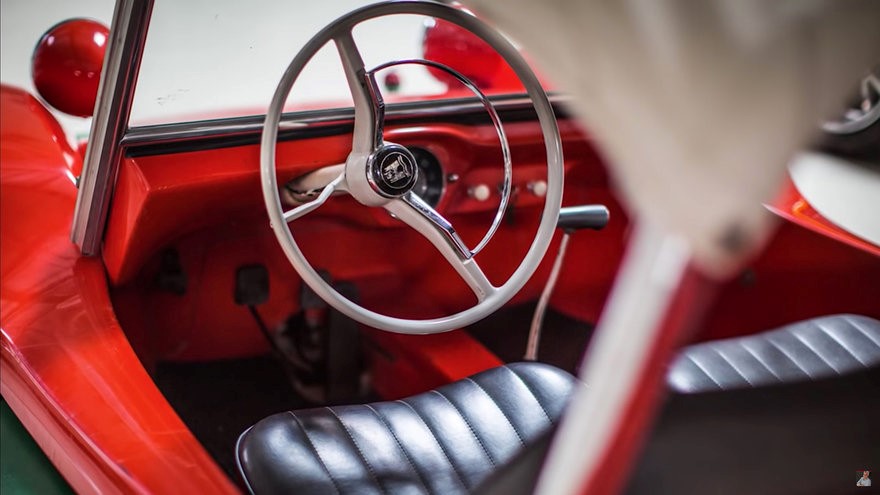
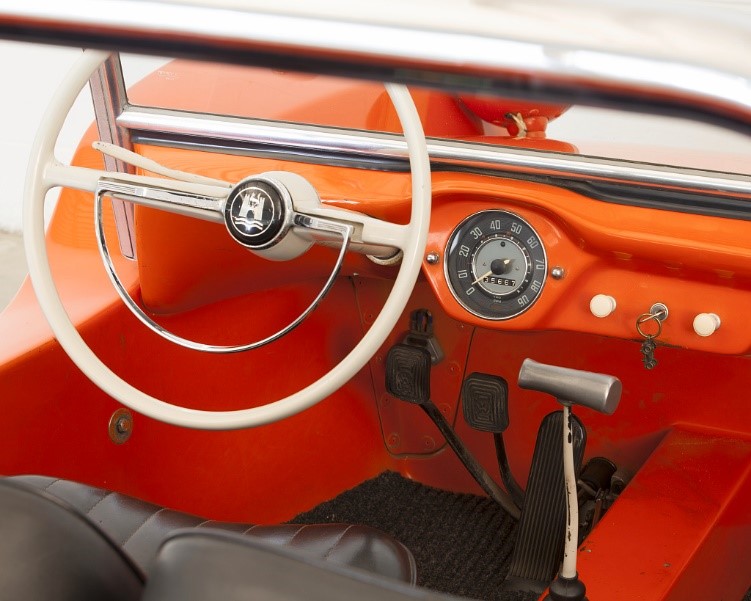
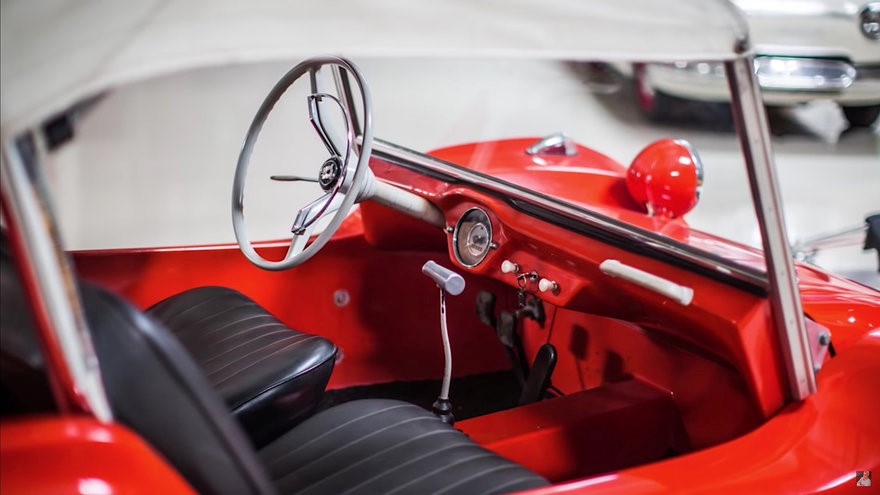
Meyers’ unibody design jettisoned the Beetle’s floorpan altogether. He designed and molded attachment points directly into the fiberglass for the suspension components and engine. Not yet aware of just how strong his design was, “I carried mats, skins and resin [to repair it] because I thought I’d be left on my ass when it snapped on the street,” he told “Top Gear”. “But it was a tough little car and I got more confident with it. I took it to the dunes, jumped it and gave that thing a pounding.”
One of fiberglass’ benefits is that it comes out of a mold. Meyers used his mold set-up to crank out a dozen shells, to sell to dune buggy fans in kit form; he figured he could use the proceeds to cover his initial development costs. Or continuing development costs; Meyers continued regularly whipping the car around to see what it was capable of.
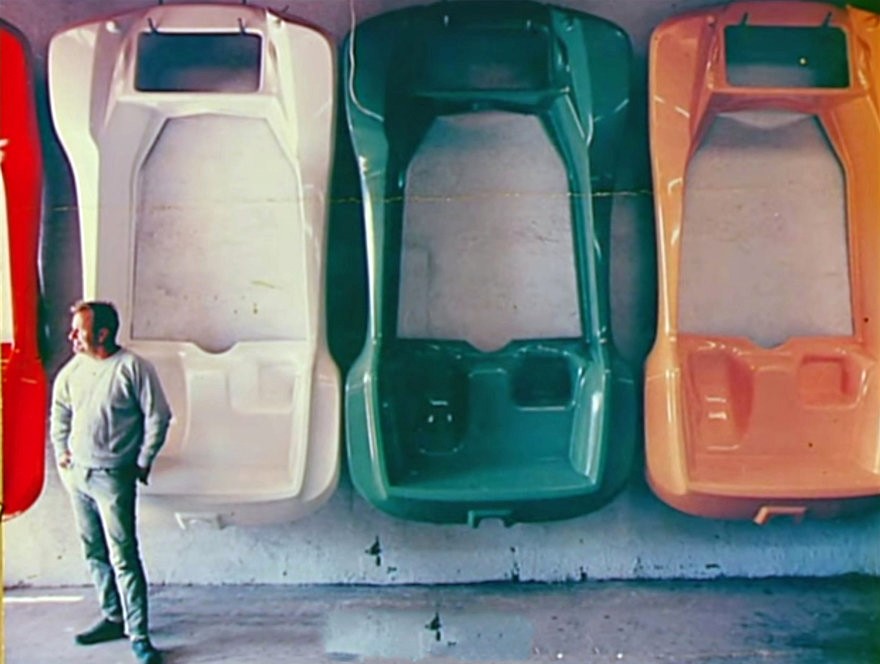
It “looks” good – but can it perform?
While giving Old Red an off-road workout at Big Bear Lake, Meyers and his friend Ted Mangels encountered a bunch of motorcyclists. In the mid-’60s it was widely accepted that off-road motorcycles were the fastest way to travel long distances off-road. Meyers disagreed.
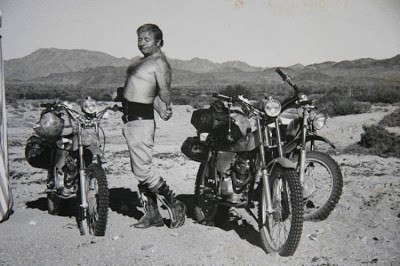
A debate ensued with the bikers and Meyers figured out how to settle it. At the time, dedicated off-roaders would time themselves on drives from Tijuana to La Paz, Mexico. Covering virtually all of Baja, this was an 832-mile route of challenging off-road terrain and motorcycles could blow away any four-wheel-drive vehicle; the fastest motorcycle had done it in 39 hours.
Meyers said his car – which didn’t even have four-wheel-drive – could beat that.
To prove it, Meyers and Mangels, his co-driver, brought the car to Tijuana. They had attached three oxygen bottles to the outside of Old Red, to carry extra fuel. He and Mangels then filled a series of milk bottles with yet more gasoline, which they carried between their legs. If they were going to lose this race, it wouldn’t be because they were waiting for a gas station to open somewhere along the route.
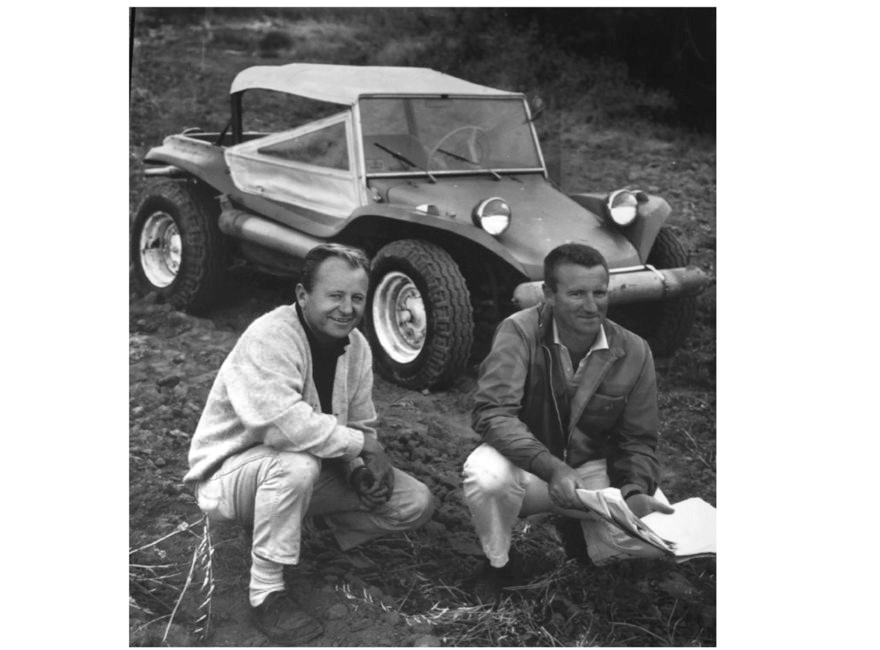
It took Meyers and Mangels a total of 34 hours and 45 minutes of bouncing, jostling and zooming across the Baja desert before they crossed the finish line at La Paz. They had broken the motorcycle record by nearly four hours.
The Manx craze.
After Meyers’ triumphant return home his wife, Shirley, who worked in the advertising department for “Road & Track”, began writing letters to car magazines describing Bruce’s feat. She also asked fellow “Road & Track” employees what they thought the car ought be named.
Several present said the car reminded them of a manx, a breed of cat with a stubby tail. Elaine Bond, who ran the magazine with her husband John, agreed and went a step further, saying it should be called the “Meyers Manx.” Elaine also put out a press release titled “Buggy beats bikes in Baja!”
The car was subsequently featured on the cover of “Hot Rod’ magazine:
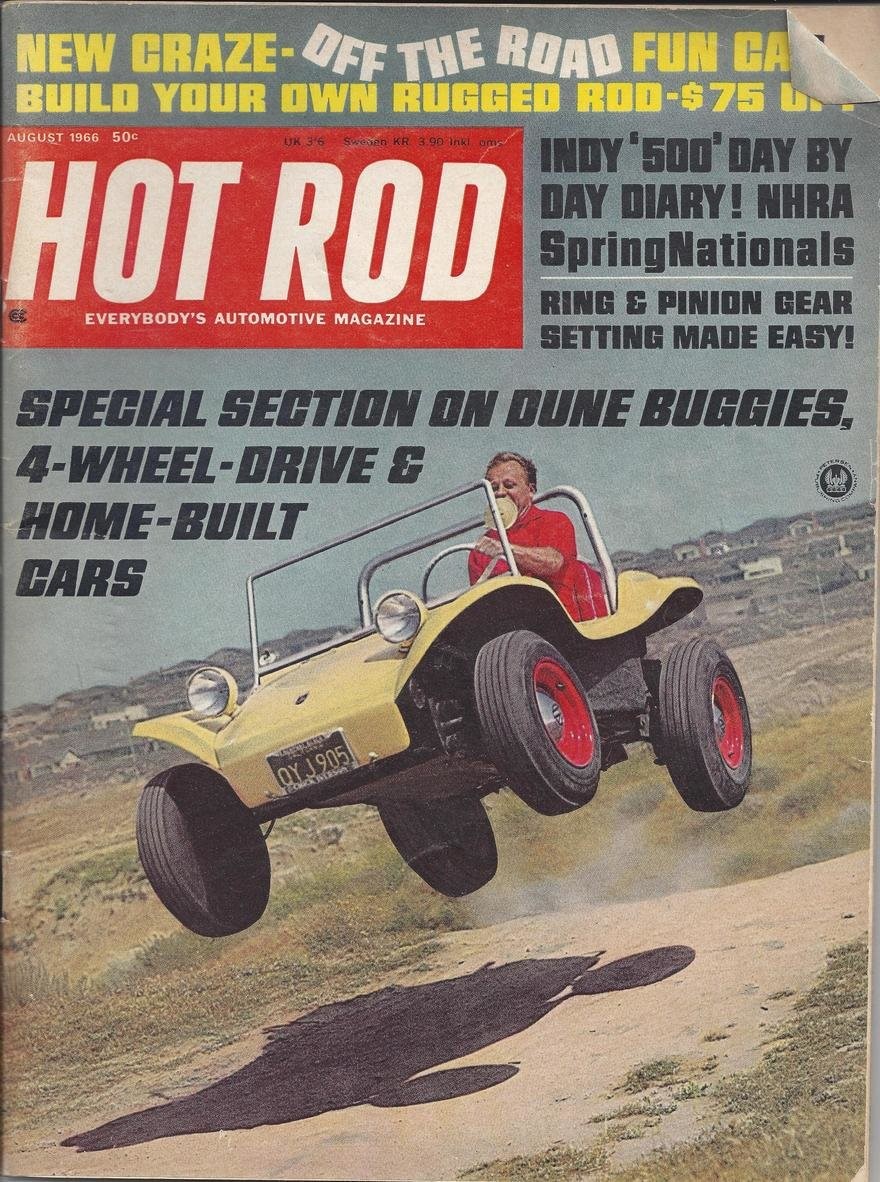
As the Baja story went viral, orders began flooding in for the newly-christened Meyers Manx. Bruce subsequently figured out that if he retained the Beetle’s floorpan but shortened the chassis by 14.25 inches, he could reduce the price of the kit by nearly two-thirds. He now had a hot seller on his hands.

Partially inspired by the Manx’s Baja victory, off-road enthusiasts Ed Pearlman and Don Francisco formed the National Off-Road Racing Association, with the idea of formalizing the Tijuana-to-La-Paz route into an official race. They asked Meyers to help; he was too busy producing Manxes to participate directly, but he fielded several of them for the race.
The first Mexico 1000, as NORRA called it (today it’s called the Baja 1000) was held in 1967. The winner? At 27 hours and 38 minutes, Ted Mangels, driving a Manx.
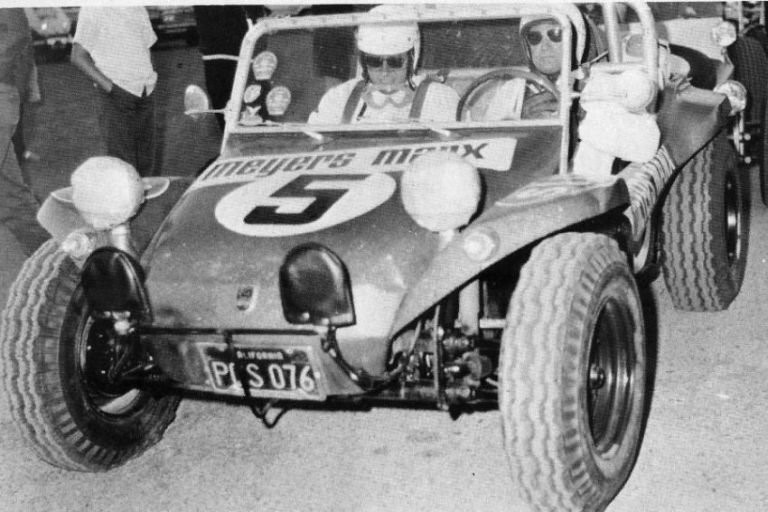
The car’s reputation grew. Steve McQueen drove a modified Meyers Manx in 1968’s “The Thomas Crown Affair,” which didn’t exactly hurt sales.
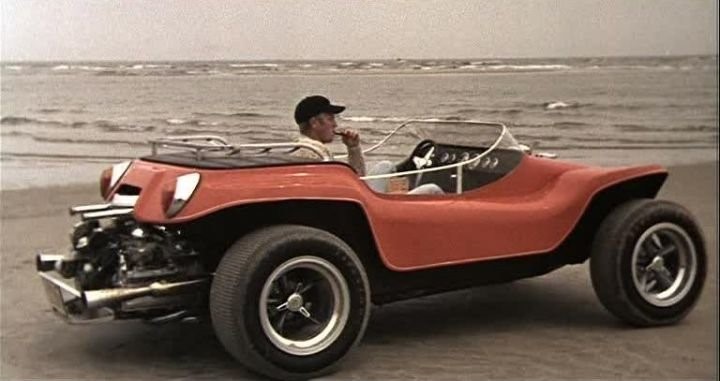
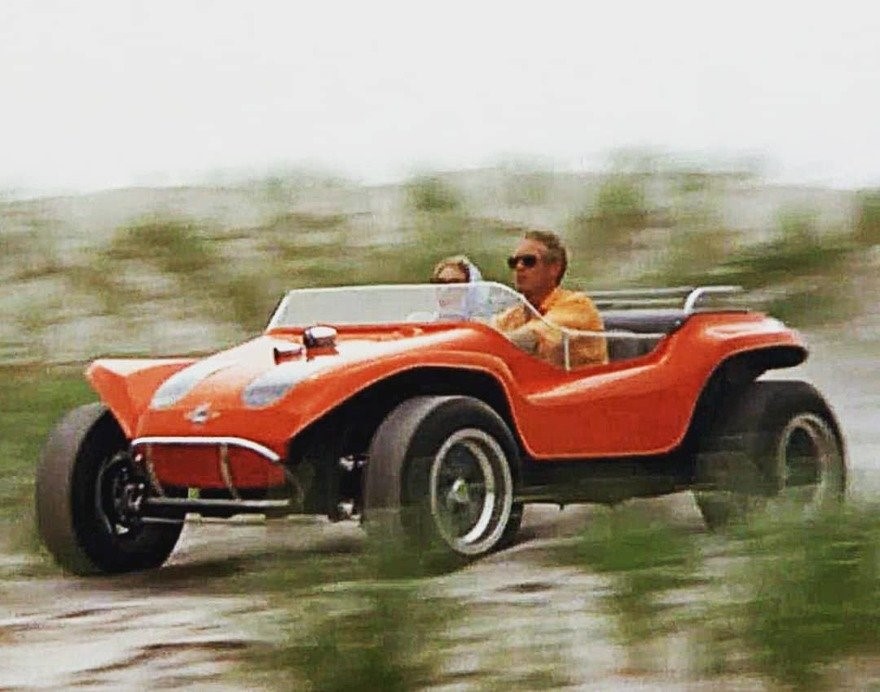
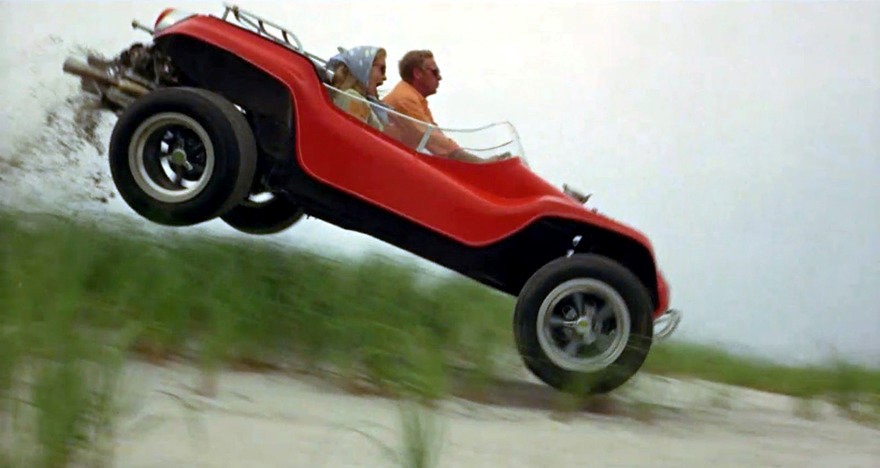
As orders came piling in, B.F. Meyers & Co. grew into a company of 70 employees furiously producing Manxes.
Undone by thievery.
EMPI, the L.A. VW dealer, approached Meyers with an offer: let them get in on the action and help distribute the cars, in exchange for a cut. When Meyers turned them down, EMPI produced a “very” similar design and began selling them.
EMPI wasn’t the only one. Earlier I wrote that the benefit of fiberglass bodies are that they come out of a mold. That’s also their curse. Several unscrupulous companies bought a Manx, made a casting from the body, then started selling their own exact copies.
Meyers, who had had the foresight to patent his design, tried taking them to court. The judge presiding over the case, who was either hostile to or ignorant of design, ruled Meyers’ creation unpatentable and took the unusual step of rescinding his patent. With all legal obstacles to copying removed, the market now became flooded with copies.
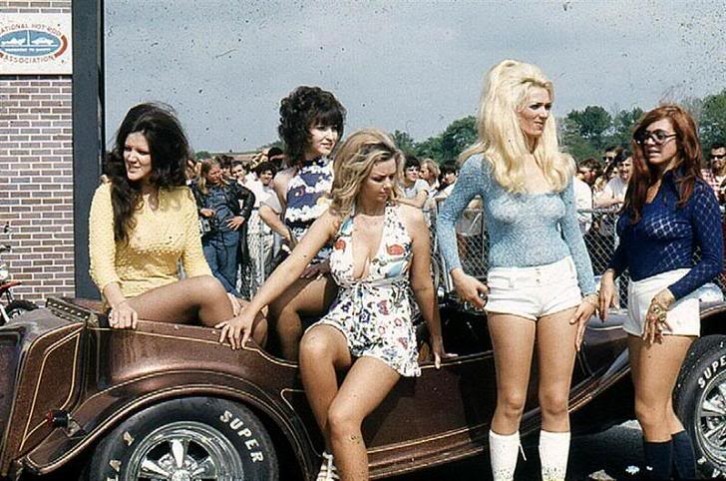
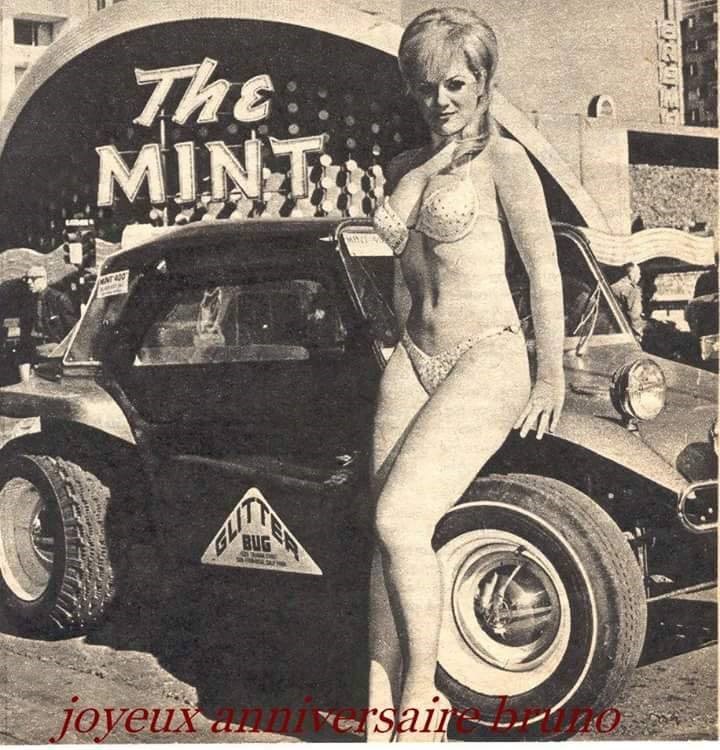
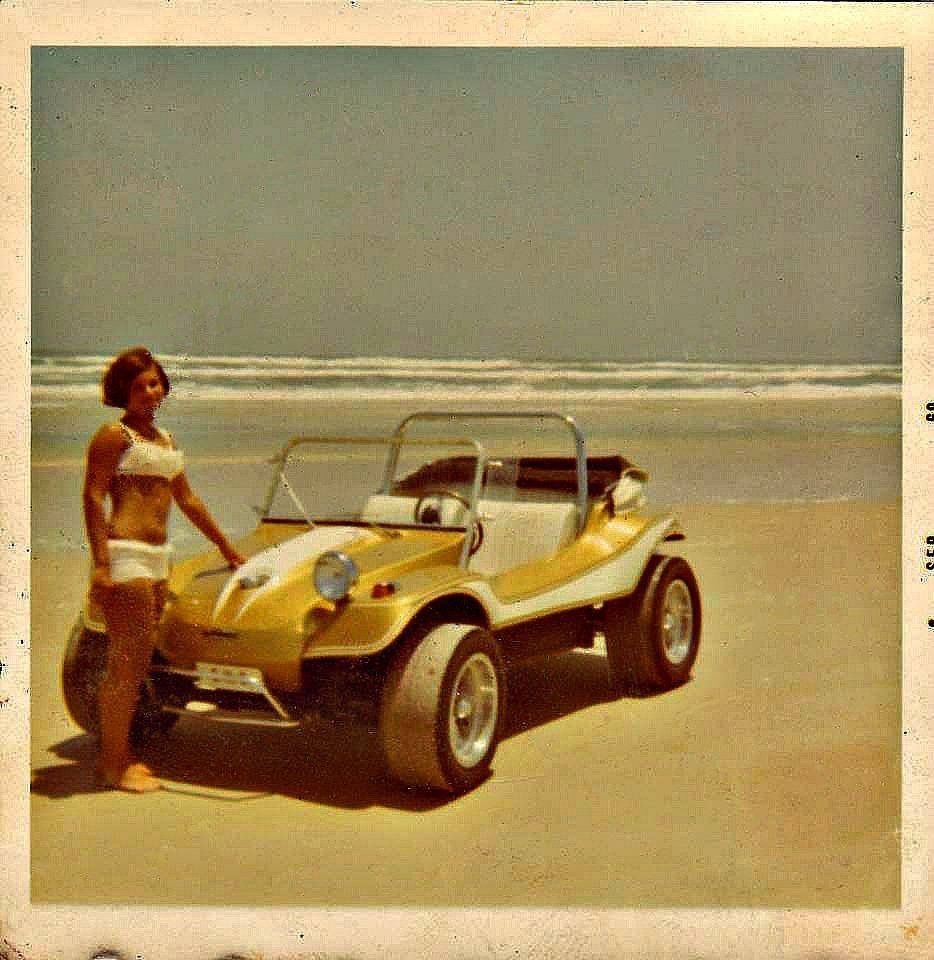
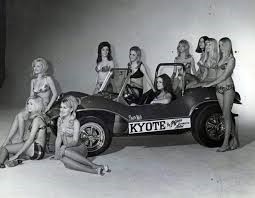
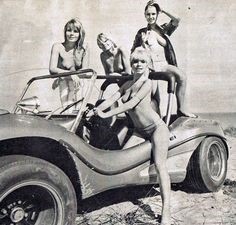
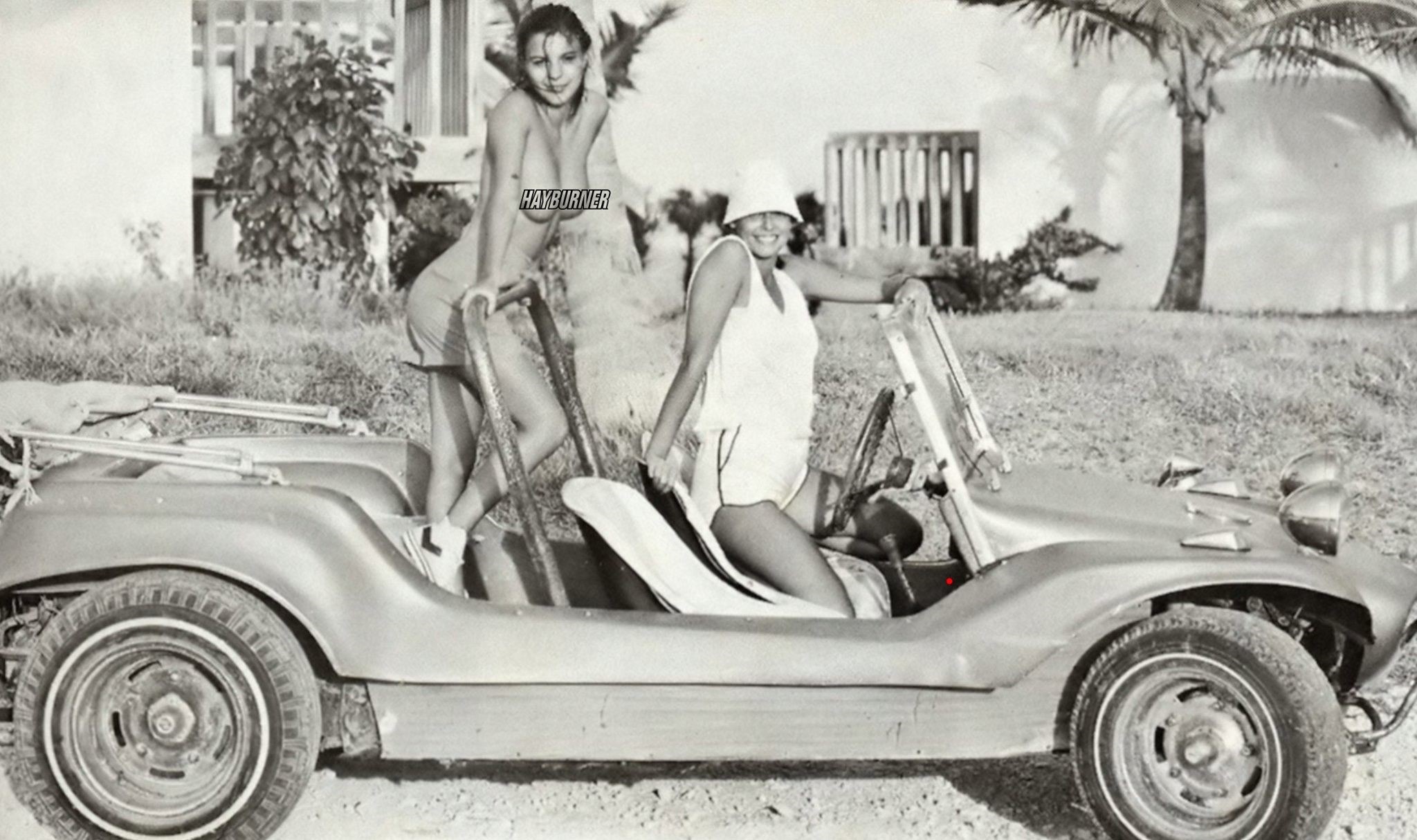
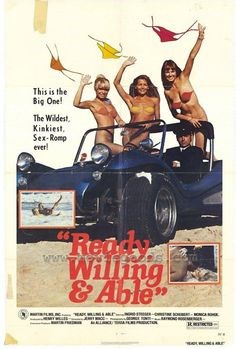
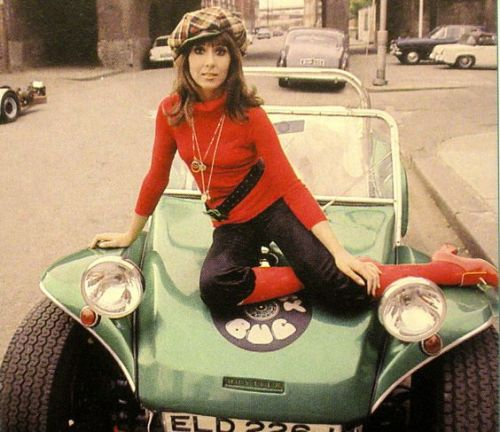
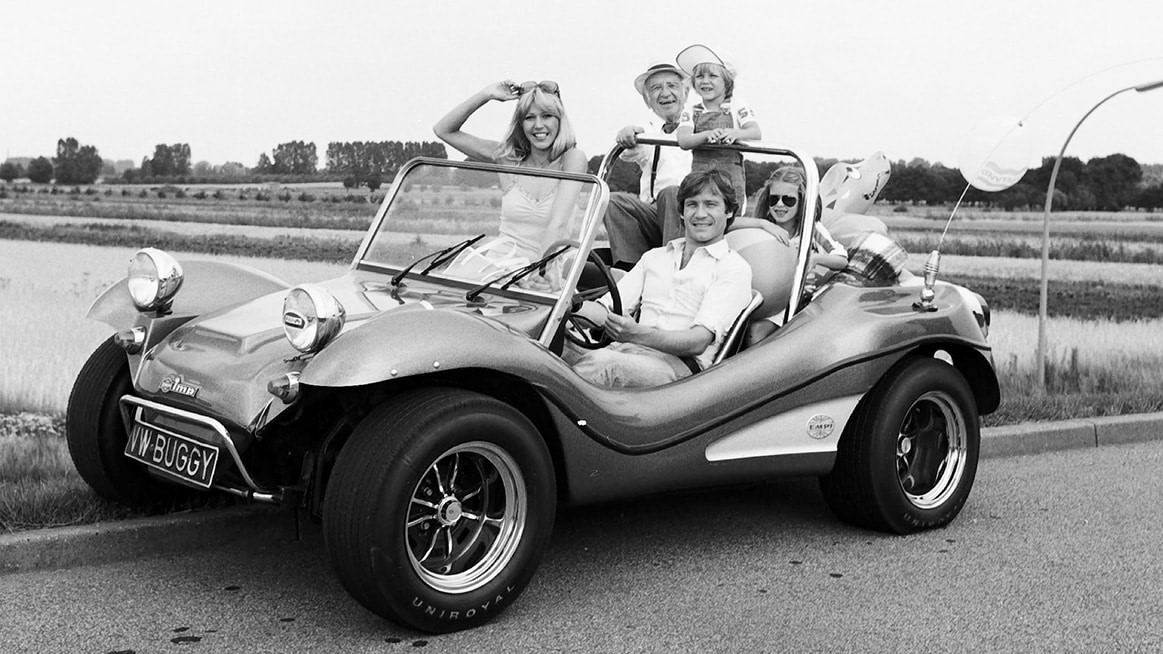
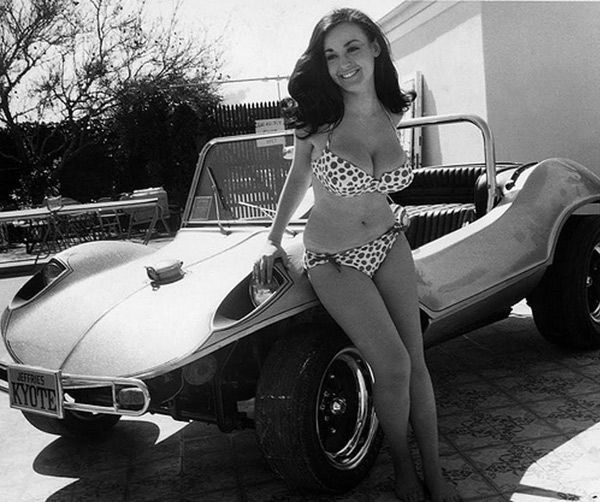
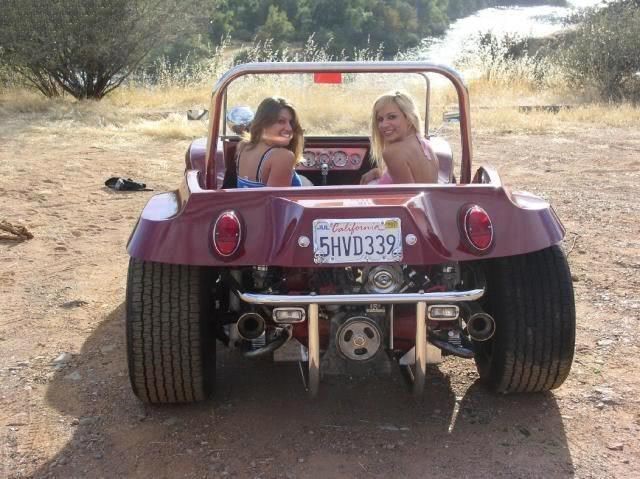
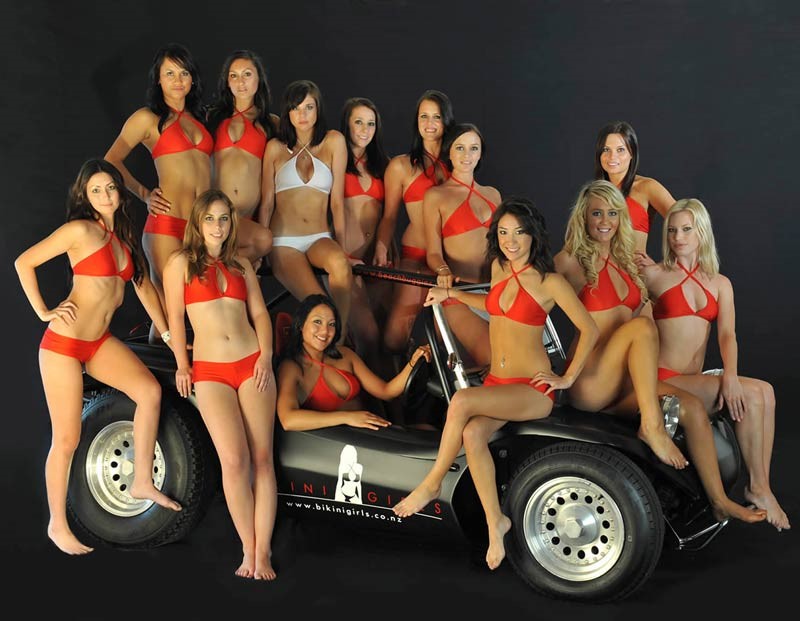
All told, by 1971 B.F. Meyers & Co. had produced about 6,000 Meyers Manxes – versus roughly 250,000 to 350,000 knock-offs to the present day. The Off-Road Motorsports Hall of Fame writes that the Manx is “the most copied vehicle in history.”
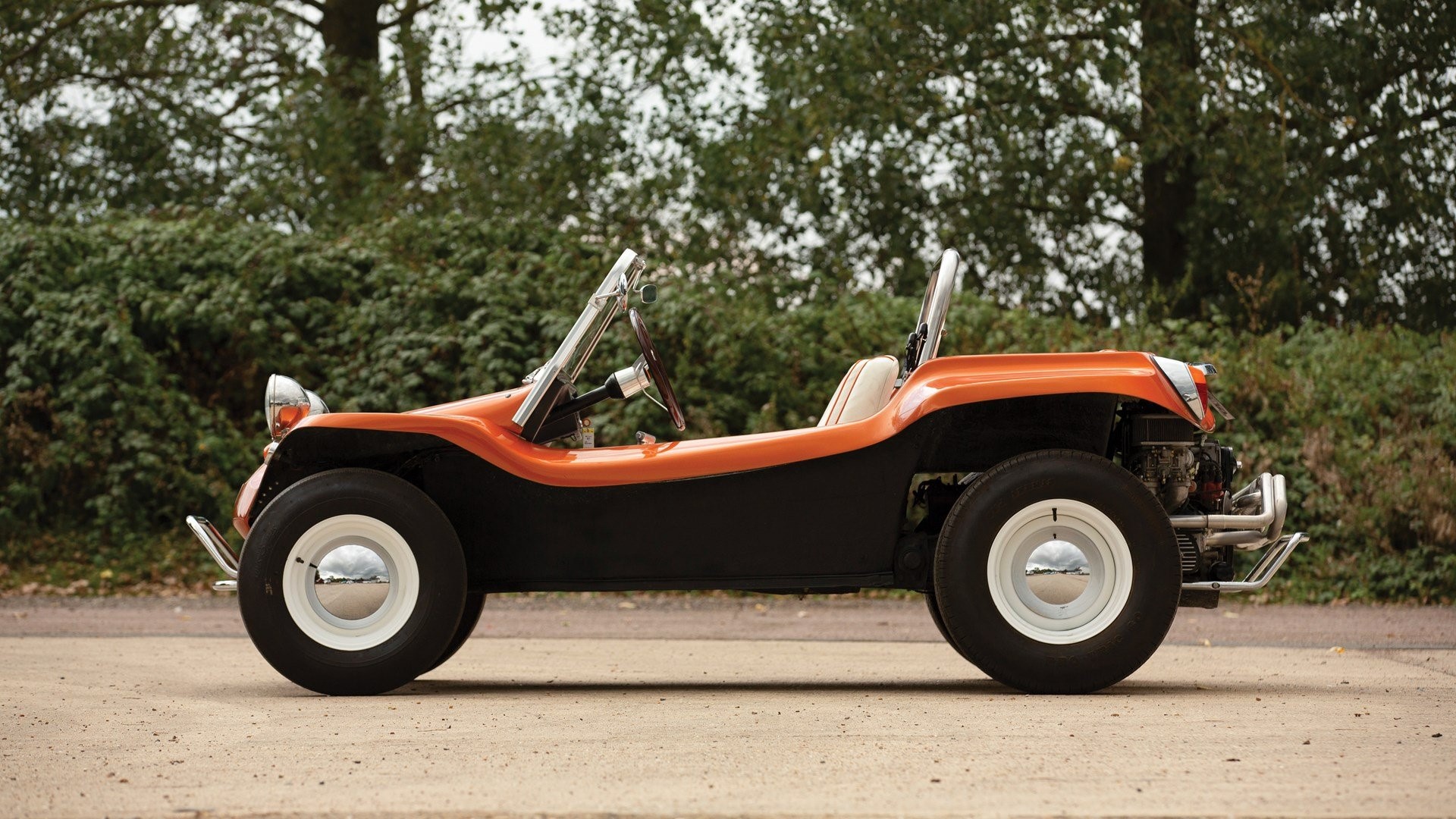
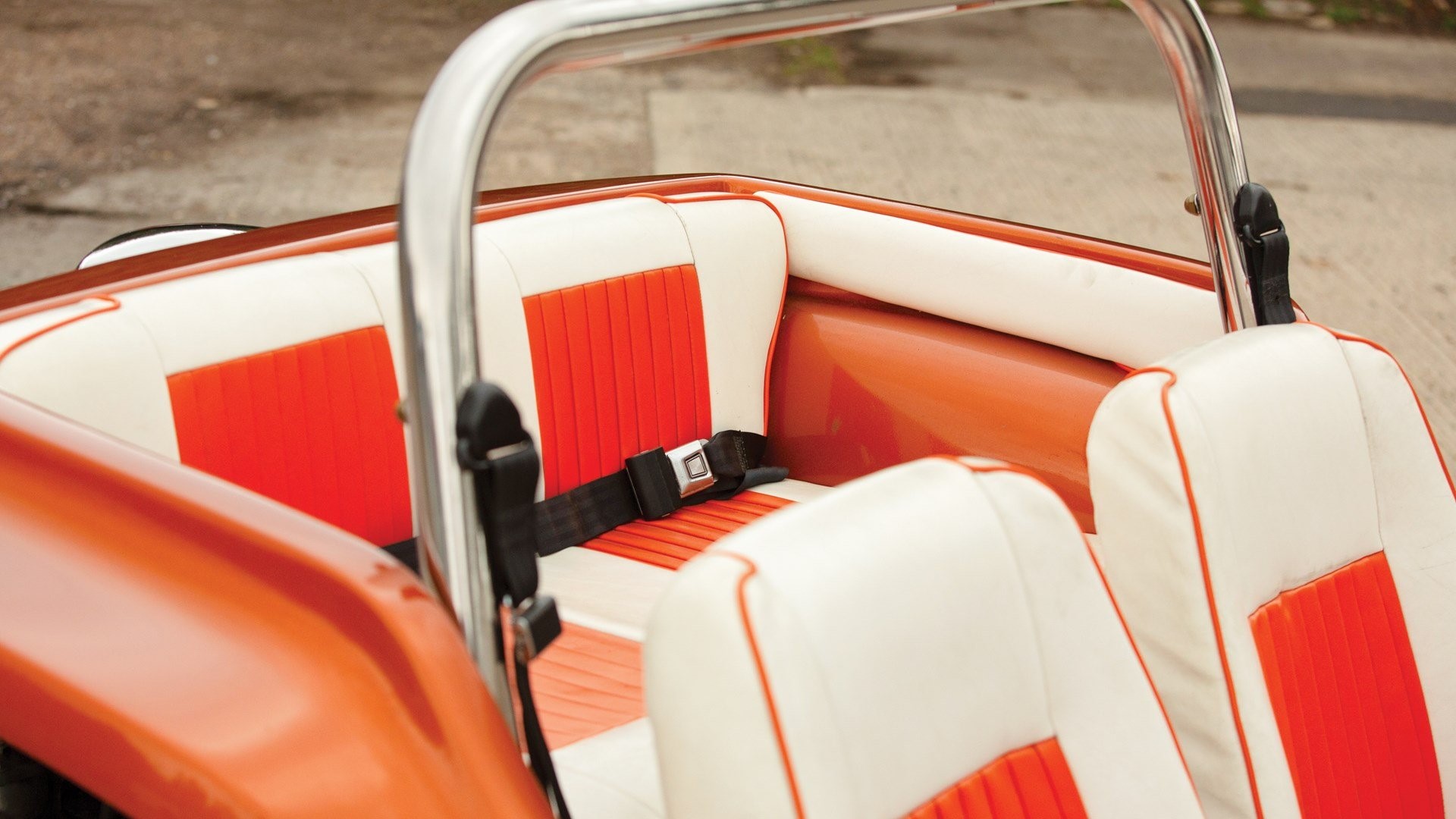
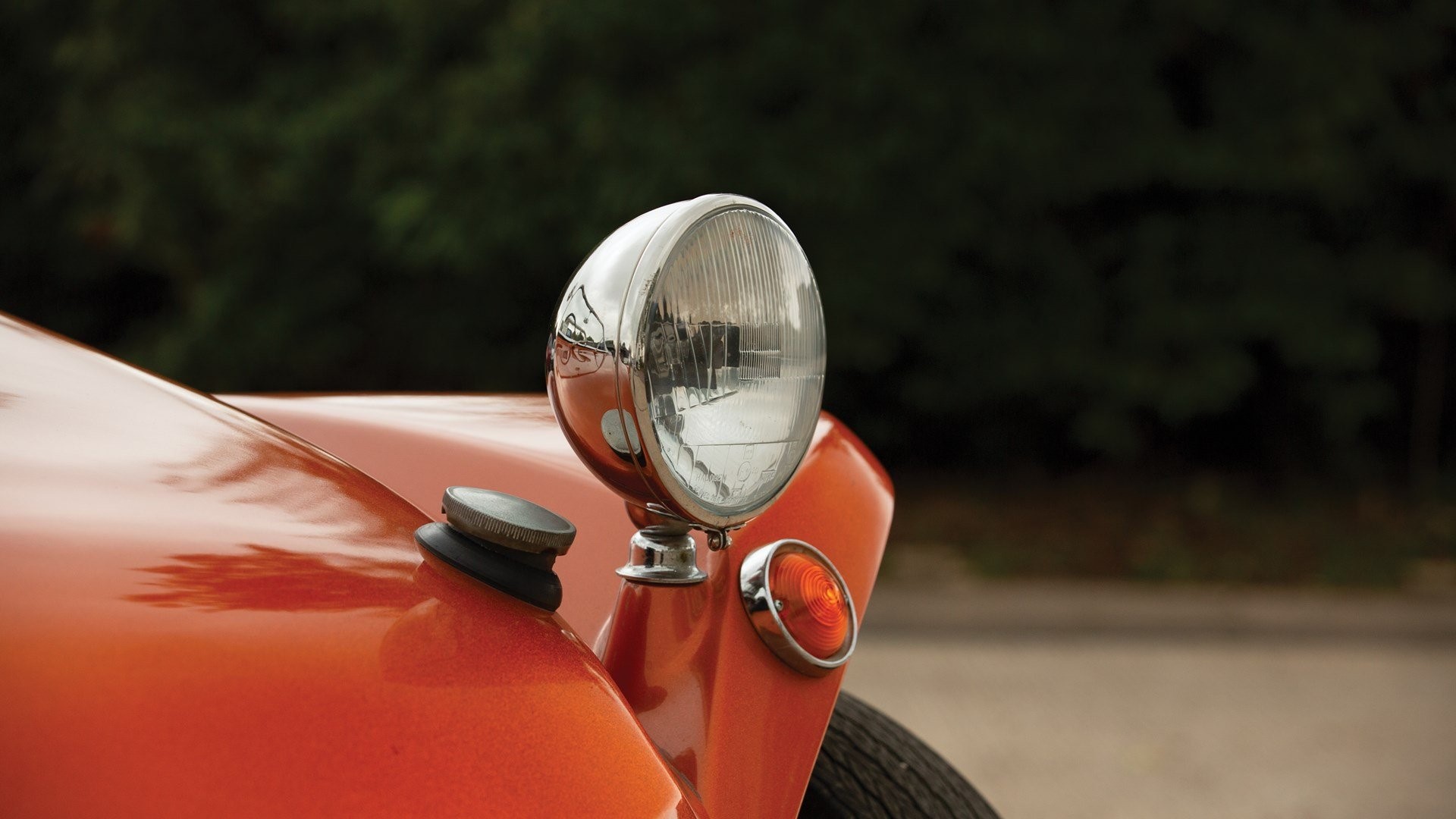
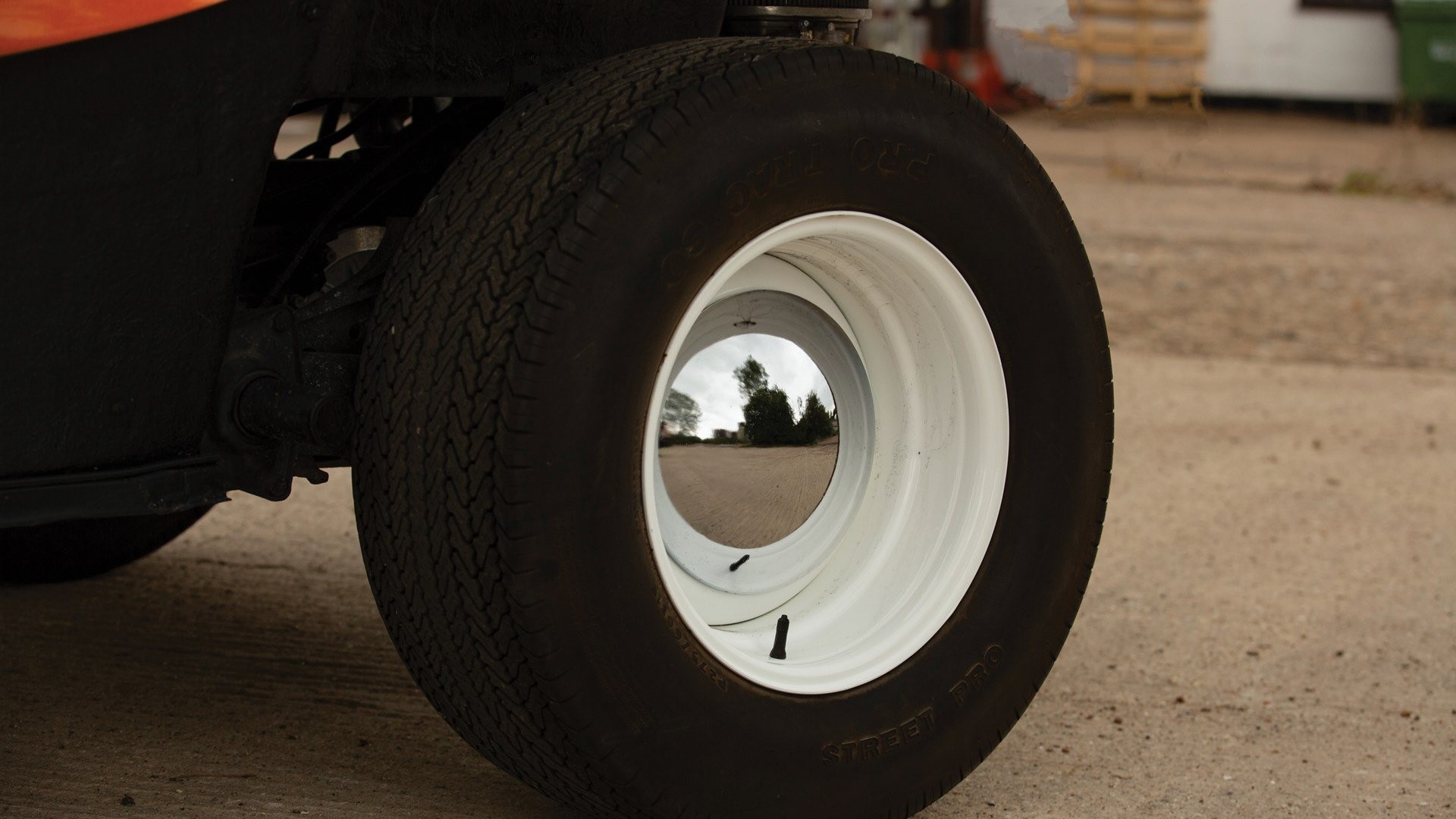
1970 Meyers Manx SR2.
Meyers’ company went bust in 1971, unable to weather the onslaught of copycats.
Meyers himself went on to invent the fiberglass hot tub and – fun fact! – that fiberglass children’s bed that’s shaped like a Can-Am racecar. However, embittered by the untold loss of revenue from countless dune buggy copycats, he avoided going back into the automotive sector.
Whatever happened to Old Red?
After quitting the business, Meyers held on to Old Red for about a decade, then sold it to automotive executive Richard “Dick” Chrysler in 1982. Six years later, Chrysler sold the car to an employee of his.
In 1996 Chris Lewis, who was dating Meyers’ stepdaughter at the time, managed to track Old Red down. He bought it himself and returned it to Meyers as a present. What a mensch!
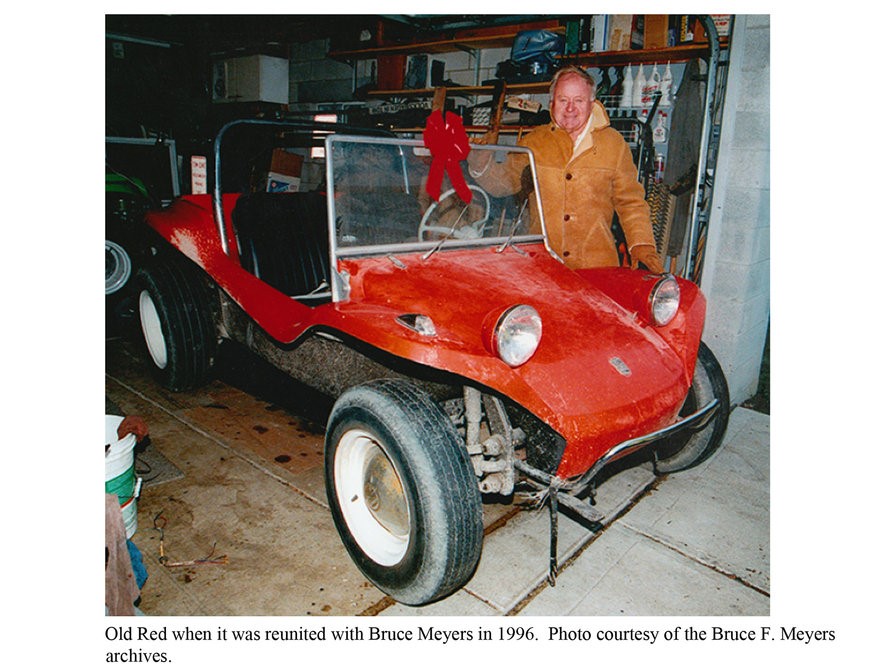
Old Red when it was reunited with Bruce Meyers in 1996. Photo courtesy of the Bruce F. Meyers archives.
You can see Meyers and Old Red on this episode of “Jay Leno’s Garage.” The car looks better than ever.
The rebirth.
Maybe it was seeing Old Red again, or maybe he realized that he had created something special that no amount of copying could take away from him. Meyers rebooted his company as Meyers Manx, Inc in 2000 and today they sell the classic Manx kit as well as “modern re-imaginings of the classic and iconic Meyers Manx.”
It’s worth noting that Meyers didn’t start building Manxes as a young man; he turned 40 the year he broke the Tijuana-La-Paz record. Today he’s in his 90s.
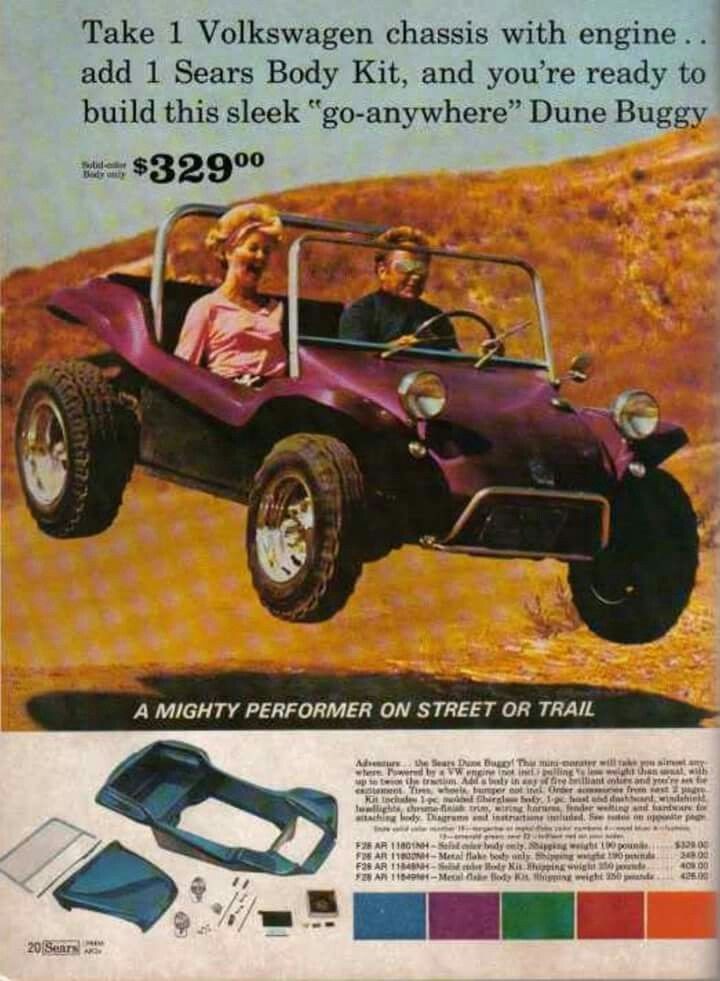
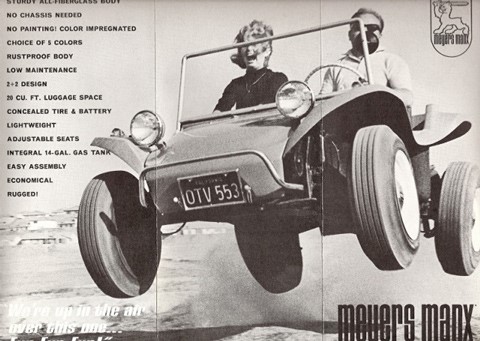
While Meyers never received the millions of dollars undoubtedly earned by his copycats, he did manage to create an iconic vehicle and one that has put a smile on the faces of thousands. Not to mention, his own.
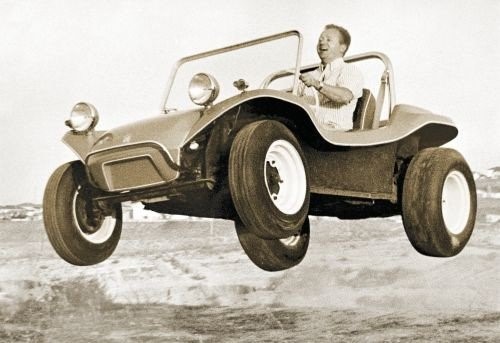
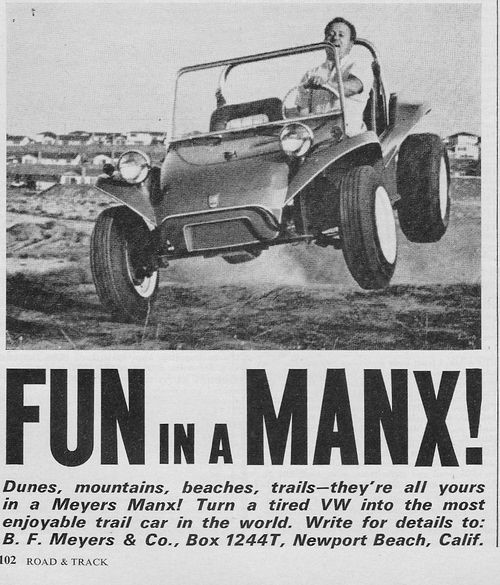
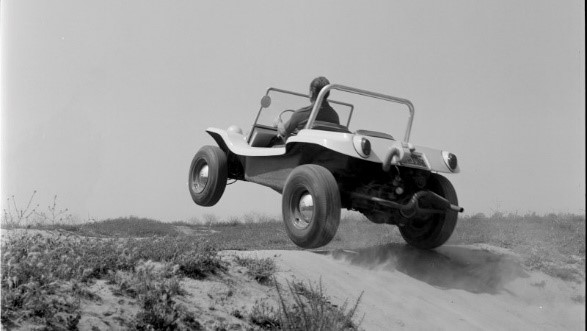
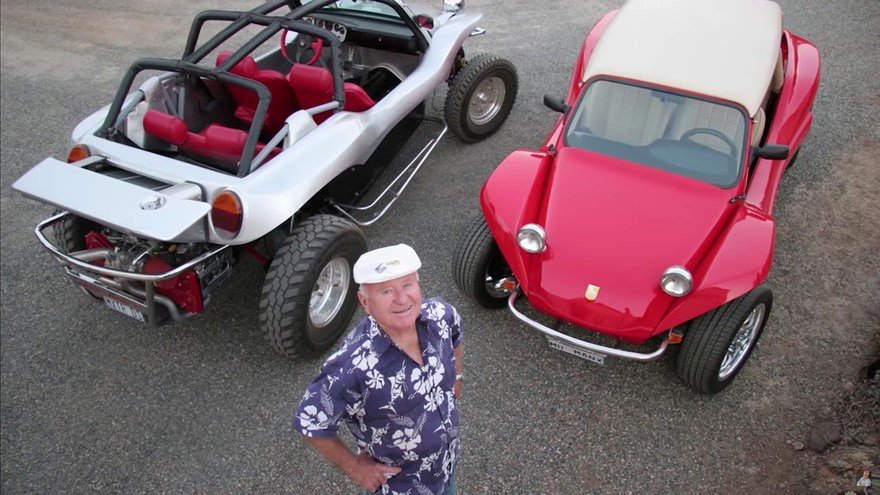
A place in the sun from the beach to the desert. By Jerry Garrett. September 16, 2007.
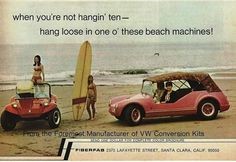
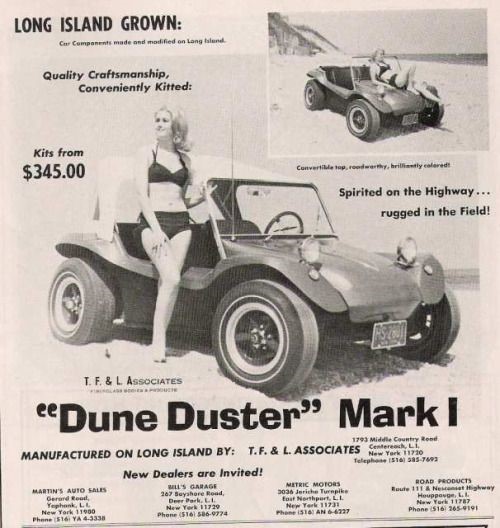
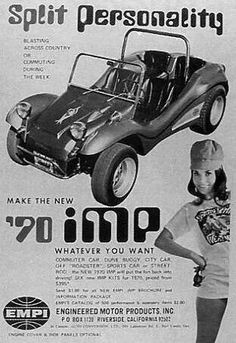
The dune buggy always seems like one of those all-American lifestyle gadgets that just arrived one day — like the surfboard, the skateboard and the snowmobile — more or less fully formed and ready to ride. But the dune buggy did have an inventor and can trace its roots back to its Adam, an elemental machine called Old Red. And this year brings an anniversary of perhaps the most important moment in its history.
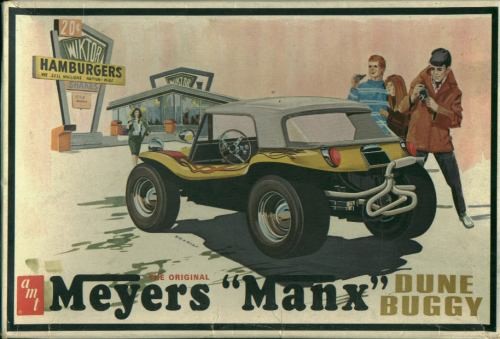
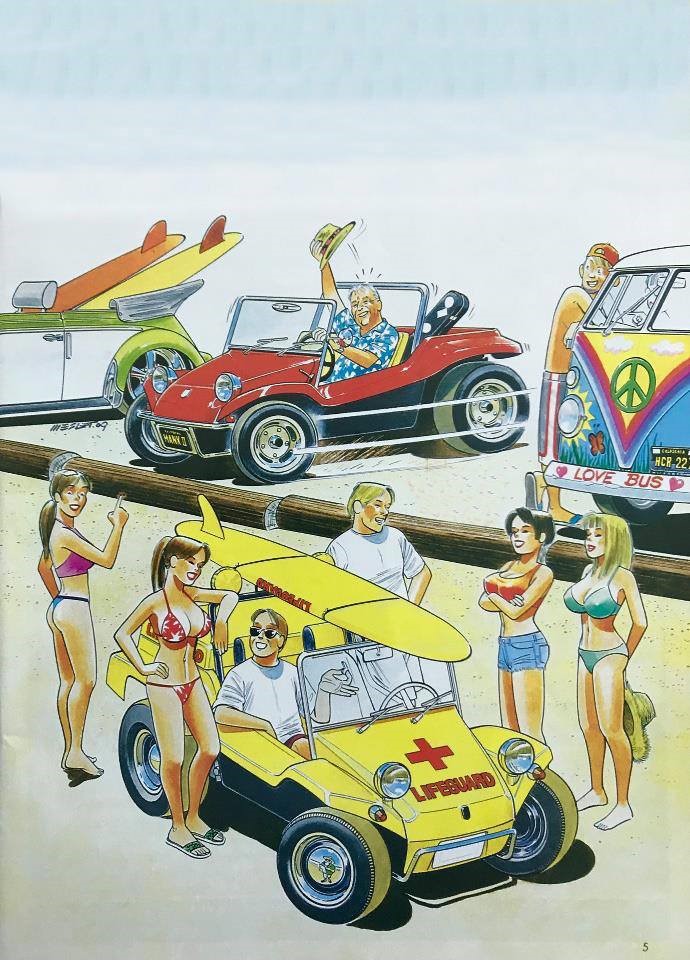
The first vehicle that we know as the dune buggy was invented by Bruce Meyers of California in 1964, with a big assist from Dr. Ferdinand Porsche.
“It was the genius of his design that made it all possible,” said Mr. Meyers, now 81 and still building buggies here in Valley Center, about 40 miles north of San Diego. “The transaxle-rear engine placed all the driveline weight over the driving wheels. The air-cooled engine, with no radiator, simplified water worries. The trailing arm suspension, like on commercial airliners, allowed the wheels to move away, rearwards and up.”
Mr. Meyers took a standard Beetle of the era, threw away the body, shortened the frame, fitted fatter tires and bolted on a fiberglass tub with two seats. Voilà! — the dune buggy, which he called the Meyers Manx, was born. It was as simple as that. It would prove to be too simple, in fact.
“By what I did to it, I made it better five ways, all for improved off-road performance,” Mr. Meyers said. “I made it lighter and quicker, gave it a shorter turning radius, moved the people farther aft for more traction and increased belly clearance.”
Still, it was just a Beetle then and no more than a novelty.
The Kübelwagen, the German Army’s version of the jeep in World War II, was based on the Beetle. Many models of the jeep weighed more than 2,200 pounds, but the Kübelwagen was less than 1,700. “The Kübel got twice the fuel mileage as the jeep,” Mr. Meyers said. “When a jeep got stuck, a tank had to tow it out; when the Kübel got stuck, four soldiers could bounce it out. It was just as good in snow as it was in sand.”
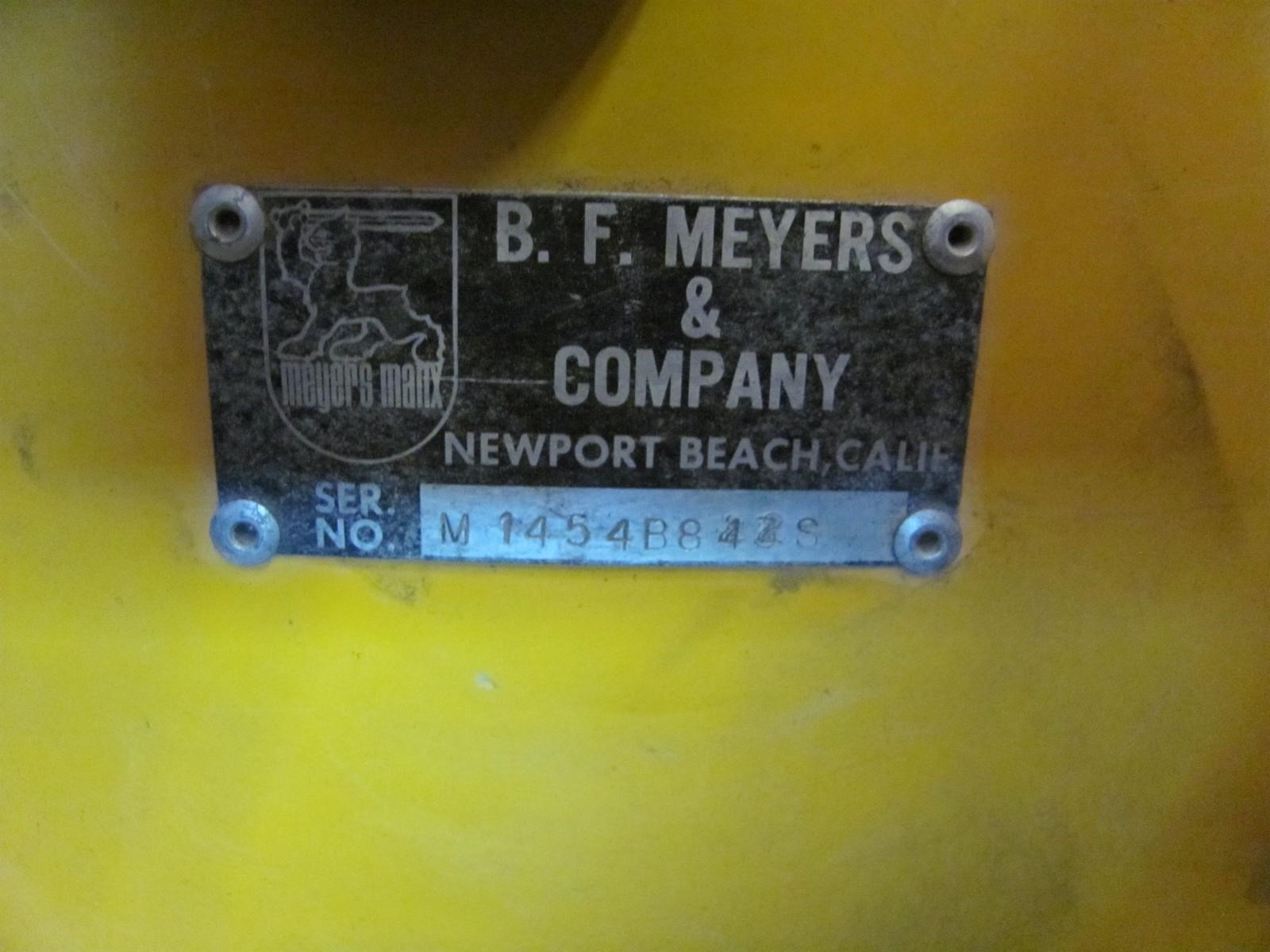
Mr. Meyers, who grew up in and around Newport Beach, California, knew the car was good in sand; he’d tested it in the desert of Baja California.
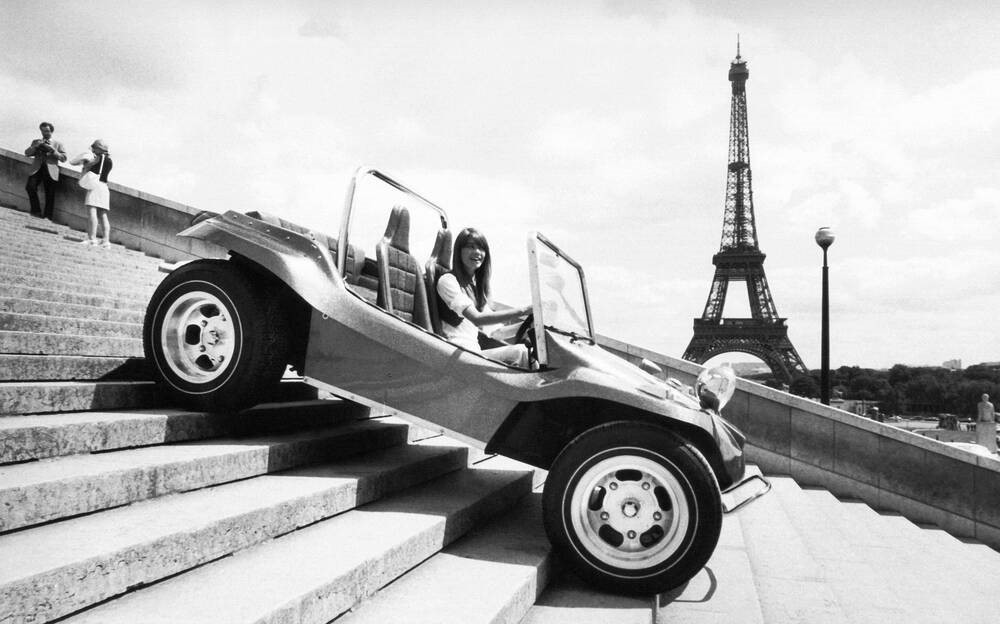
Françoise Hardy in a buggy in 1962. Photo by Phototheque Lecouvre.
Motorcyclists ruled Baja then, setting several unofficial time, endurance and speed records running between various towns. The most storied accomplishment was a 1,000-mile ride in 1962, through roadless deserts, from Tijuana to La Paz by Dave Ekins and Bill Robertson Jr. on Honda 250 Scramblers. It took Mr. Ekins just under 40 hours.
Over the next five years, dozens of other motorcyclists, daredevils in cars and trucks and even automaker-backed efforts, tried to beat the record. Mr. Meyers figured his four-wheel creation was tough enough to do it.
“Here was the allure of unmistakable adventure,” Mr. Meyers recalled. “Add a certain amount of youthful exuberance and my co-pilot’s wisdom of planning and I thought we could do the unthinkable — beat world-class riders on factory motorcycles across open country. I thought it could lead to kit sales for my Manx.”
So, in April 1967, Mr. Meyers and his co-rider, Ted Mangels, an engineering and logistical whiz, got into Old Red with 65 gallons of gasoline, most of it in plastic jugs and set out from Tijuana for a nonstop run to La Paz. They arrived 34 hours, 45 minutes later.
“Almost overnight we had 350 orders,” he said.
By November, the first Baja race (called the Mexican 1000 then) was held. Fittingly, a Manx driven by Mr. Mangels and Vic Wilson won that first race. The 40th annual Baja 1000 will be held this November, with Mr. Meyers and a Manx leading a ceremonial start.
Another memorable Manx moment: Steve McQueen raced one in a scene from the 1968 film, “The Thomas Crown Affair.” The Manx was on magazine covers and was the subject of do-it-yourself articles and technical treatises.
For a time, the Manx made Mr. Meyers a wealthy man. But he made one very large mistake: he failed to patent his idea. When he finally did, years later, “a judge ruled it invalid because the idea had been in public use for too long by then”, Mr. Meyers said.
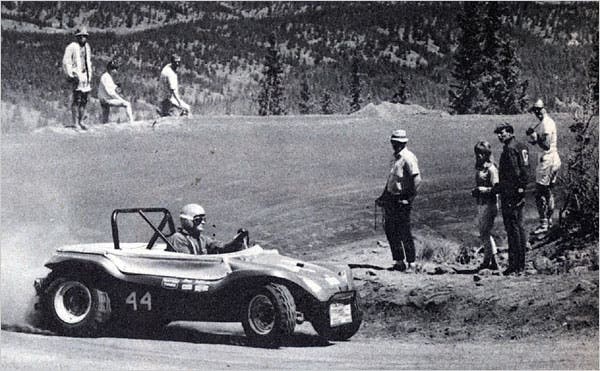
A run up Pikes Peak. Photograph courtesy of Meyers Manx.
Within two years, more than 70 companies, by his count, were building knockoffs. Even Sears offered a buggy called the Rascal. It has been estimated that more than 100,000 faux Manxes were turned out; about 5,000 true Manxes were made.
Because it was so simple to convert a Beetle to a buggy, almost anyone could do it. By 1970, the copycats had put Mr. Meyers out of business.
He had nothing more to do with dune buggies for nearly a quarter-century. But in 1994, after he was treated like a rock star at a motoring event in, of all places, Le Mans, France, Mr. Meyers said he started to think about reviving Old Red.
In 2000, he announced a limited-edition production run of 100 Manx kits for $2,000 each.
“I wondered if I’d sell any,” he said. Instead, he got orders for all 100 in the first month.
It seemed that fans of dune buggies were willing to pay a premium for an authentic one, built by Bruce Meyers himself. The very problem that had put him out of business in the first place — knockoffs — now made a real Manx a collectible.
But Mr. Meyers had new problems. He felt honor-bound not to make more than 100 to retain their value to collectors. He had also set the price too low and was scarcely making money.
Old Red, Mr. Meyers’ little creation that beat Baja, started a sport and a new form of transportation.
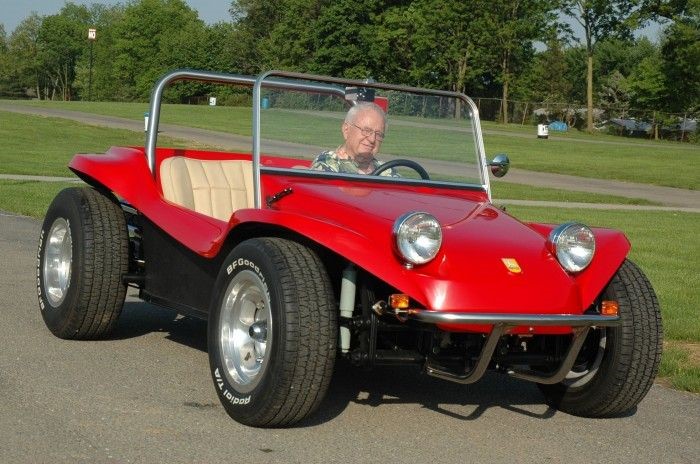
Meyers Manx: the legend of the Dune Buggy. By Paul Clément-Collin. August 28, 2014.
When I was little, there were some cars that particularly appealed to me: buggies. Fortunately, I switched to more serious cars, but I still have a special affection for these funny insects, mostly on a VW Cox basis.
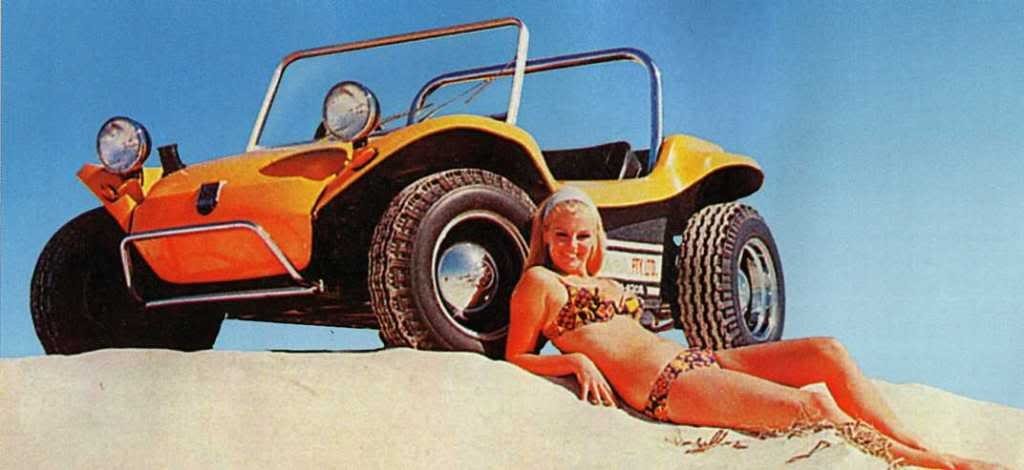
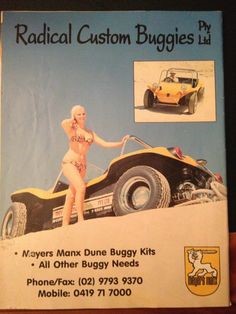
1961 Volkswagen Meyers Manx buggy.
Maybe it was because they smelled of vacations, the beaches, the Beach Boys, surfing, California and (mostly) because there was often a cute girl in a bikini posing next to the Buggy.
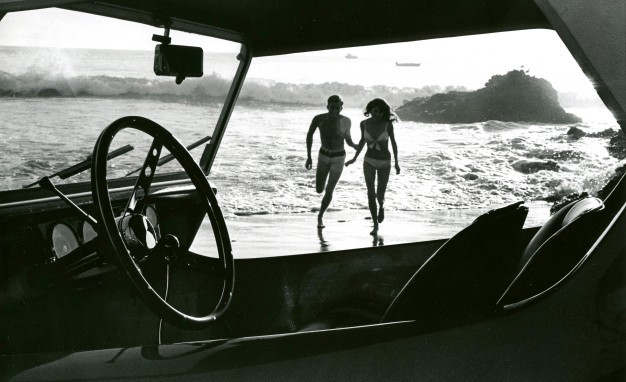
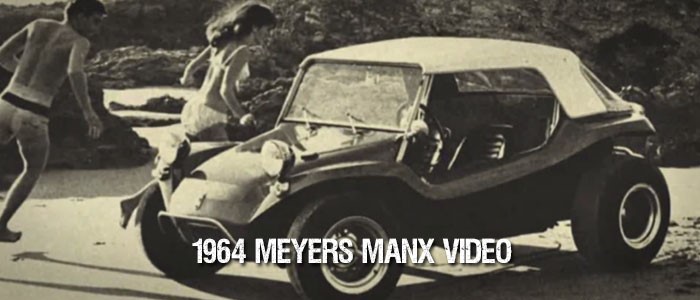
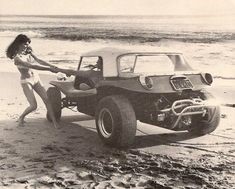
1964 Meyers Manx video off-road action.
There were countless brands that entered the Dune buggy market, including Sovra LM and Baboulin in France. But the real legendary Buggy comes to us from California: the Meyers Manx. We are celebrating its 50th anniversary this year (and yes, already!).
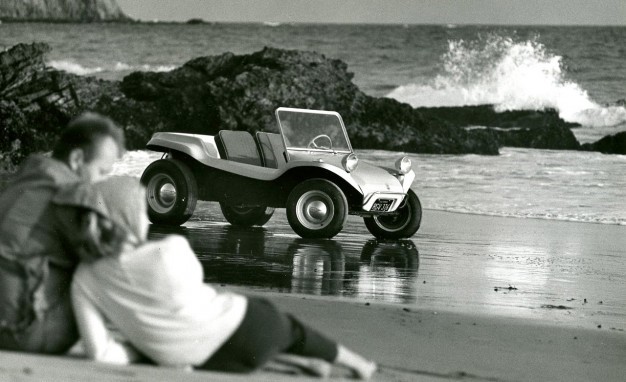
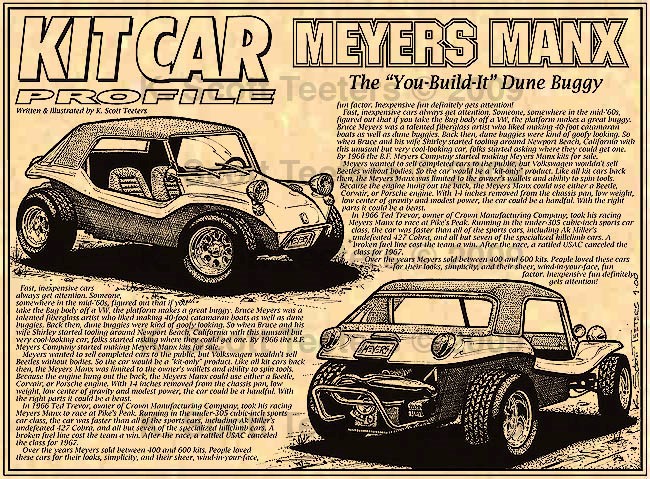
Bruce launches himself into the production of 11 kits, all sold at the same price of nearly 1000 dollars. A little expensive!
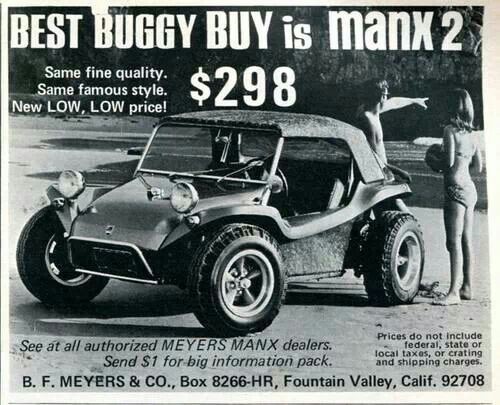
The Manx becomes an icon of California, linked to surf and the beach and we quickly see it in many films and telefilms. The success is immediate.
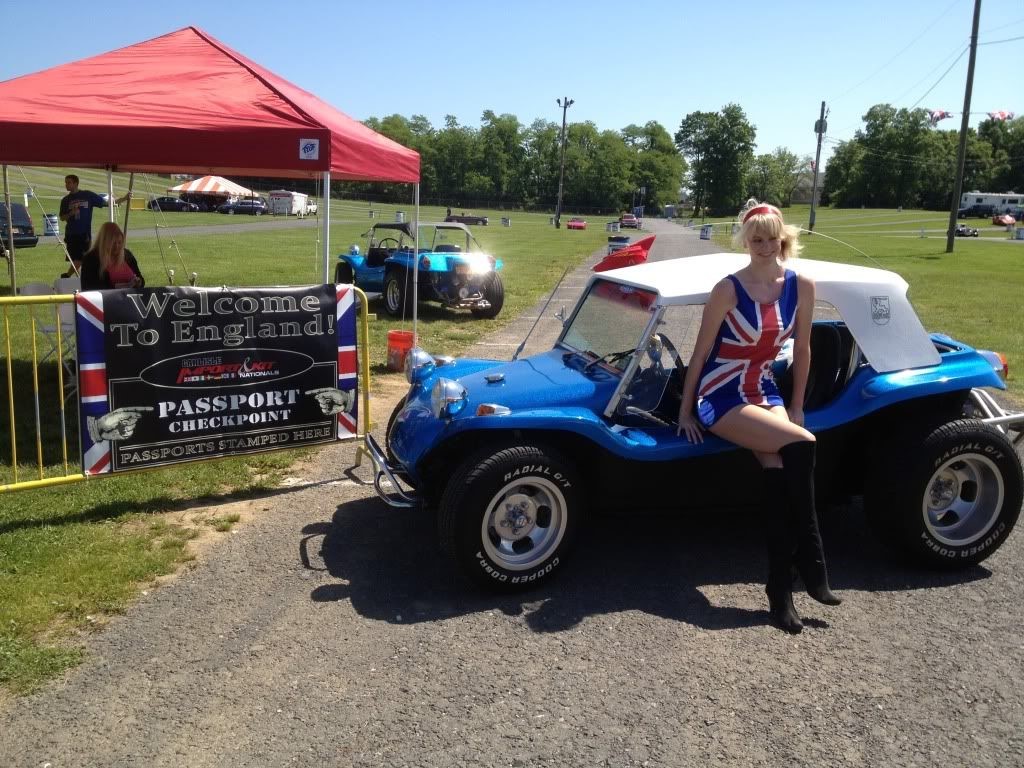
However, one can be a brilliant inventor and a poor manager.
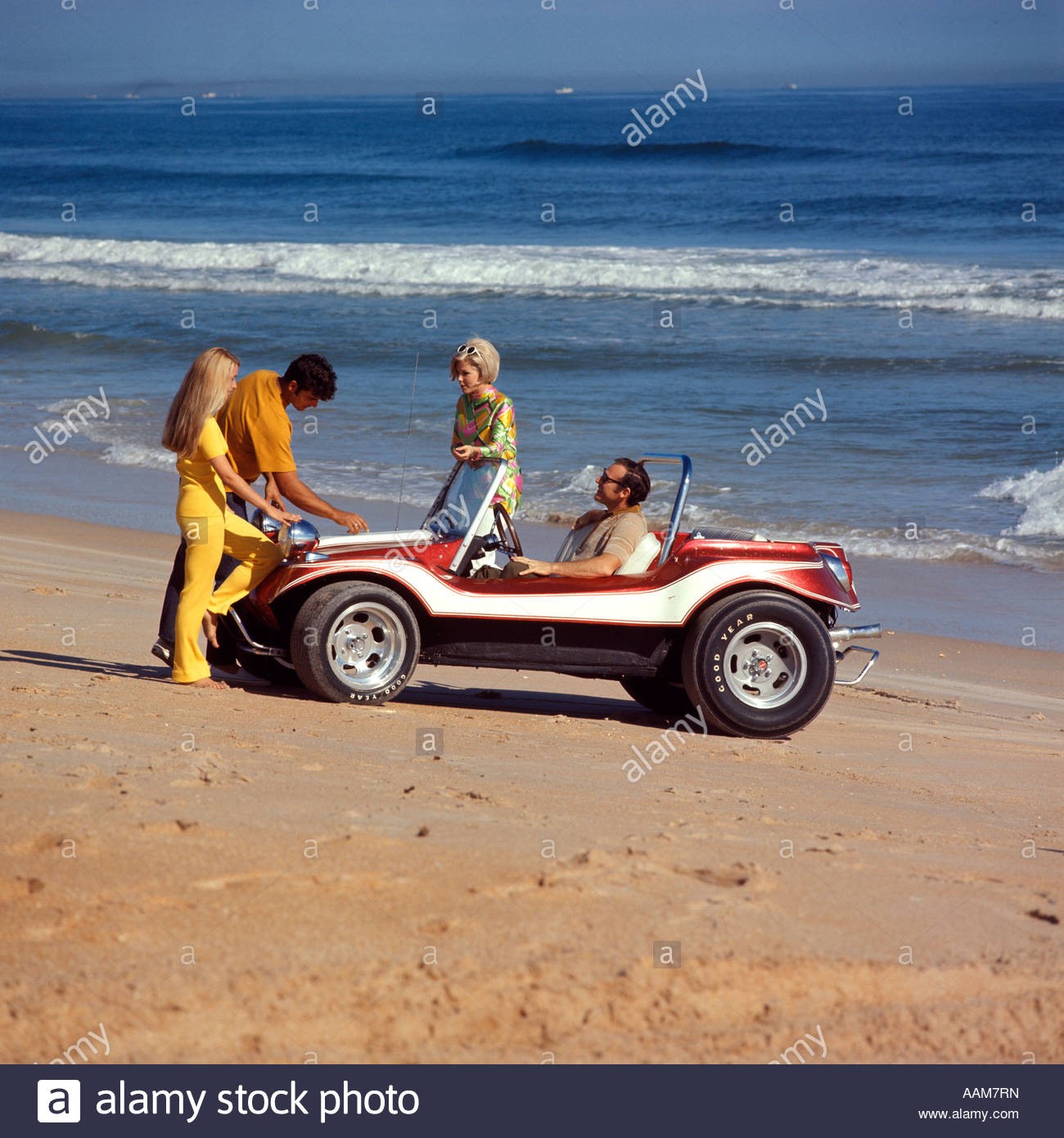
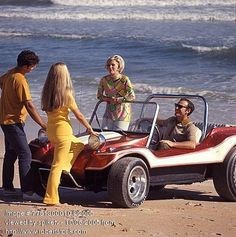
2 1970s couples on beach with a red white dune buggy.
If the business stopped in 1971, it was not for lack of success but, above all, because of indelicacies with the American tax service, the famous IRS, the strengthening of legislation and increasingly tough competition. Bruce had already left the company in 1970, following his divorce and internal tensions and desiring a less stressful life.
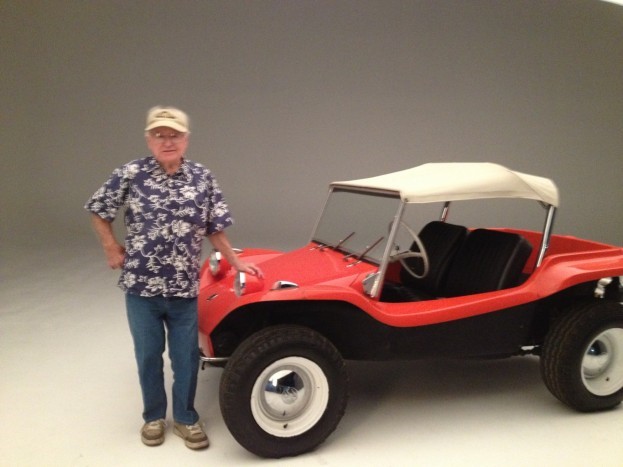
Today you can find real Meyers Manx for around 10,000 euros. The price to pay to stand out from the crowd on the beach and to taste a little legend of the underground automotive world.
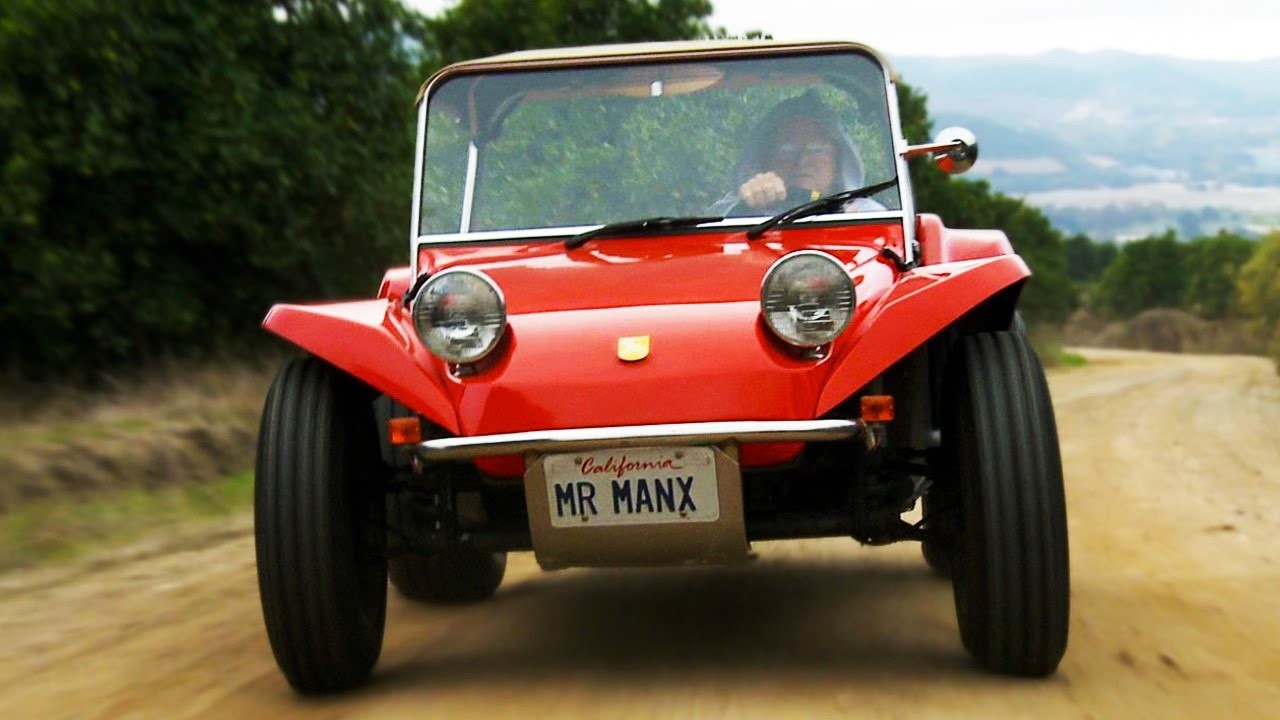
The Meyers Manx: the Dune Buggy that enchanted the world. By Andrew Miterko. July 25, 2019.
Bruce F. Meyers's charismatic fiberglass creation became an American icon and the quintessential fun-loving off-road vehicle.
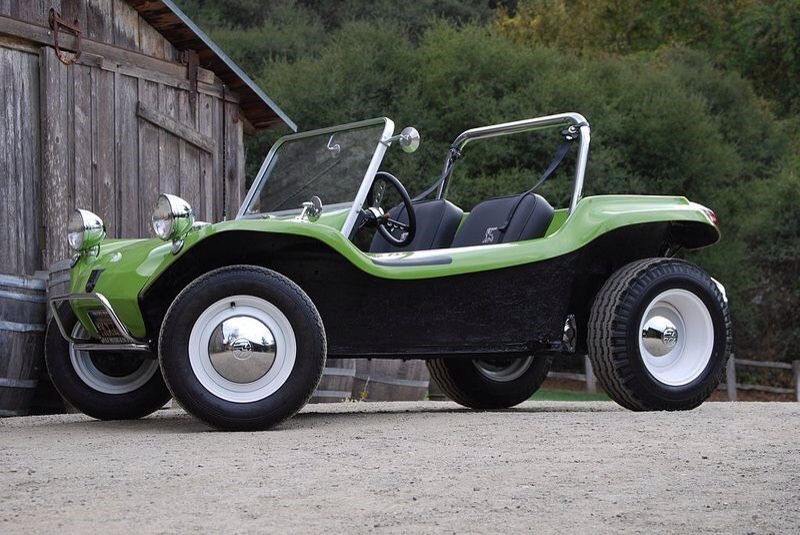
As a Southern California native, Bruce Meyers grew up in the midst of the early days of surfing, drag racing and hanging out at the beach. Pismo Beach introduced Bruce to the dune buggy – albeit a very different type than the lightweight style we think of today. The early dune buggies were referred to as “water pumpers” and were crude, heavy backyard creations based off of full-size sedan and pickup truck chassis, generally incorporating a V8 engine mounted toward the middle of the chassis with a pair of seats mounted over the rear axle. Bruce took it upon himself to improve upon the design, modifying a VW Kombi bus with wide wheels and dubbed “Little Red Riding Bus." Shortly thereafter, Bruce incorporated his boat building experience to construct the first fiberglass bodied dune buggy and thus the Meyers Manx was born.

The Meyers Manx took the world by storm, appearing on the covers of Hot Rod magazine and Car & Driver.
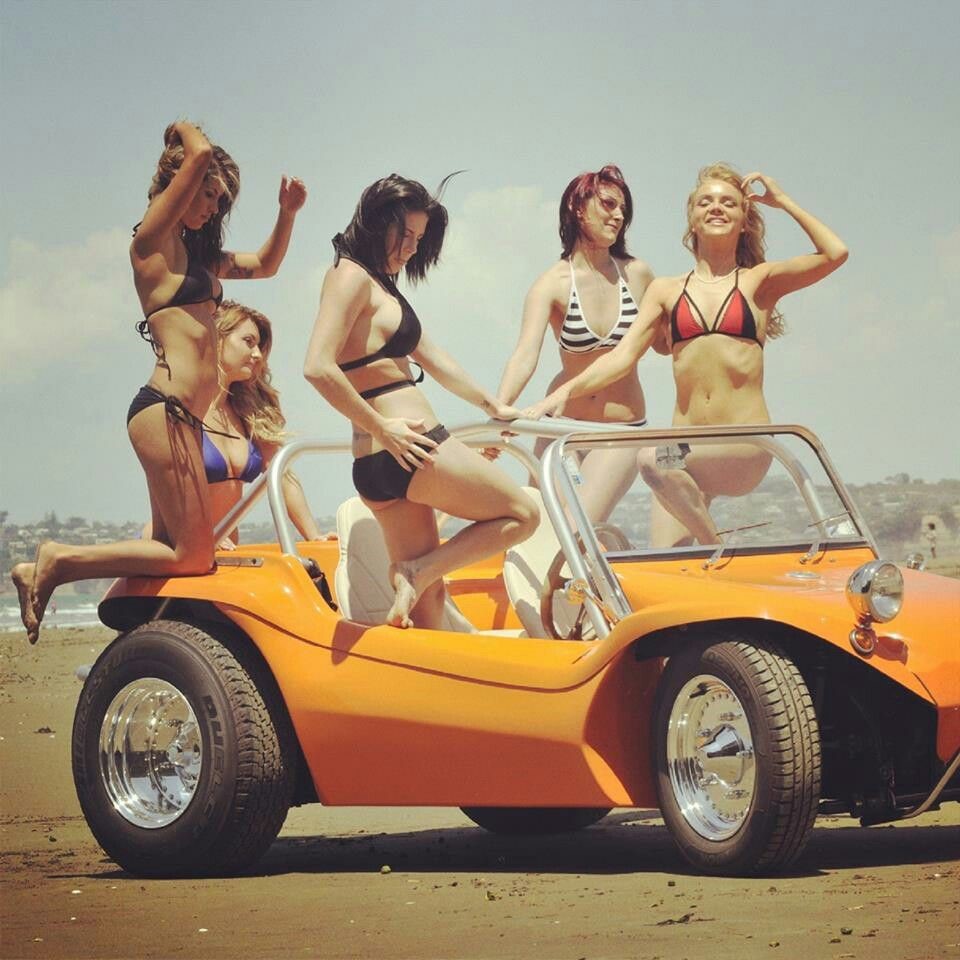
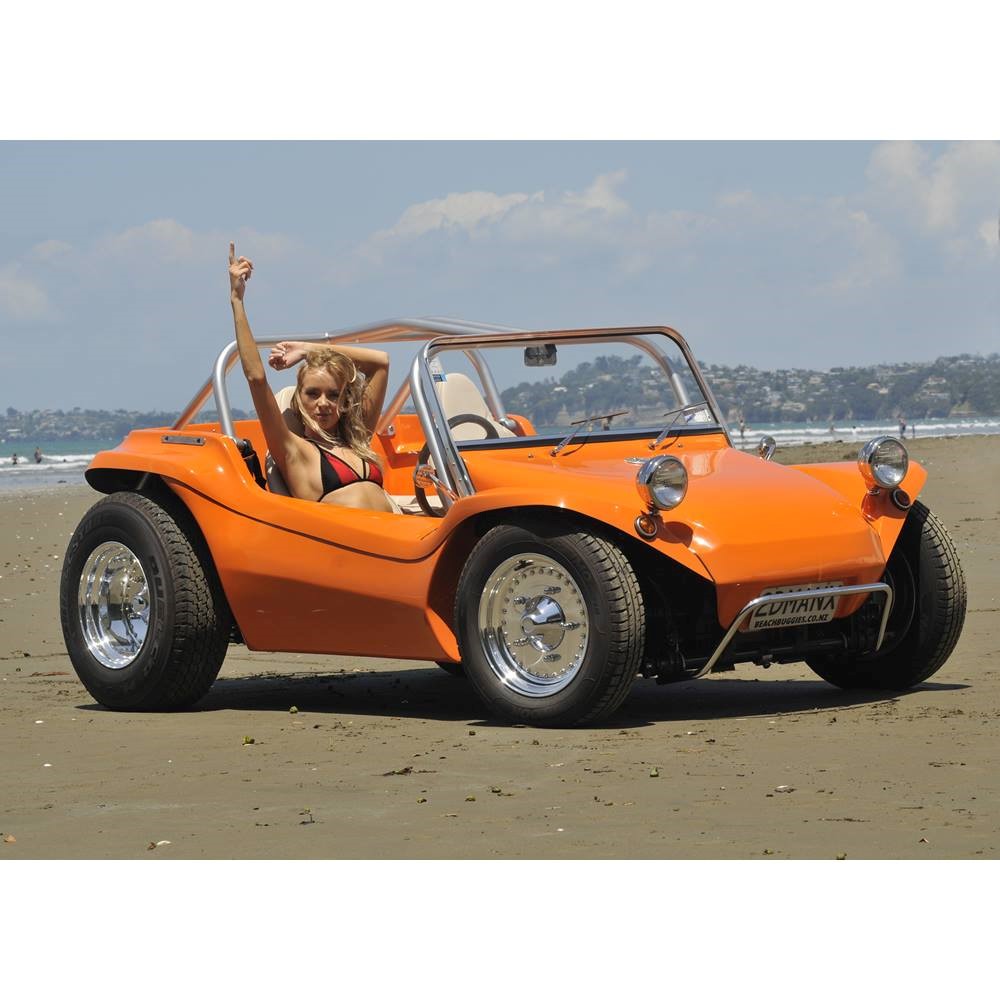
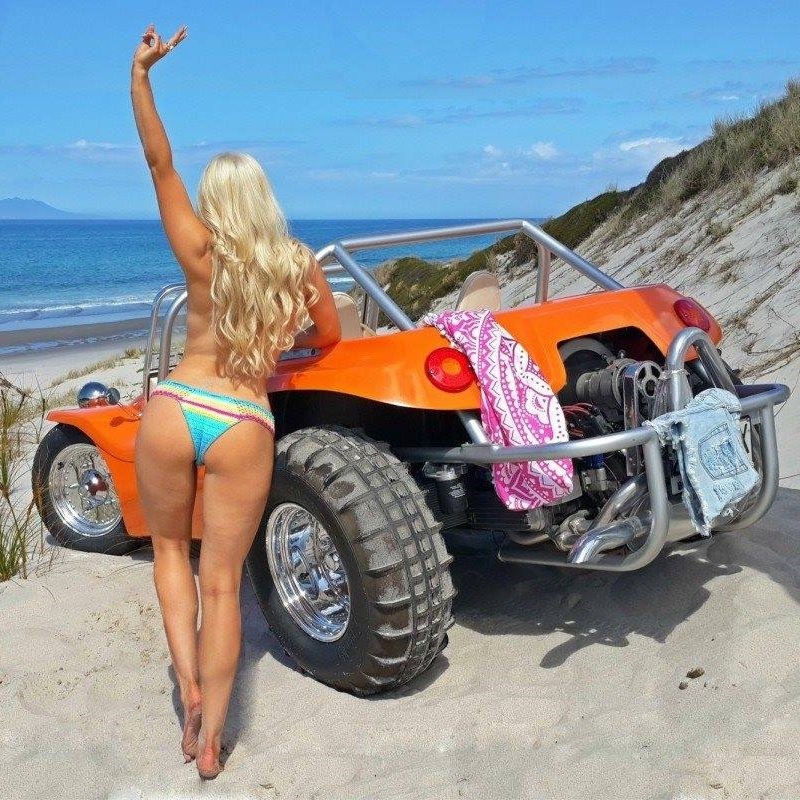
The Manx proved to be lightweight and fun and extremely capable-especially off road. It even found itself successful in competition, winning its class in the 1966 Pikes Peak hill climb, eclipsing the Tijuana to La Paz motorcycle record by over five hours and taking first and second place in their class at the first official race, the Mexico 1000 in 1967.
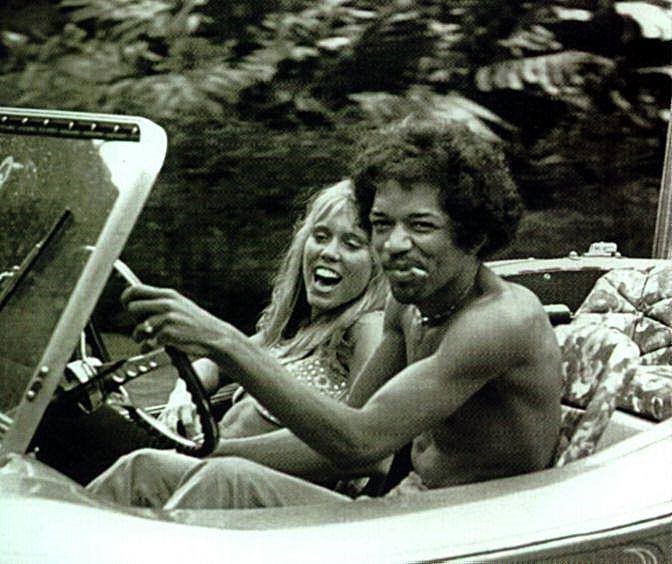
Jimi Hendrix.
Over the years the list of victories for the buggy in off road competition began to grow, as did a pop-culture following bolstered by a starring role in films such as Steve McQueen’s “The Thomas Crown Affair”.
Offered here through RM Sotheby’s Online Only auction platform is an early example of Bruce Meyers’s creation, thoroughly restored to impeccable condition.
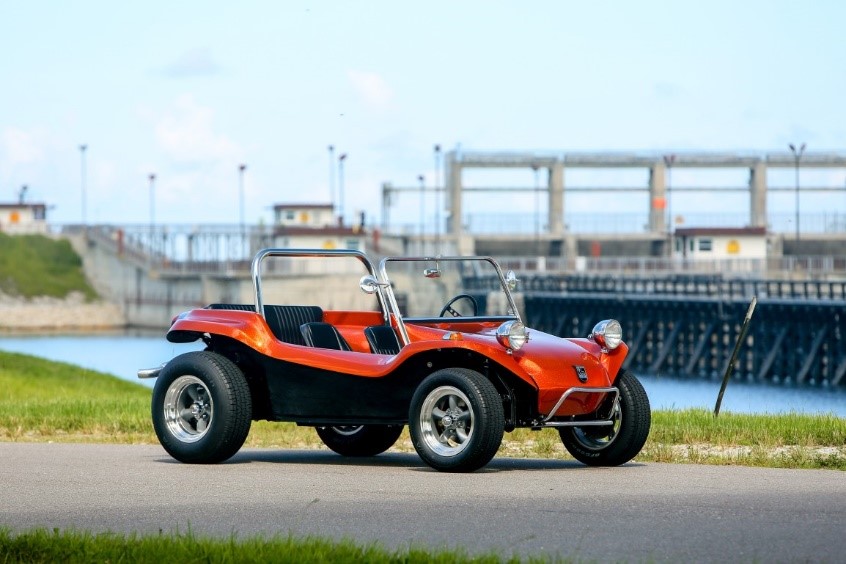
1968 Meyers Manx. Ryan Merrill © 2019 Courtesy of RM Sotheby's.
Early, pre-serial number example:
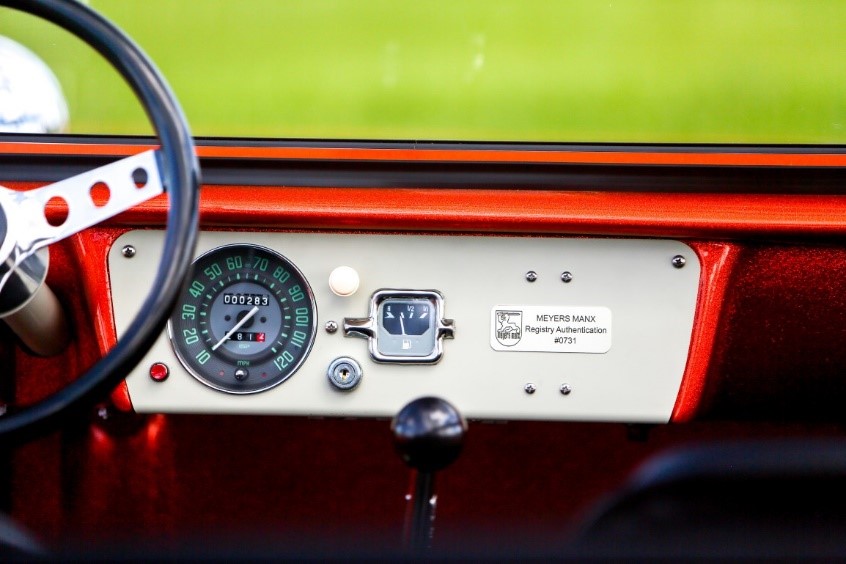
1968 Meyers Manx. Ryan Merrill © 2019 Courtesy of RM Sotheby's.
The Manx on offer is believed to be one of the first few hundred pre-serial number examples produced in 1968. A plaque mounted on the dashboard from the Meyers Manx Registry, as well as a certificate of authenticity signed by Bruce Meyers, verify its heritage as a true Meyers Manx.
Comprehensive frame off restoration:
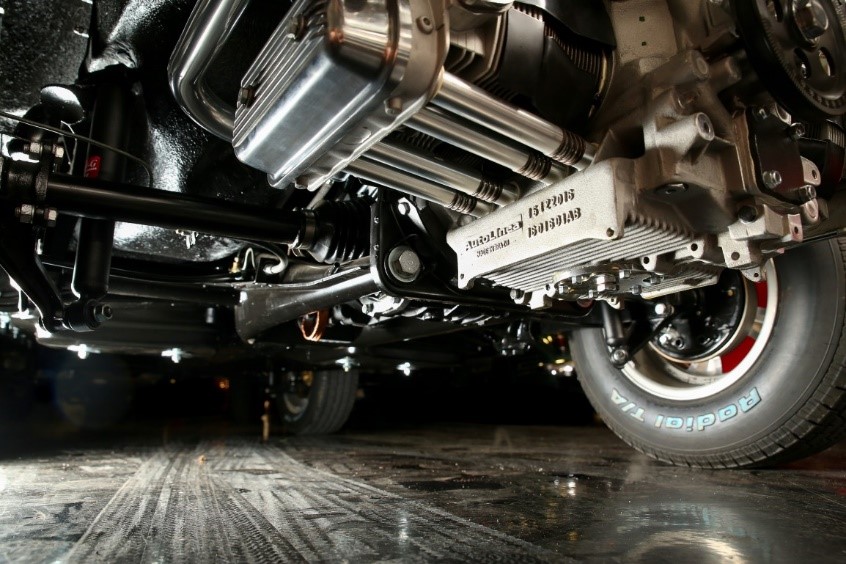
1968 Meyers Manx. Ryan Merrill © 2019 Courtesy of RM Sotheby's.
A recent and thorough, no-expense-spared frame off restoration was conducted by a Volkswagen and Porsche specialist in North Carolina. It was finished in its original color of orange with glimmering Big Daddy Roth paint. A number of new factory exterior components were utilized including the windshield, front bumper, stainless steel roll bar and Meyers Manx license-plate frame.
Period Correct Components:
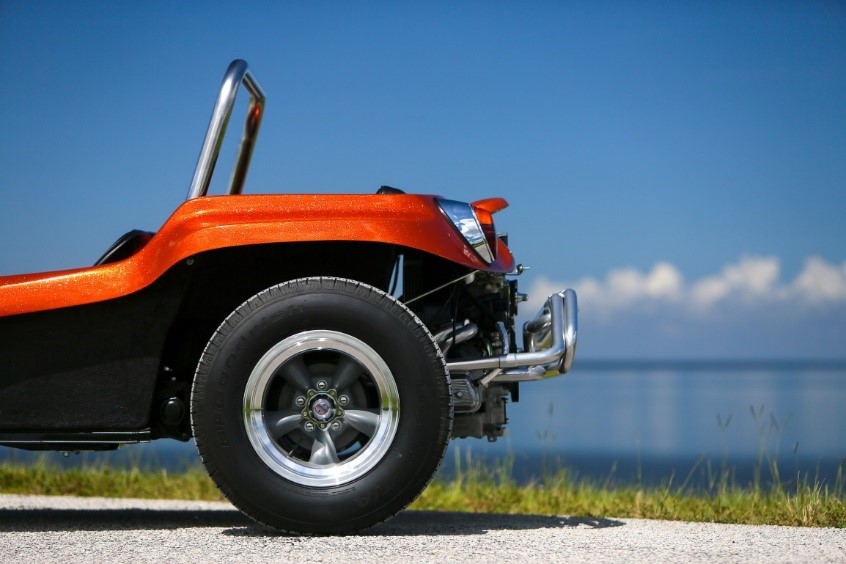
1968 Meyers Manx. Ryan Merrill © 2019 Courtesy of RM Sotheby's.
The restoration was completed with correct Deist headlights, chromed Volkswagen Beetle taillights, a Monza-style gas cap and American Racing wheels correctly mounted without wheel adapters.
Powerful front disc brakes:
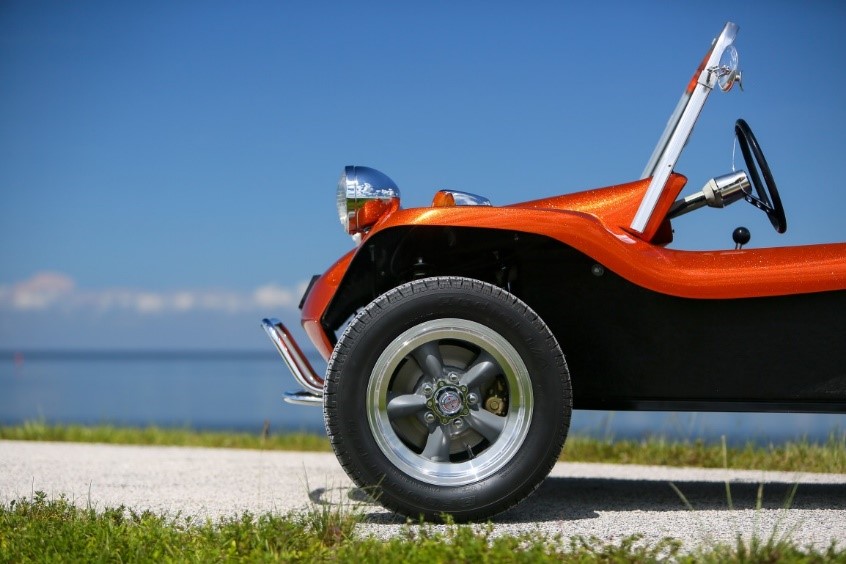
1968 Meyers Manx. Ryan Merrill © 2019 Courtesy of RM Sotheby's.
The front disk brakes and rear drum brakes provide ample power to bring the lightweight Manx to a halt, whether on the highway or while conquering the dunes. It is noted on the mechanical inspection report that during the test drive the brakes performed flawlessly, with no pull to either side while being engaged.
Professionally built four-cylinder boxer engine:
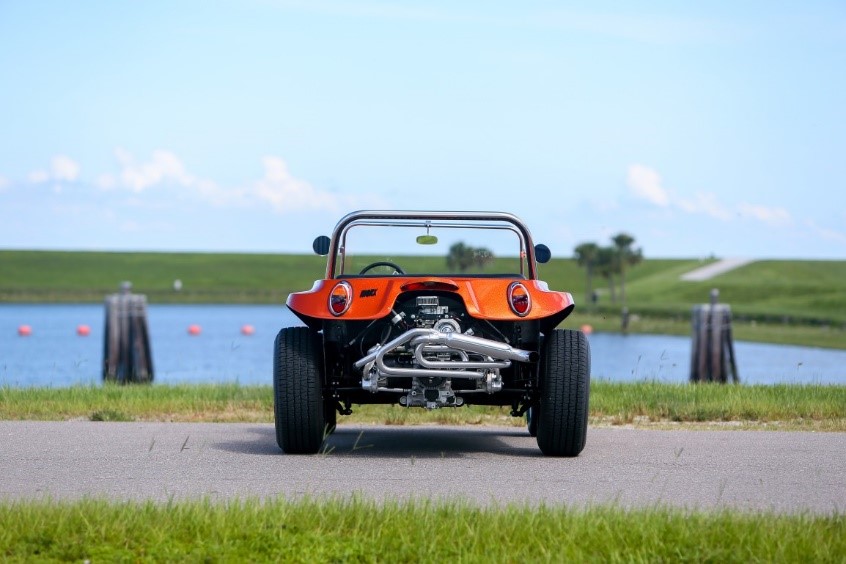
1968 Meyers Manx. Ryan Merrill © 2019 Courtesy of RM Sotheby's.
The Manx is powered by a 1,914 cc horizontally opposed four-cylinder engine equipped with a progressive two-barrel carburetor and featuring an electronic distributor professionally built by PowerHaus in Torrance, California. In July of 2018, they began with a new, zero-mile long block and bored the engine case to accommodate 94mm cylinders and employed all new components to assemble the completed engine, capable of 100 horsepower. A polished ceramic coated Stinger exhaust adds a distinctive exhaust note and matches the chrome accents nicely.
Four speed manual transmission:
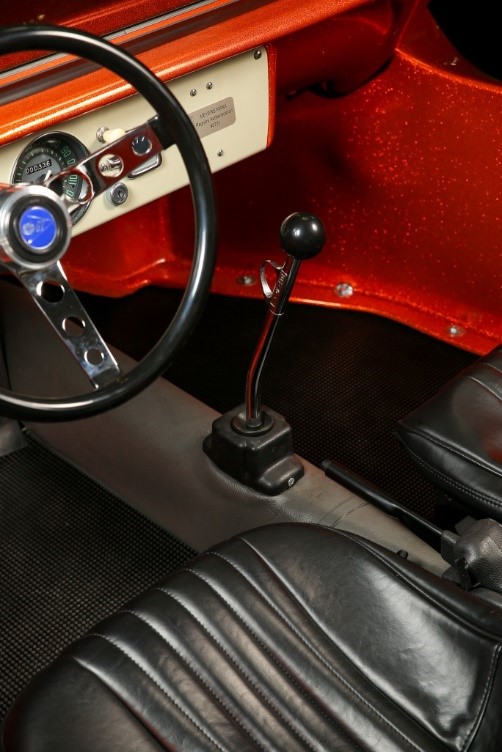
1968 Meyers Manx. Ryan Merrill © 2019 Courtesy of RM Sotheby's.
The engine is paired to a lightened 200mm flywheel and four speed manual transmission with an EMPI short-throw shifter for direct and enjoyable driving. The power is driven to the rear wheels through rugged Rancho Pro-street axles.
Front bucket seats with harness:
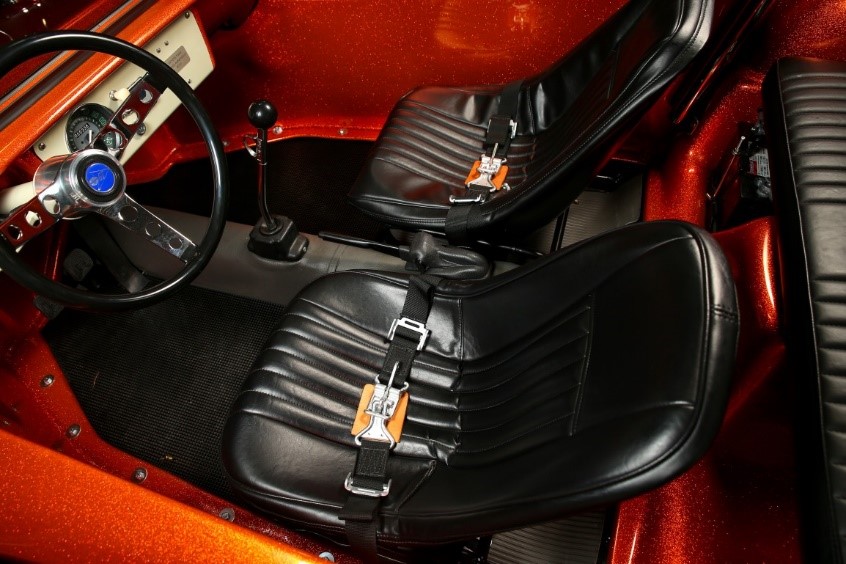
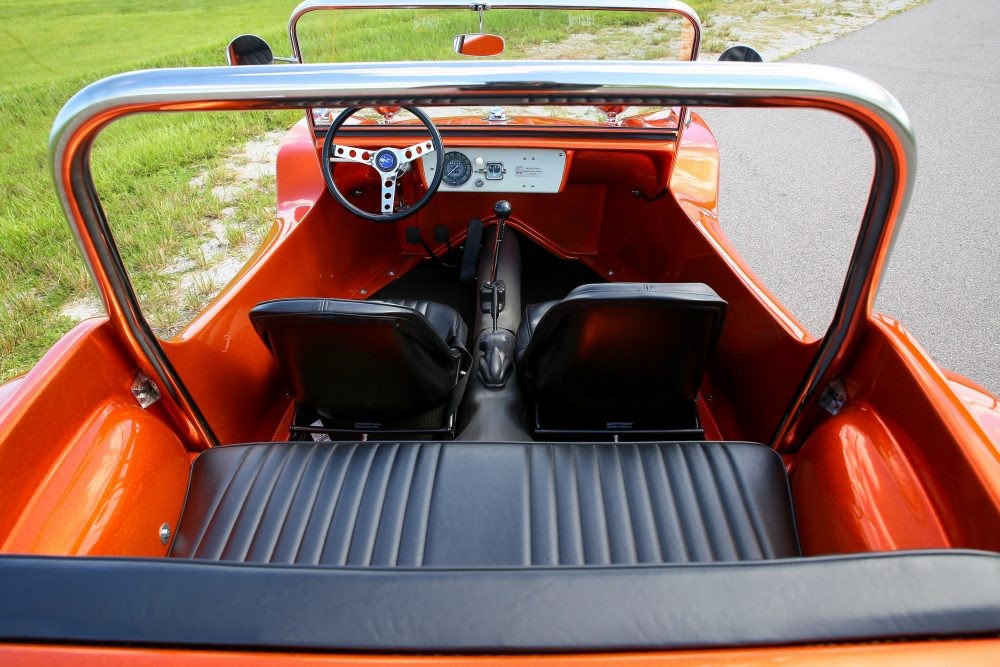
1968 Meyers Manx. Ryan Merrill © 2019 Courtesy of RM Sotheby's.
The front bucket seats are fully adjustable and feature racing style lap belt harnesses to keep the driver and passenger safely in place. The matching rear bench seat adds seating for two additional passengers and the stainless steel roll bar adds rigidity and added safety. A small diameter EMPI GT steering wheel was mounted, an ISP 120 mph speedometer and black floor mats round out the minimalist interior.
An exciting opportunity to own an American icon:
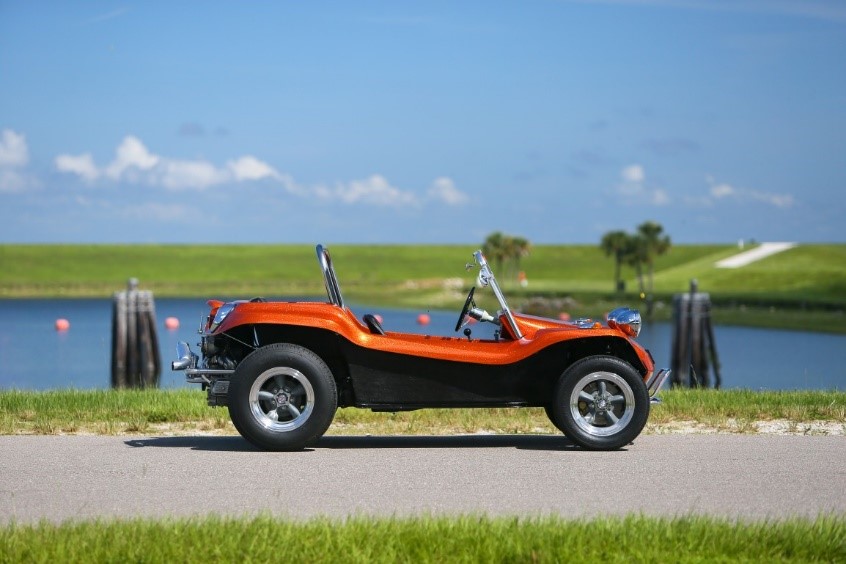
1968 Meyers Manx. Ryan Merrill © 2019 Courtesy of RM Sotheby's.
The Meyers Manx embodies the fun-loving spirit of the late 60s West Coast automotive culture.
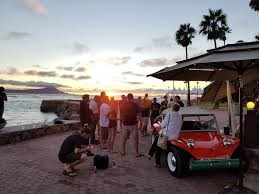
This example has left no nut or bolt untouched and is certain to bring a smile and entice those of all ages with its charm and character, whether displayed at vintage car events or enjoyed to its fullest both on and off road.
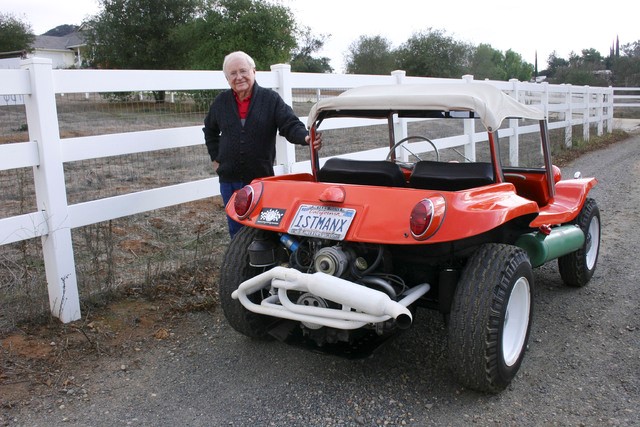
The King of Cool's coolest car? Dune buggy driven by Steve McQueen in 1968 hit film “The Thomas Crown Affair” to be sold at Florida auction. By Rob Hull for Thisismoney.co.uk. Published: 15 August 2019.
One of the most iconic cinema cars driven by Steve McQueen will go under the hammer at a prestigious classic motor auction in Florida next year, it has been confirmed.
The dune buggy that featured in 1968 classic The Thomas Crown Affair - the very car in which the King of Cool took Faye Dunaway on an exhilarating, white-knuckled ride - will be sold by Bonhams on 5 March 2020.
The vehicle's iconic driving scenes on the beach of Massachusetts have become stuff of Hollywood legend - and collectors will have the chance to own it... if they can afford the 'extraordinary sum' it's expected to fetch.
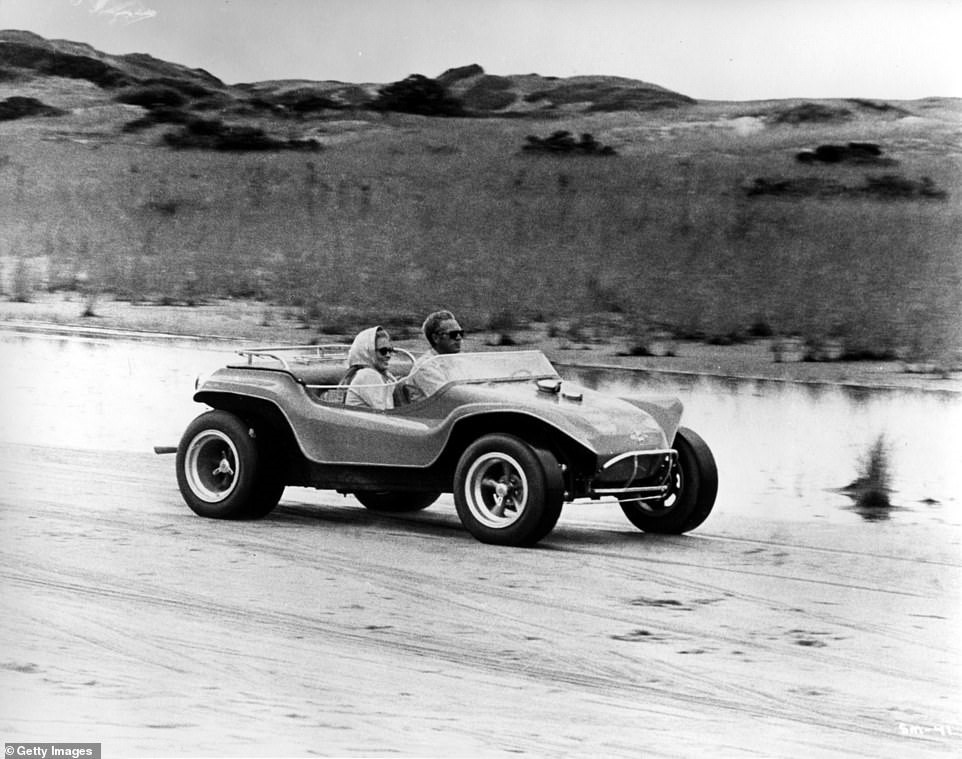
Faye Dunaway and Steve McQueen in an orange Dune Buggy in the movie 'The Thomas Crown Affair'.
The car will be sold at Bonhams' Amelia Island Auction held at the Fernandina Beach Golf Club, it was confirmed this week.
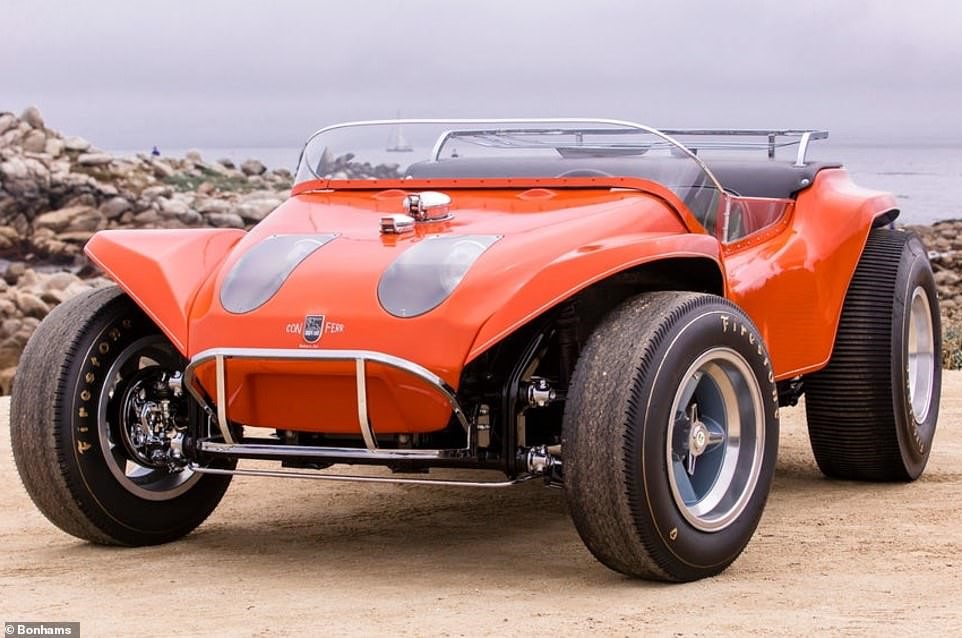
Is it the dune buggy the King of Cool's coolest movie car ever? There have been a few, including the Ford Mustang from Bullitt and Porsche 917 featured in Le Mans.
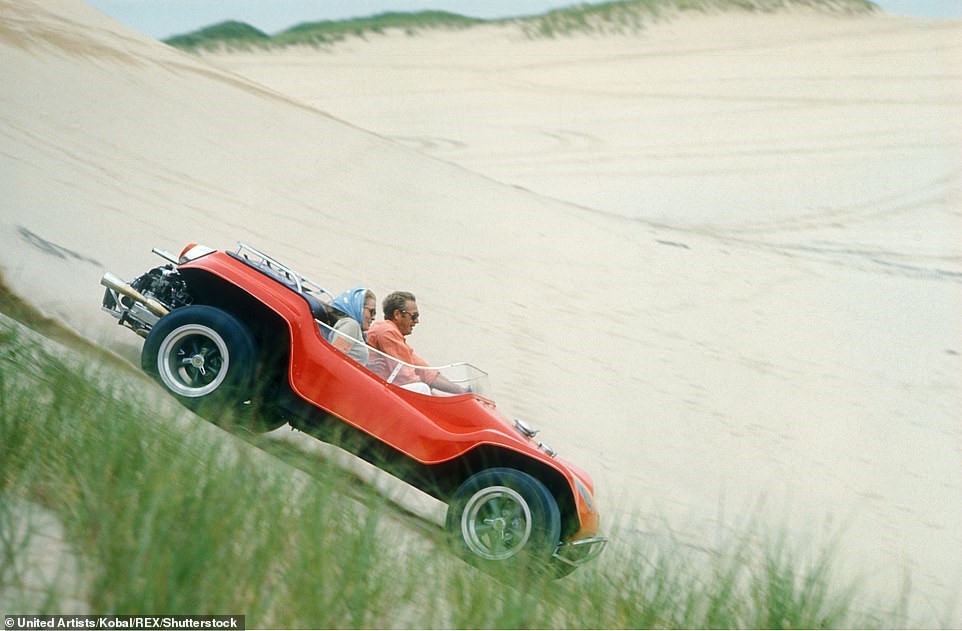
McQueen famously drove the car in all the white-knuckle scenes for the film, refusing to have a stunt double performance the fast-paced footage.
But this film car is like no other, having been commissioned by the King of Cool himself.
Before filming started, Steve McQueen enlisted the help of motor legend Pete Condos of Con-Ferr fame to build this totally unique vehicle.
Bonhams now describes it as 'the most famous 'prop' of all from The Thomas Crown Affair'.
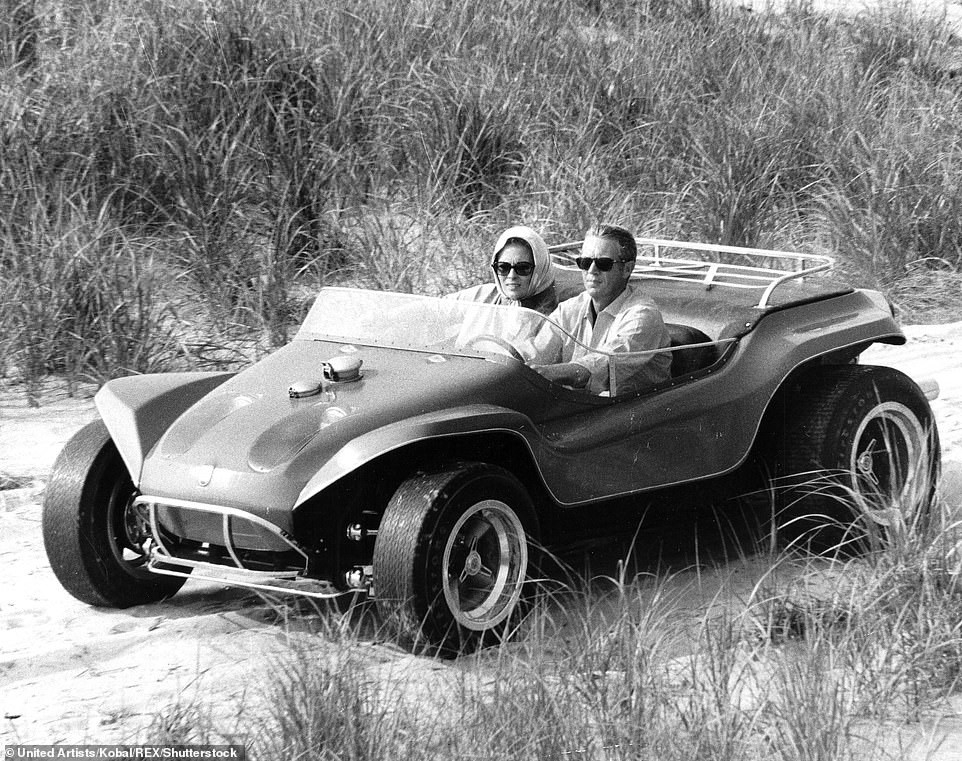
The car is based on a Meyers Manx - the original dune buggy - but was unique and partly designed by Steve McQueen himself.
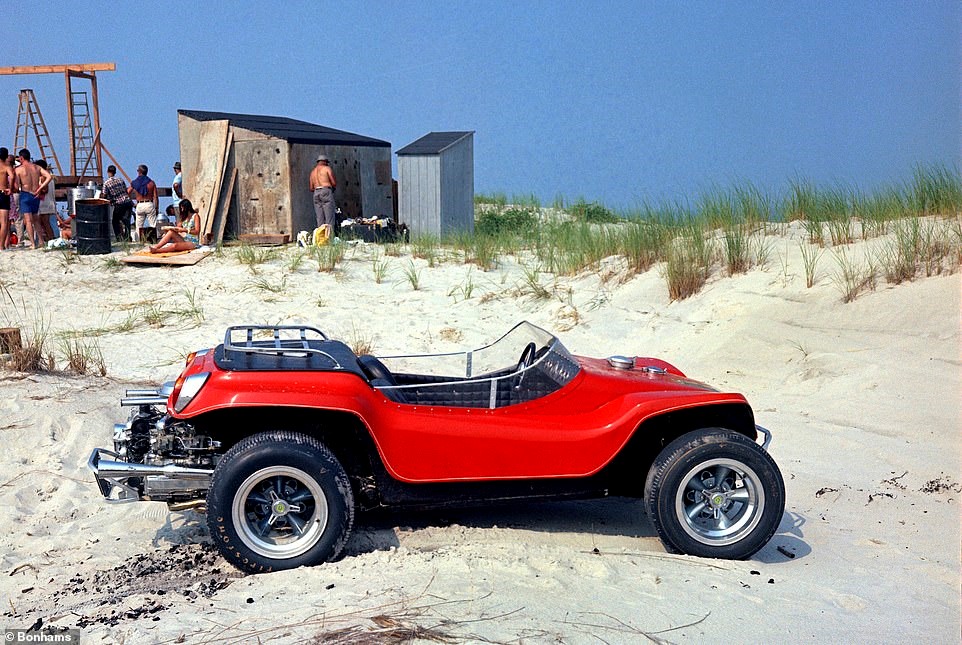
Underneath is mostly a VW Beetle. Fitting an upgraded engine and big wheels with chunky tyres means no sand dune is too difficult to tackle for this machine.
In a period documentary about the movie, McQueen explained that the car was fitted with a larger-capacity 2.3-litre flat-six Chevrolet Corvair engine (Meyes Manx usually used a VW flat-four-cylinder motor).
'Crown lives at the beach and he has a dune buggy. I helped them design it, so I'm kind of proud of that,' he said.
'It's set on a Volkswagen chassis with big ol' wide weenies – big wide tyres on mag wheels, Corvair engine stuffed in the back. It's very light, you know (because of the fiberglass body). It's pulling about 230 horses and weighs about a thousand pounds.'
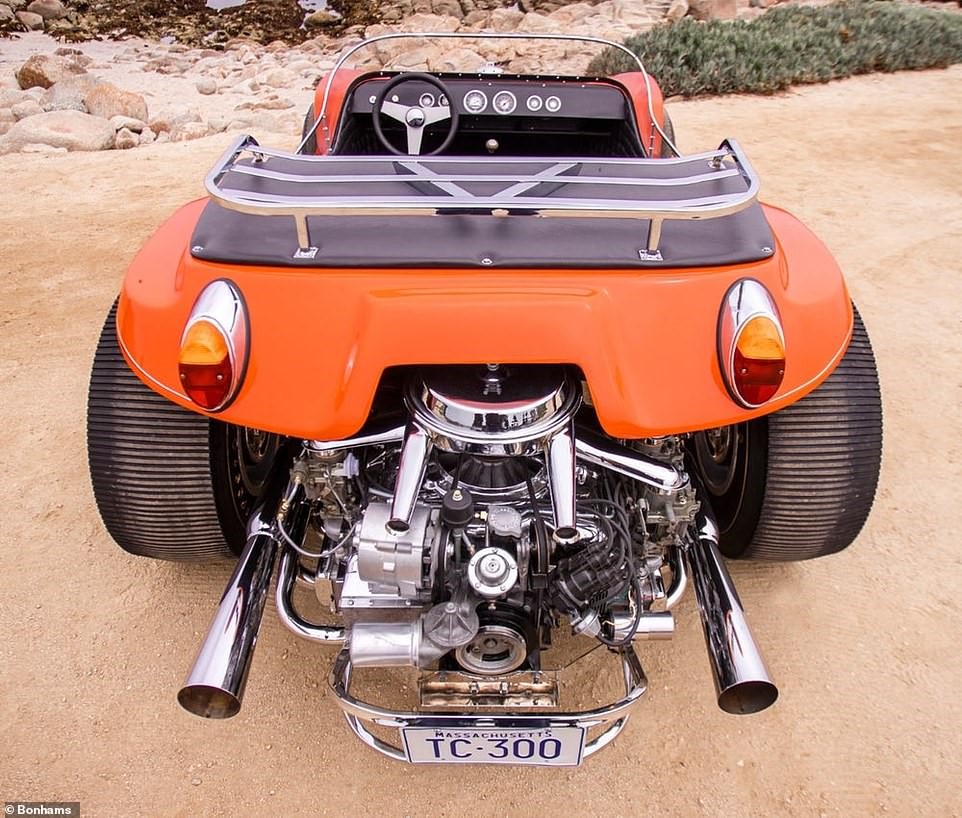
According to the King of Cool, the car was retrofitted with this 6-cylinder Chevrolet Corvair engine to increase performance. He claimed it produced 230bhp at the time of filming.
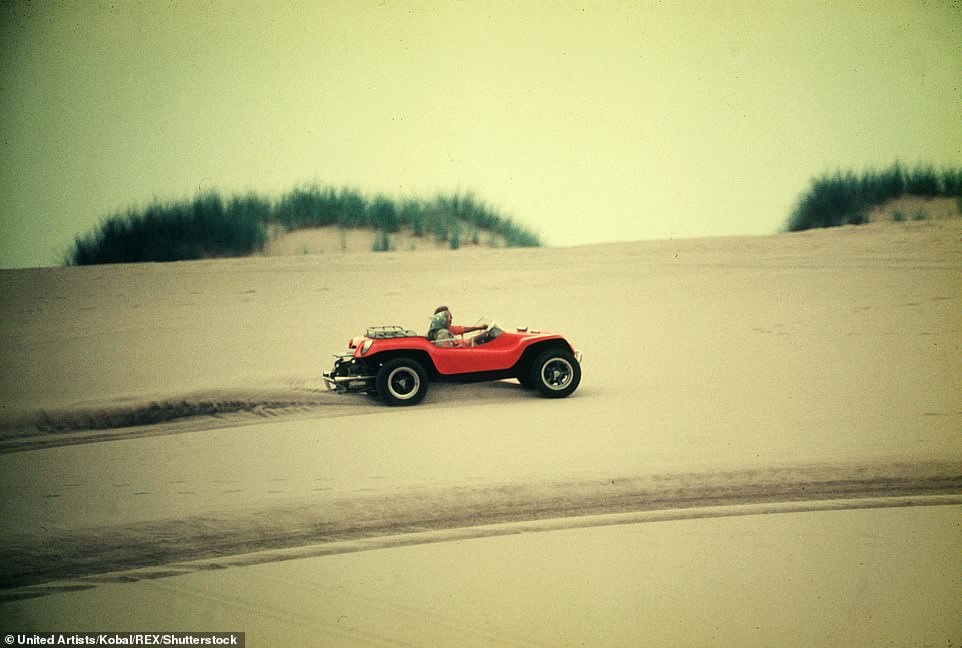
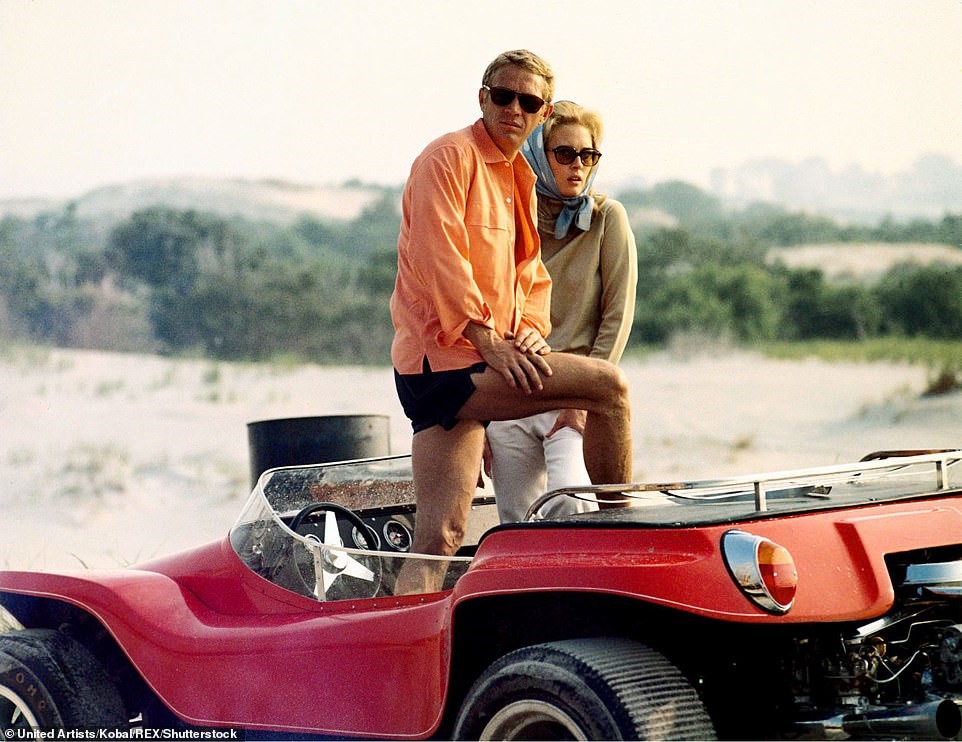
The dune buggy became one of the stars of the film, along with McQueens co-star, Faye Dunaway, who shot to A-list stardom following the success of the movie.
It proved a hit with cinema goers, with the Hollywood film captivated global audiences and essentially brought the Meyers Manx to the attention of the world.
As for the King of Cool, the driving scene cemented his affinity for motoring and talent at the wheel, with the superstar masterfully driving the buggy with no stunt double for the entirety of the footage.
Ahead of the sale, it will be showcased at the upcoming Bonhams auction at Quail Lodge in Carmel, California, this week - where one of McQueen's personal 1949 Chevy 3100 pick-up trucks will also be sold to the highest bidder.
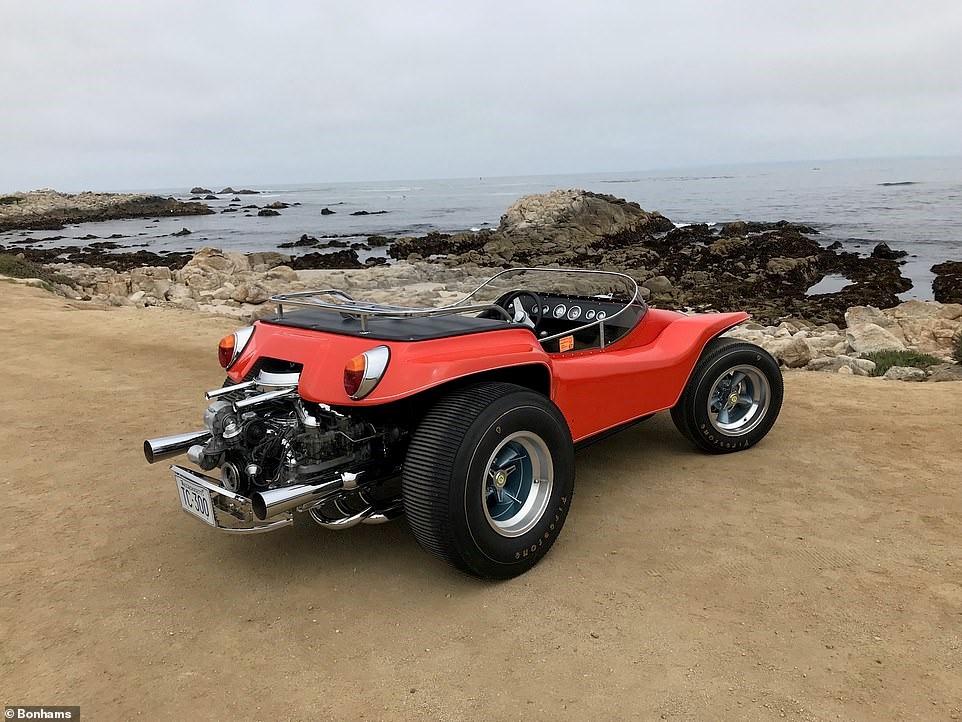
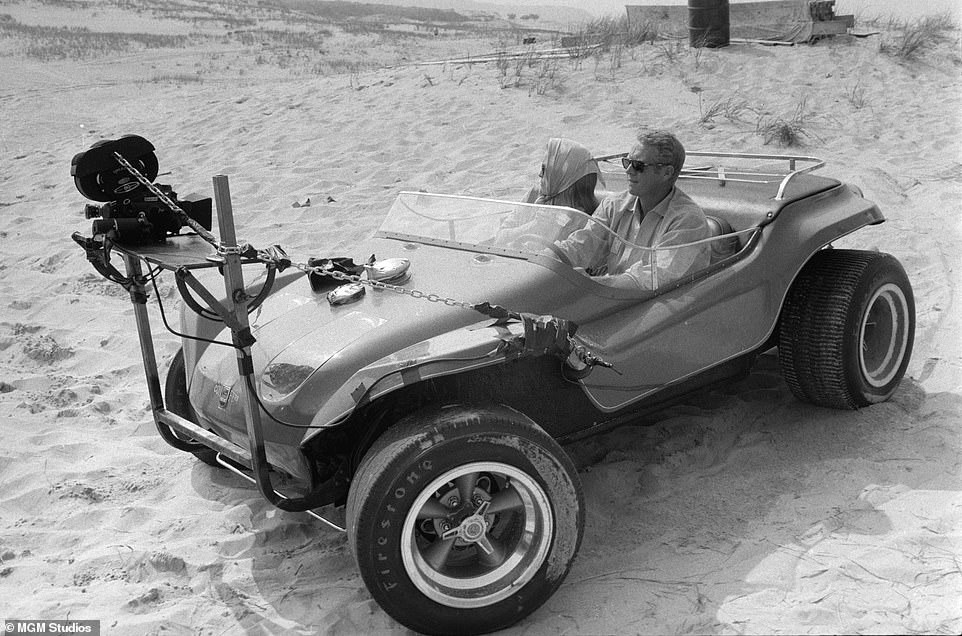
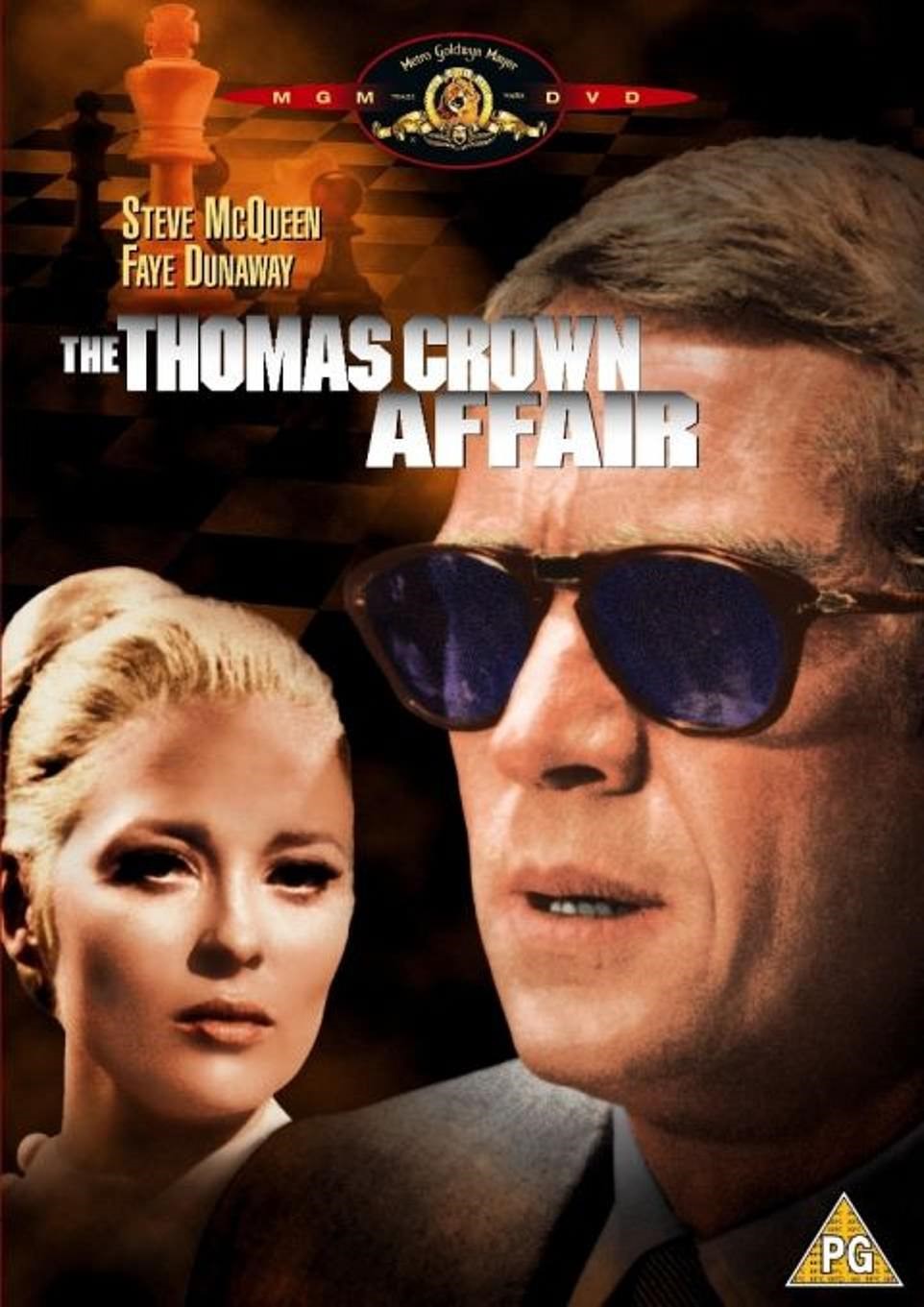
The sale of the iconic film car won't be the first King of Cool motors consigned by the auction house.
Bonhams sold the Rolls-Royce Silver Shadow from the same film for a then world record price of $70,200 (£58,070) in 2006.
At the same event, the Persol sunglasses worn by McQueen in the movie also achieved a world record sum.
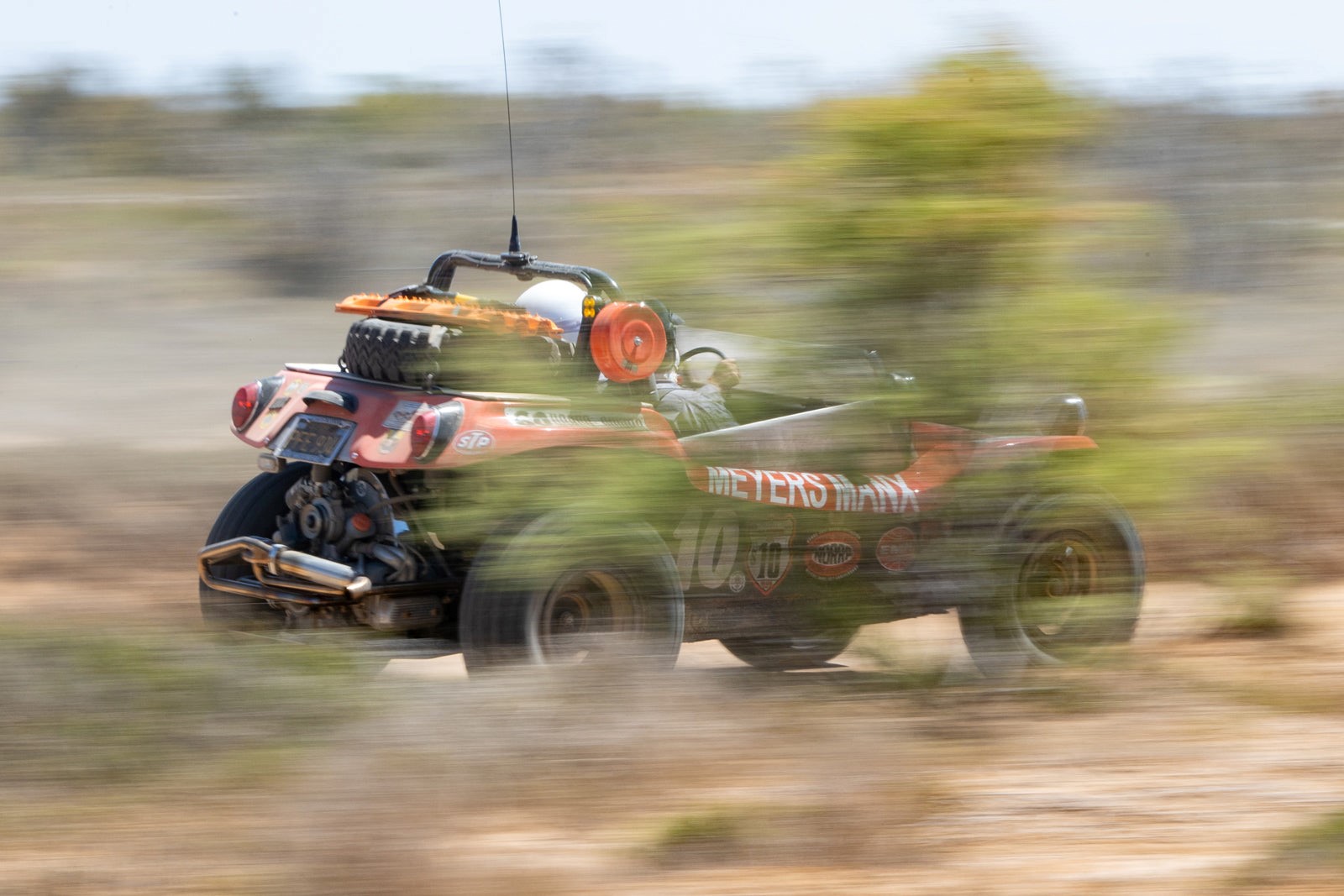
Jim Chamberlain and Jagger Meyers cruising towards the coast of the Baja Peninsula in their freshly built buggy powered by an air cooled Volkswagen motor fitted with Remastered Sidewinder Exhaust.
Rediscovering the joy of rolling your own: the NORRA Mexican 1000 and the DIY spirit of Meyers Manx. June 12, 2024.
The NORRA Mexican 1000 is not only a grand adventure and a pilgrimage to dirt. It is a celebration of the raw beauty of Baja California. This year the Meyers Manx team, including legendary driver Jim Chamberlain and Bruce Meyers' grandson, Jagger, set out to honor the 60th anniversary of the brand by embarking on this storied journey.
The NORRA Mexican 1000, known as ‘The Happiest Race on Earth,’ is a rugged test of endurance and skill, starting in Ensenada and winding its way to San Felipe, Bahía de Los Ángeles, San Ignacio, Loreto, La Paz and, finally, San José del Cabo. Each leg of the race offers a unique challenge and an opportunity to experience the breathtaking landscapes of Baja California.
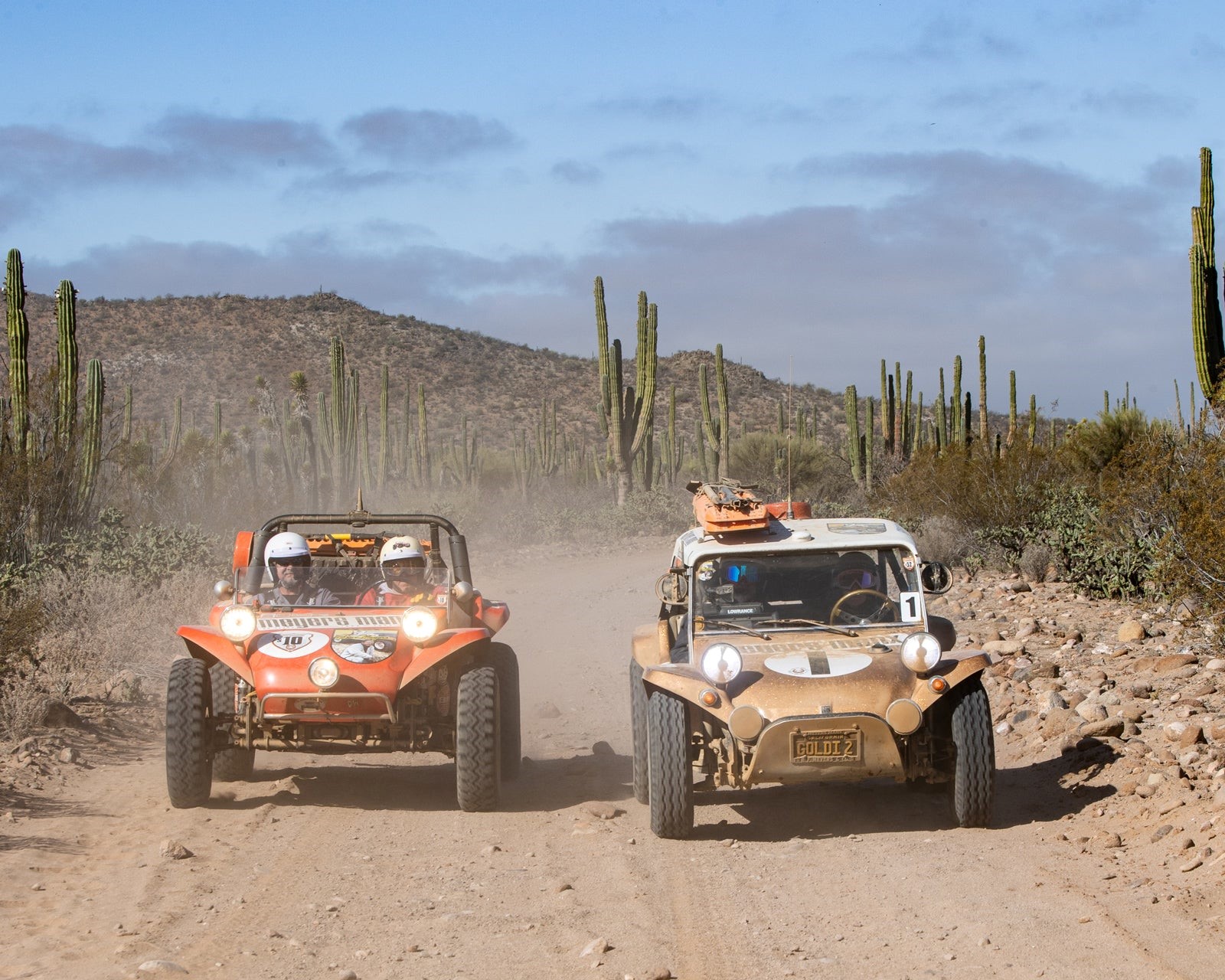
Freshly built Meyers Manx Remastered Classic Kit racing alongside Goldi 2. Photo by Michael Potiker.
For Jim Chamberlain and Jagger each day began with the roar of engines and the promise of adventure. They drove their freshly built Meyers Manx Remastered Classic Kits through rocky trails along the Sea of Cortez, across vast desert expanses and down the sandy beaches where the cool sea breeze kept their air-cooled engines running smoothly. Along the way they met locals, handing out stickers and sharing stories with fans who have made collecting these mementos a cherished tradition.
A legacy forged in fiberglass
While an incredibly difficult project, the tradition of building your own Meyers Manx began in the 1960s when Bruce Meyers introduced the world to the original fiberglass-bodied dune buggy. Built on the chassis of the Volkswagen Beetle, the Meyers Manx was lightweight, durable and perfectly suited for off-road adventures. This DIY approach not only made these buggies accessible but also fostered a deep connection between the builders and their vehicles. To build a Meyers Manx it can take from the hundreds to thousands of hours.
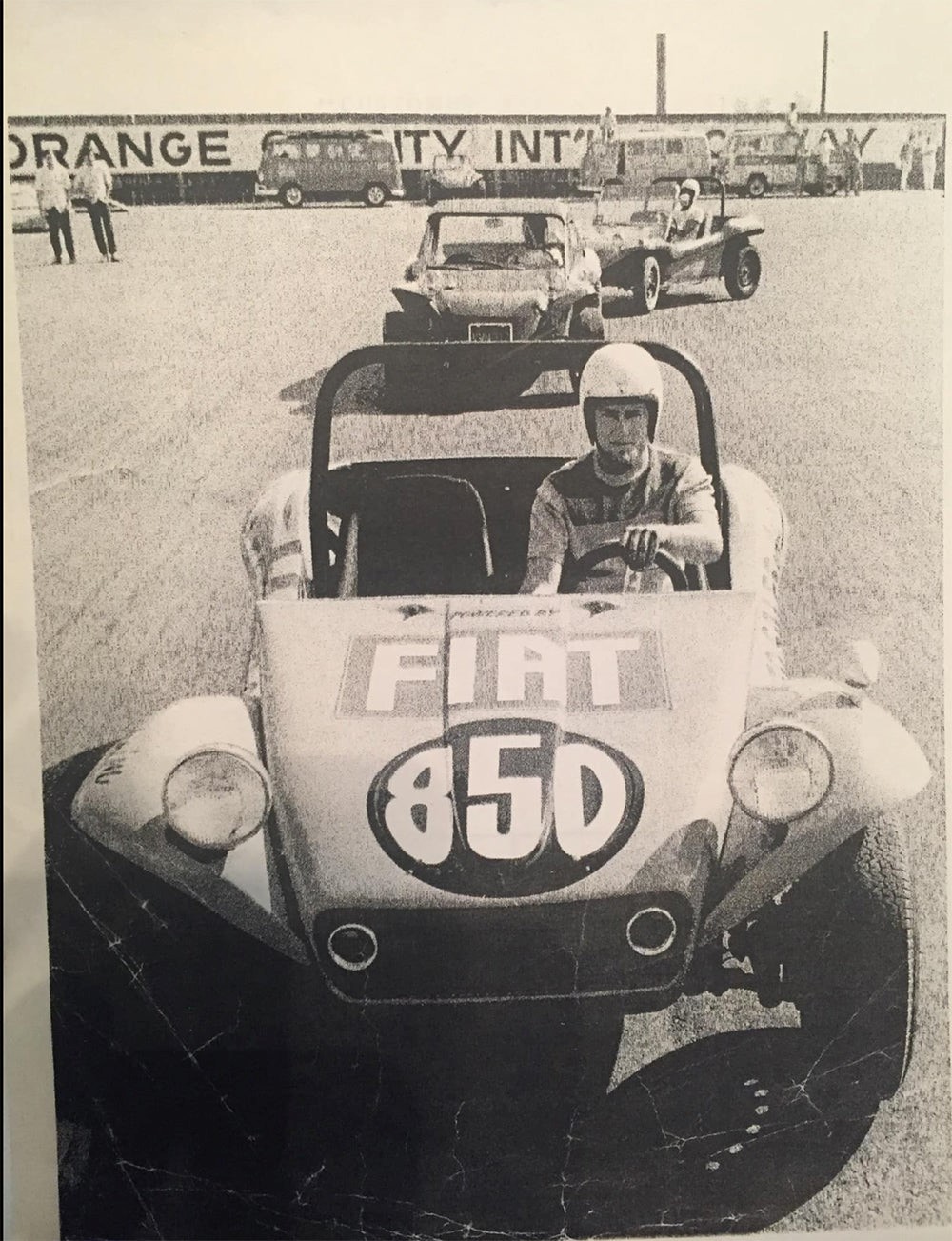
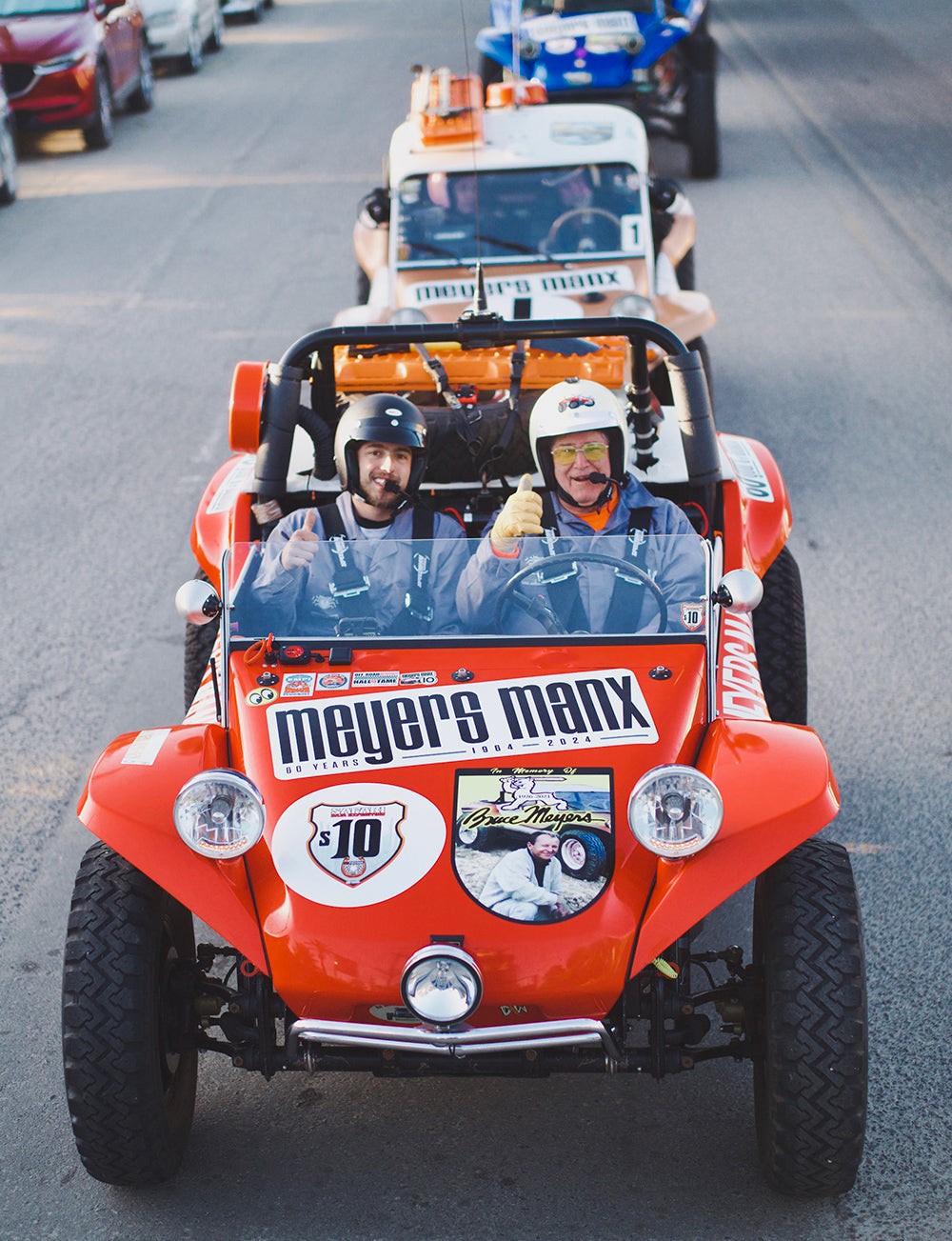
Jim Chamberlain in two buggies of his own creation, above Fiat powered circa 1970’s, below built in 2024 with Lyman Scherer.
Jim Chamberlain, a pivotal figure in the Meyers Manx story, was instrumental in inventing the original Sidewinder exhaust as well as building the 1967 Baja 1000 winning Meyers Manx of Vic Wilson and Ted Mangels. This innovation not only enhanced the performance and sound of the buggies but also became a signature feature, beloved by enthusiasts for its distinctive roar and efficiency on the rugged terrains of Baja. This year Jim’s buggy was fitted with the remastered sidewinder exhaust, inspired by his original design and optimized using computational flow dynamics.
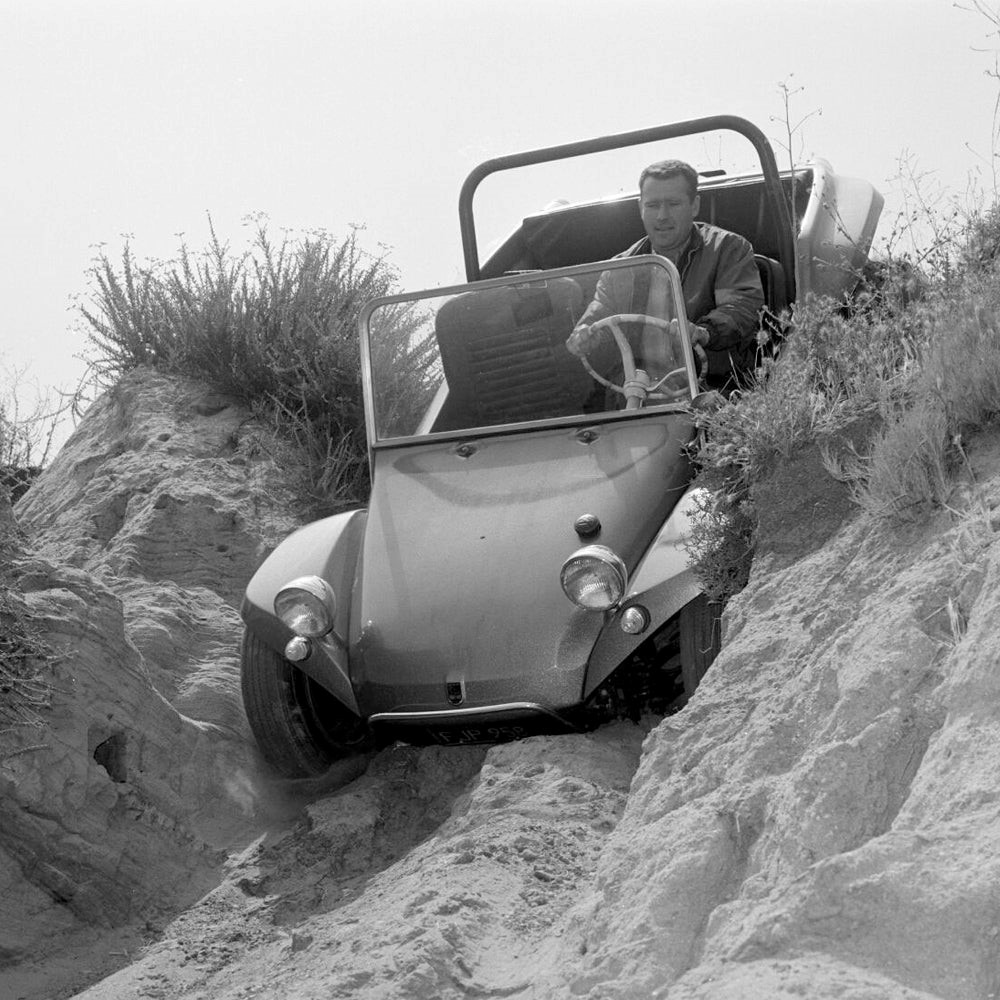
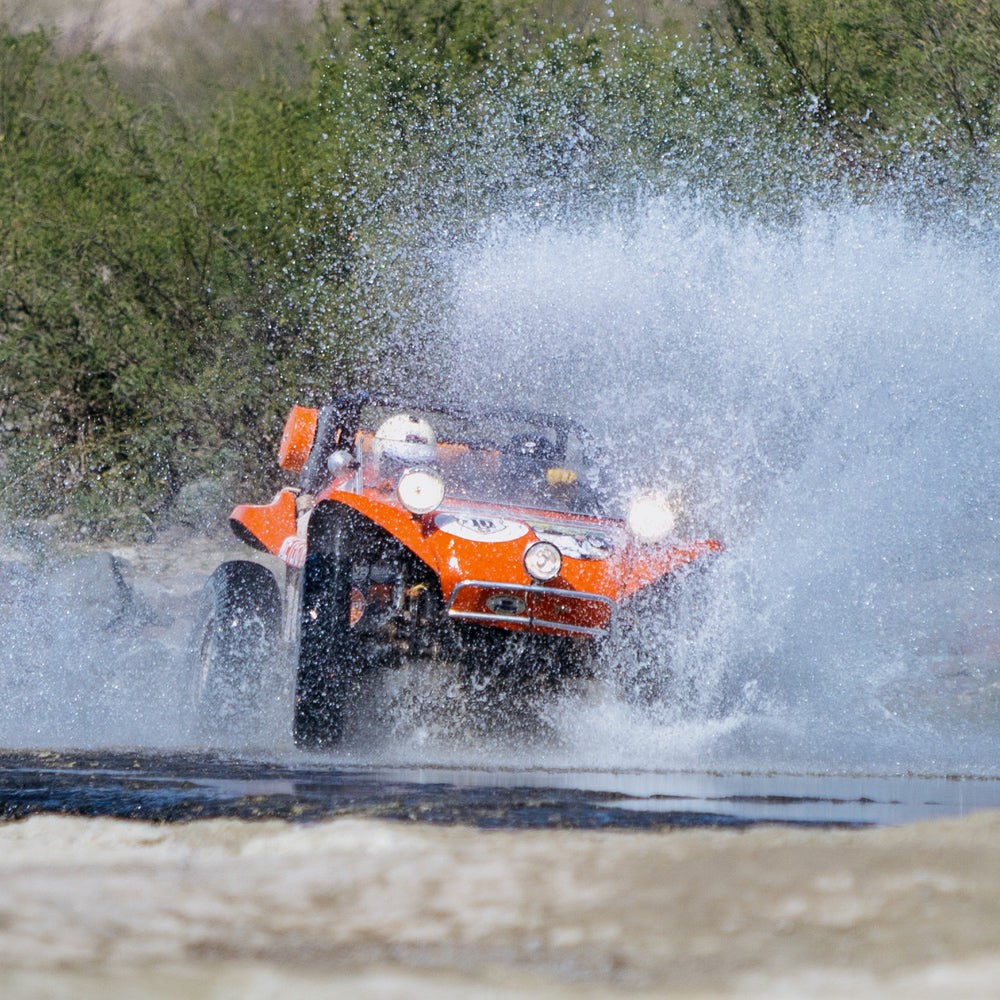
Above: Bruce Meyers testing an original Manx hand built in the 60’s. Below: Jagger Meyers washing the Baja dirt off his freshly built car, 2024.
The journey: more than just a race
Participating in the NORRA Mexican 1000 is a dream for many, but the real magic happens in the moments between the checkpoints. Each night, after a day of conquering the trails, the team would gather around, recounting the day’s adventures over plates of fresh Baja fish tacos and cold margaritas. The camaraderie, the shared stories and the laughter under the stars encapsulate the true spirit of the Meyers Manx community.
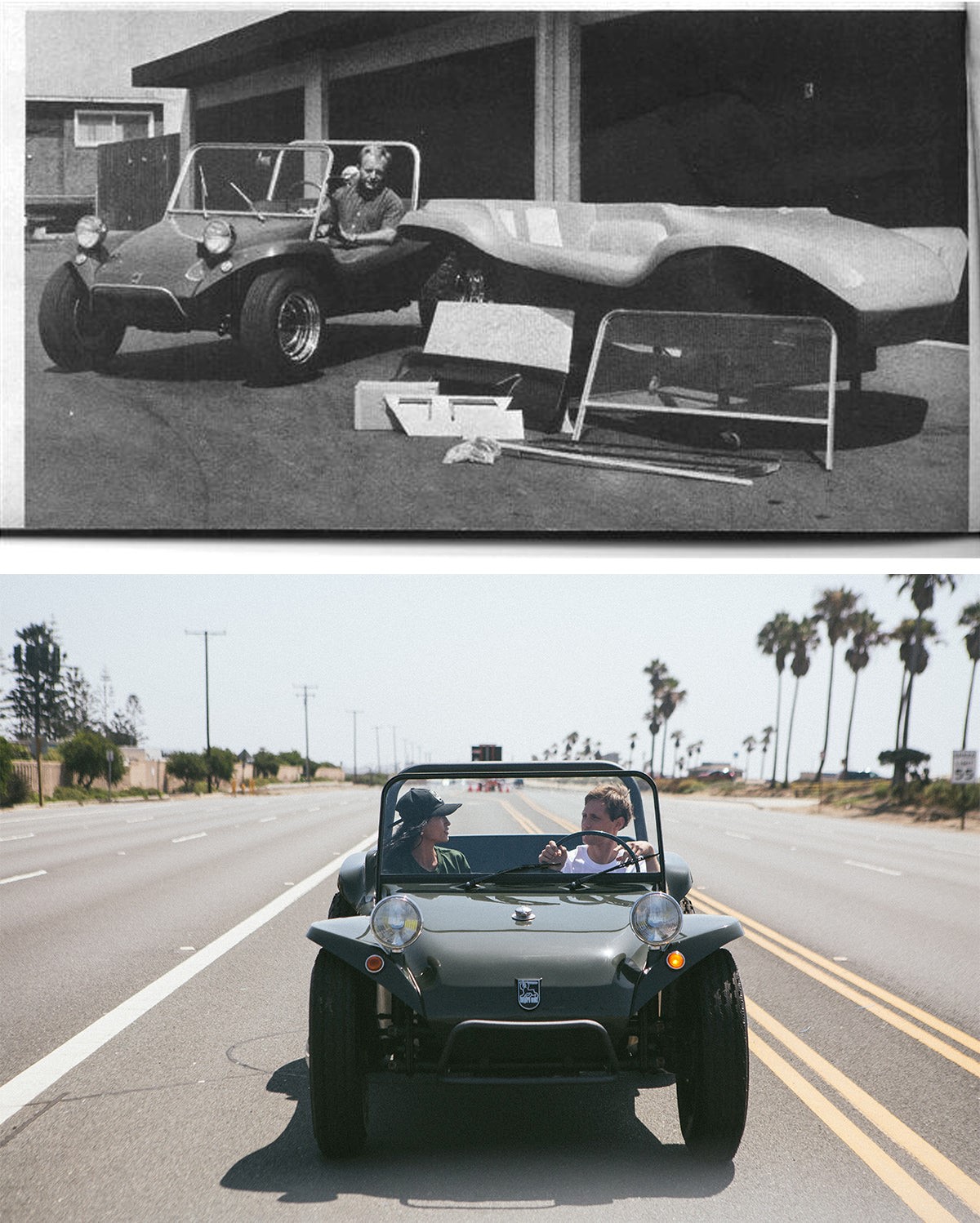
Top Image: Bruce Meyers at Newport Laminates, showcasing his self-assembly dune buggy kit, 1968. Bottom Image: Meyers Manx Classic Buggy cruising PCH, fiberglass body produced at Newport Laminates, 2022.
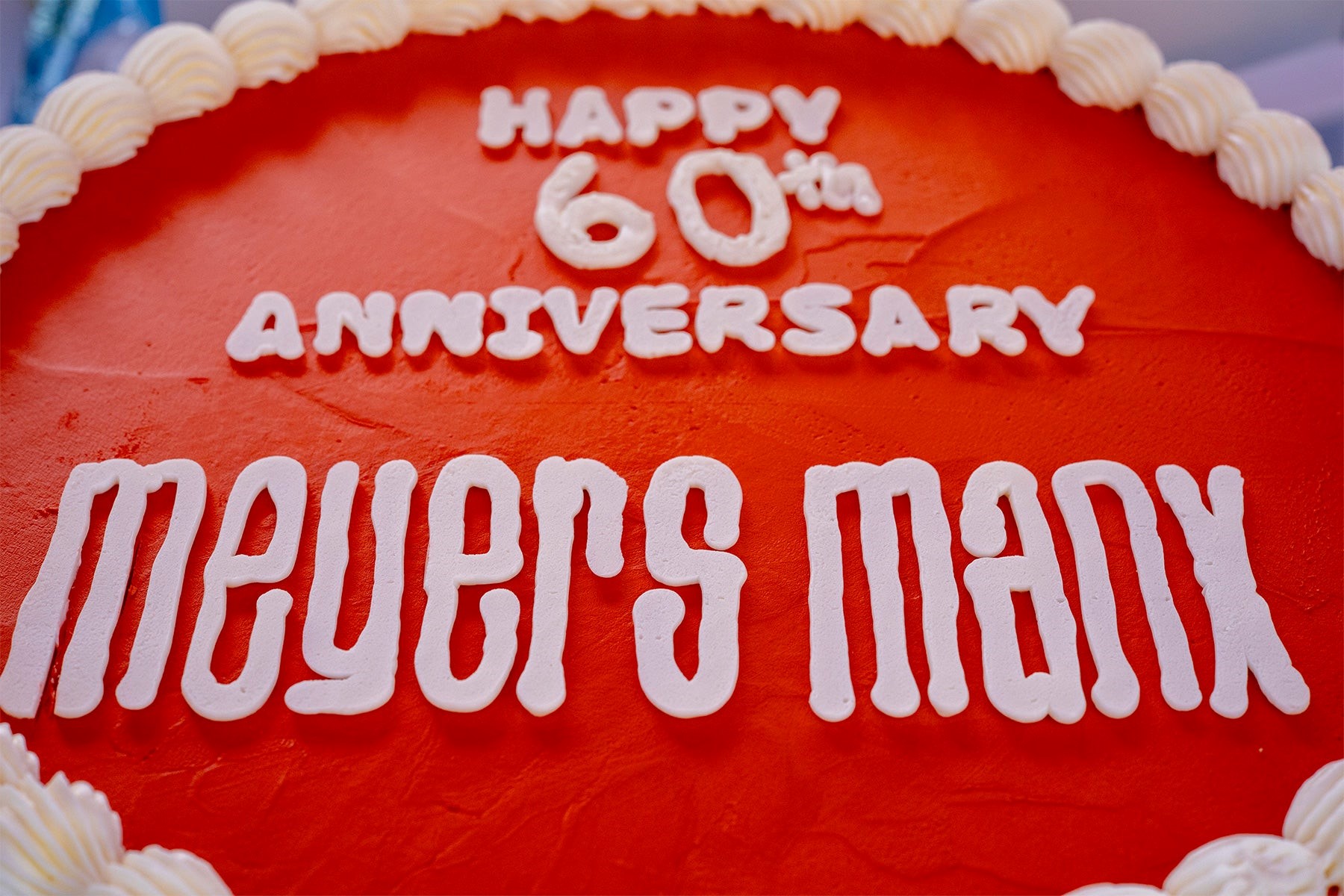
Celebrating 60 years: unveiling Old Red remastered at Big Bear Bash. July 25, 2024.
The Manx Club Big Bear Bash is always a highlight of our annual activities, but this year’s event held special significance as we celebrated the 60th Anniversary of Meyers Manx in the beautiful setting of Big Bear Lake, CA.
Making history: the largest Big Bear Bash ever
This year, we saw over 300 buggies and 600 participants, making it the largest Big Bear Bash to date. The festivities began on Wednesday, July 10th, with early registration. Thursday and Friday featured a variety of runs, from laid-back street rides to extreme off-road adventures. Saturday was packed with excitement, including the annual Show and Shine, a dessert potluck sponsored by Meyers Manx and the awards ceremony. The event concluded on Sunday with the Parade around Big Bear Lake, led by Winnie Meyers in the iconic Original Old Red.
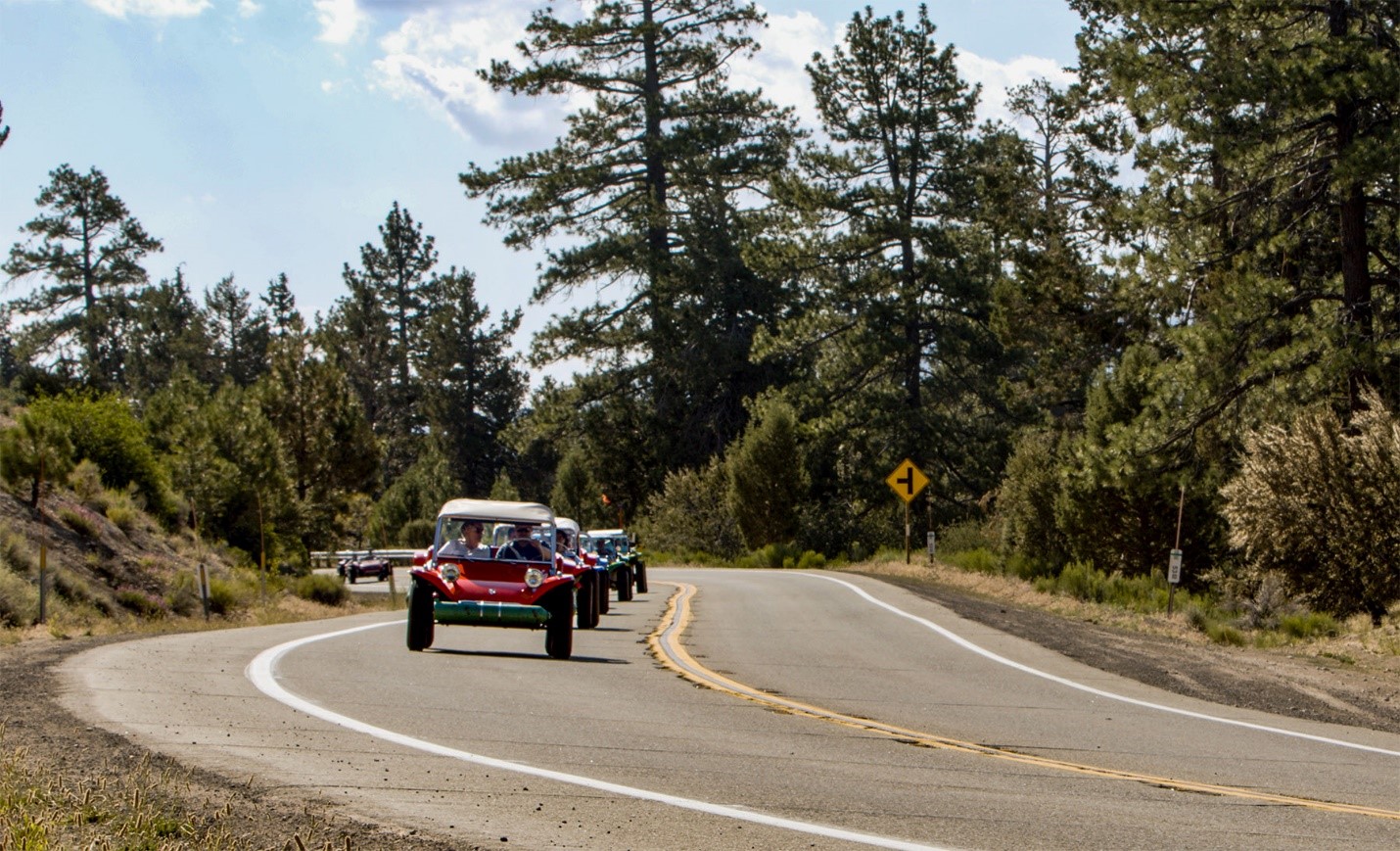
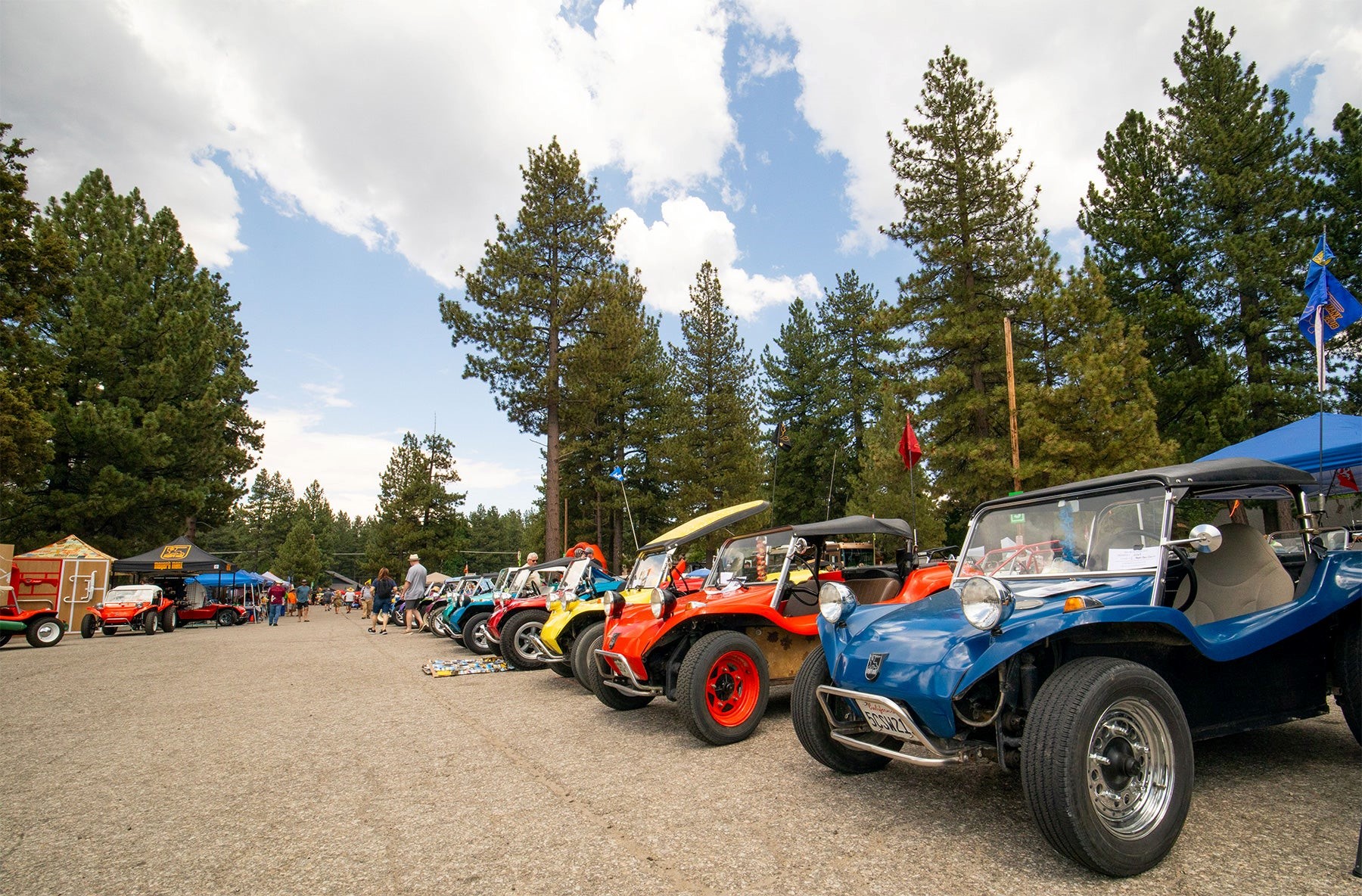
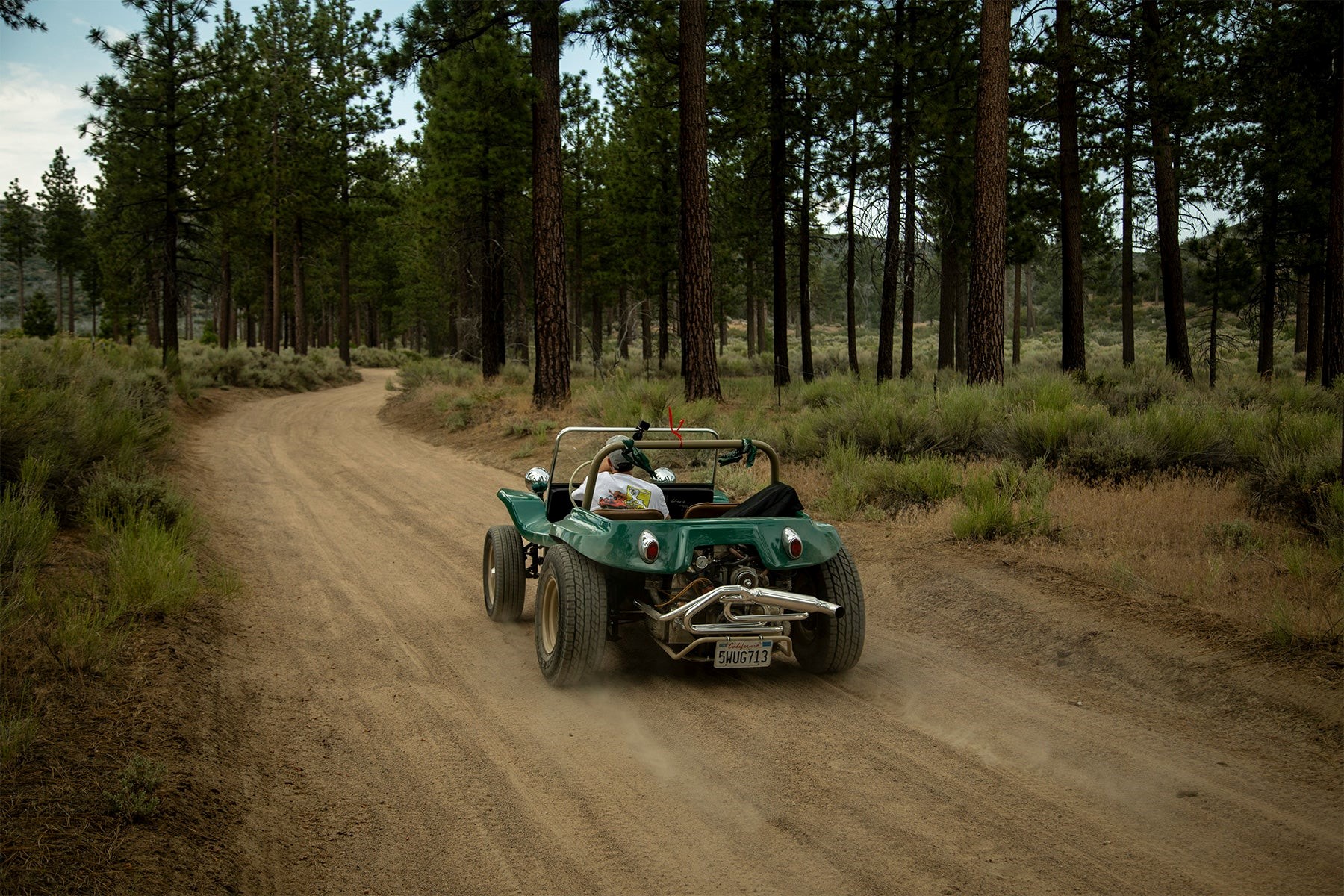
Relaunching an icon: introducing the remastered Old Red kit
To kick off our 60th Anniversary celebrations, we proudly launched the all-new Remastered Old Red Kit at the Big Bear Bash. Manx Club members had the exclusive first opportunity to purchase this limited-edition kit, which pays tribute to the Original Old Red while being modernized for today’s kit-building enthusiasts. With only 24 kits serialized and badged, half of them were sold within the first week.
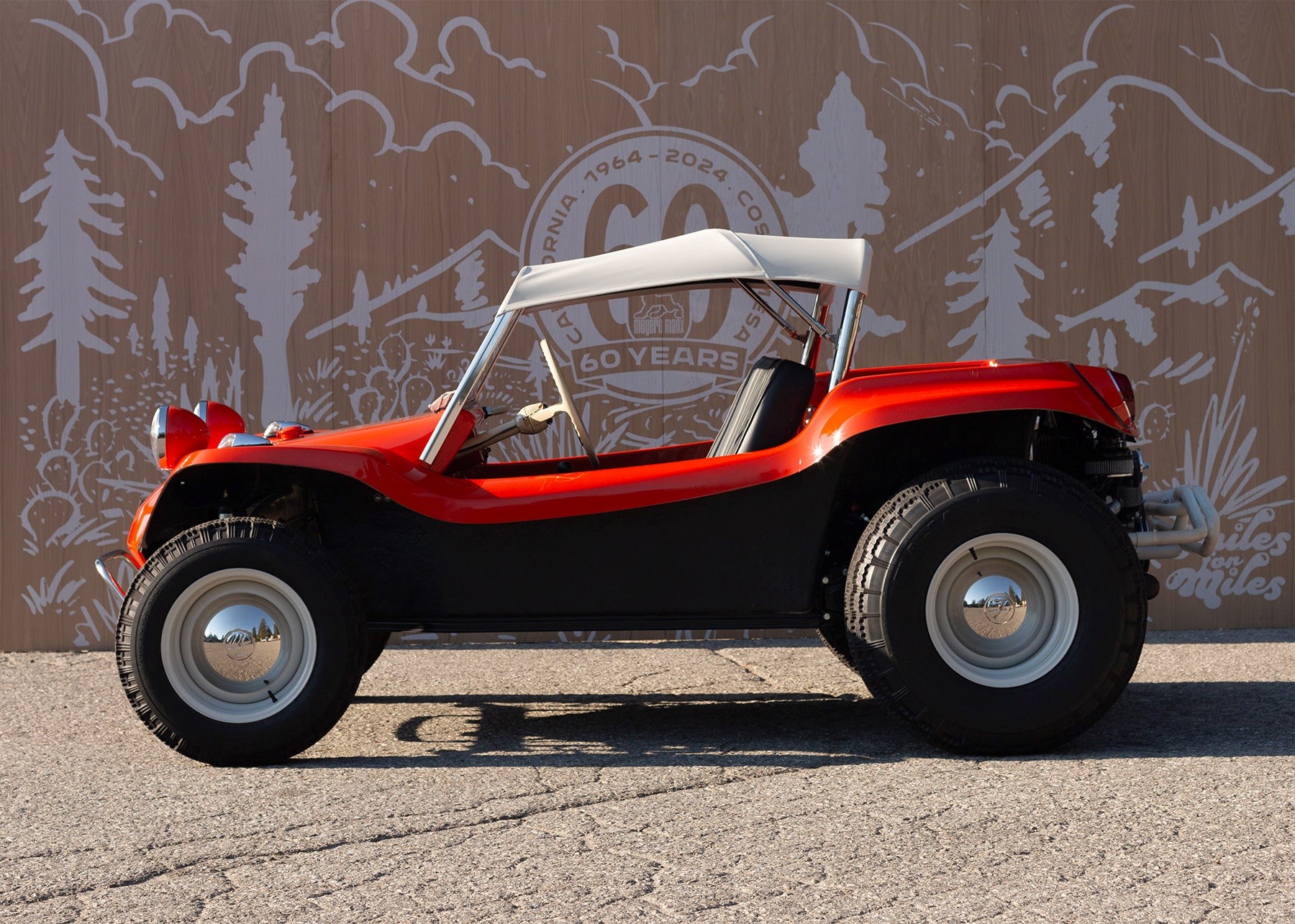
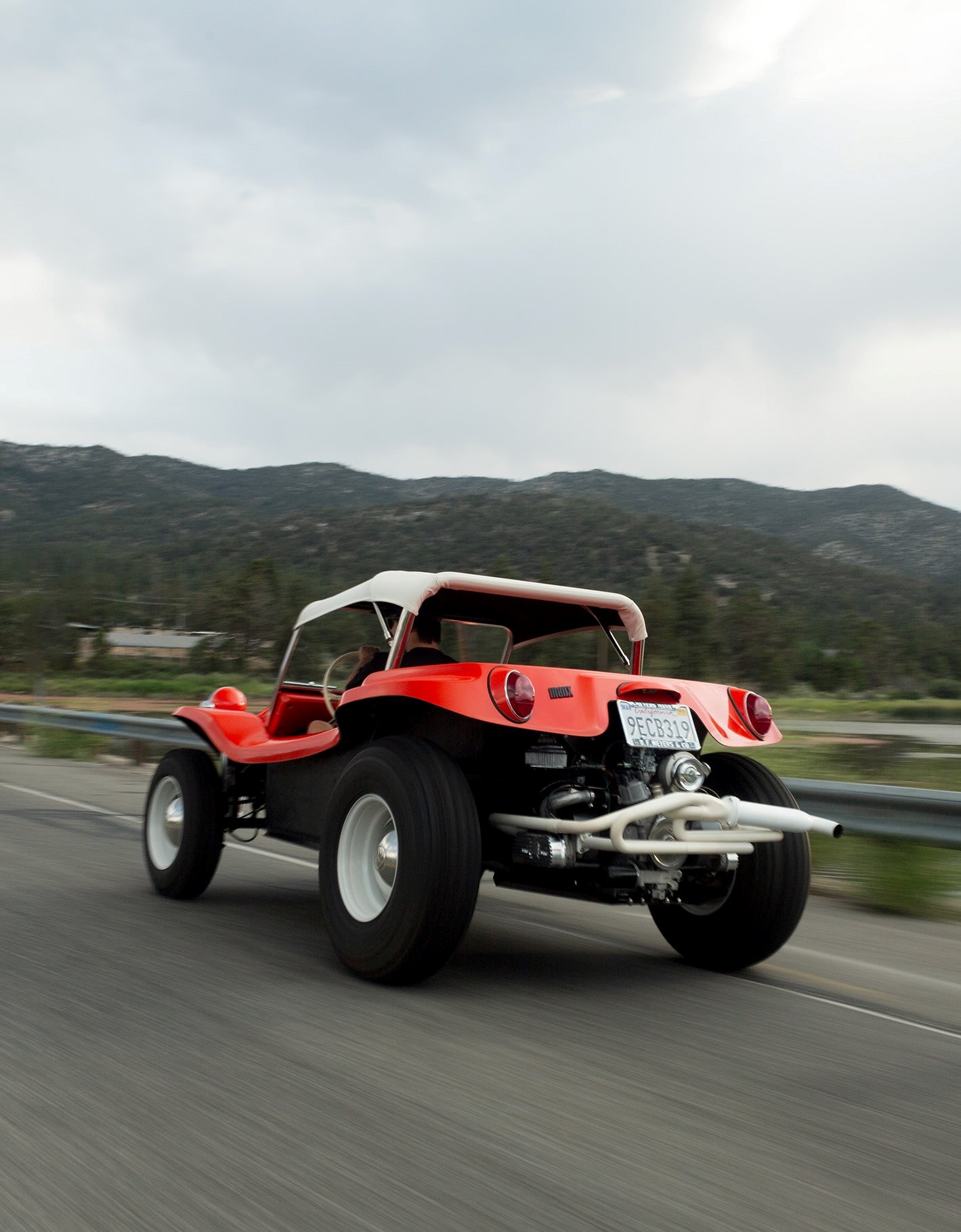
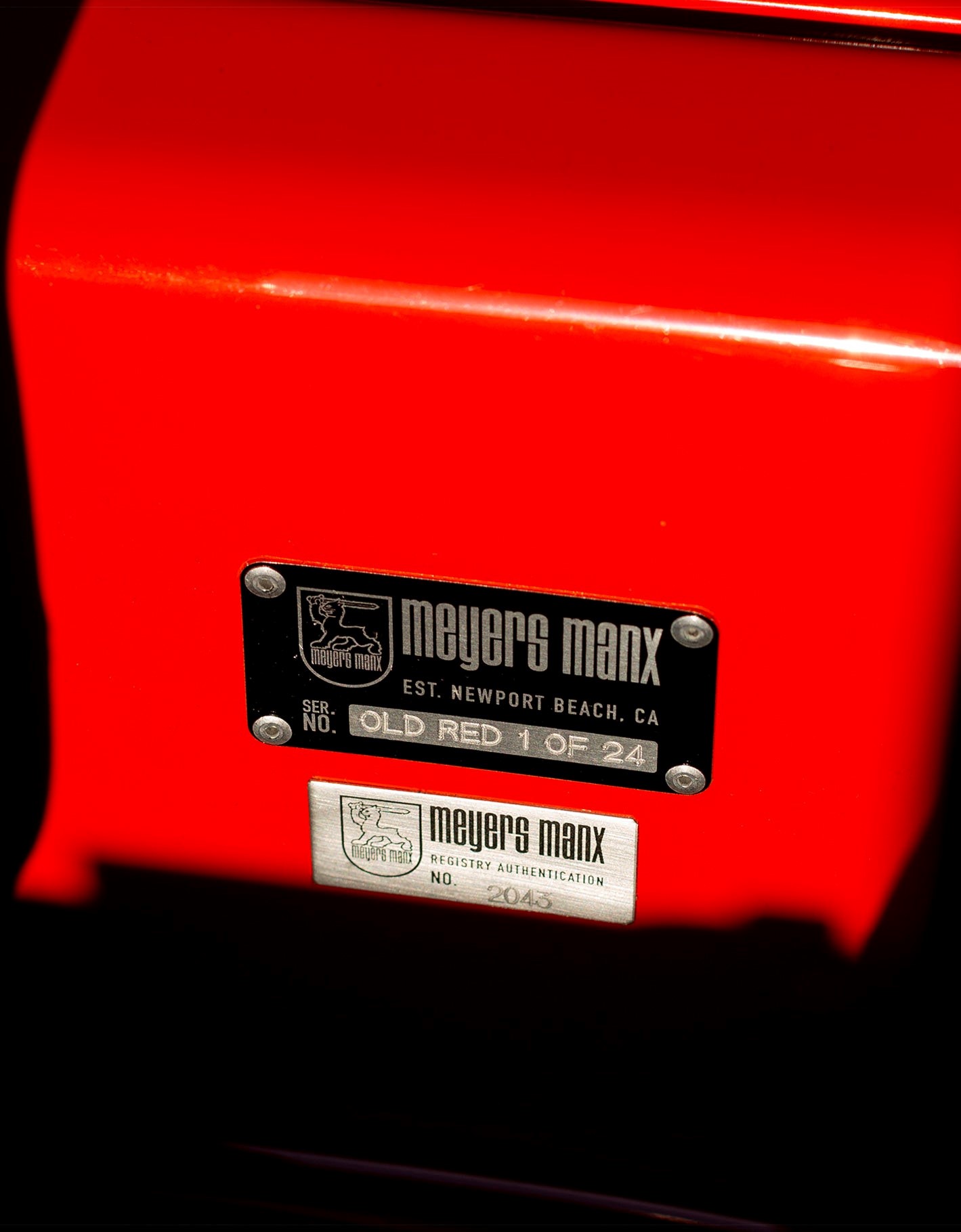
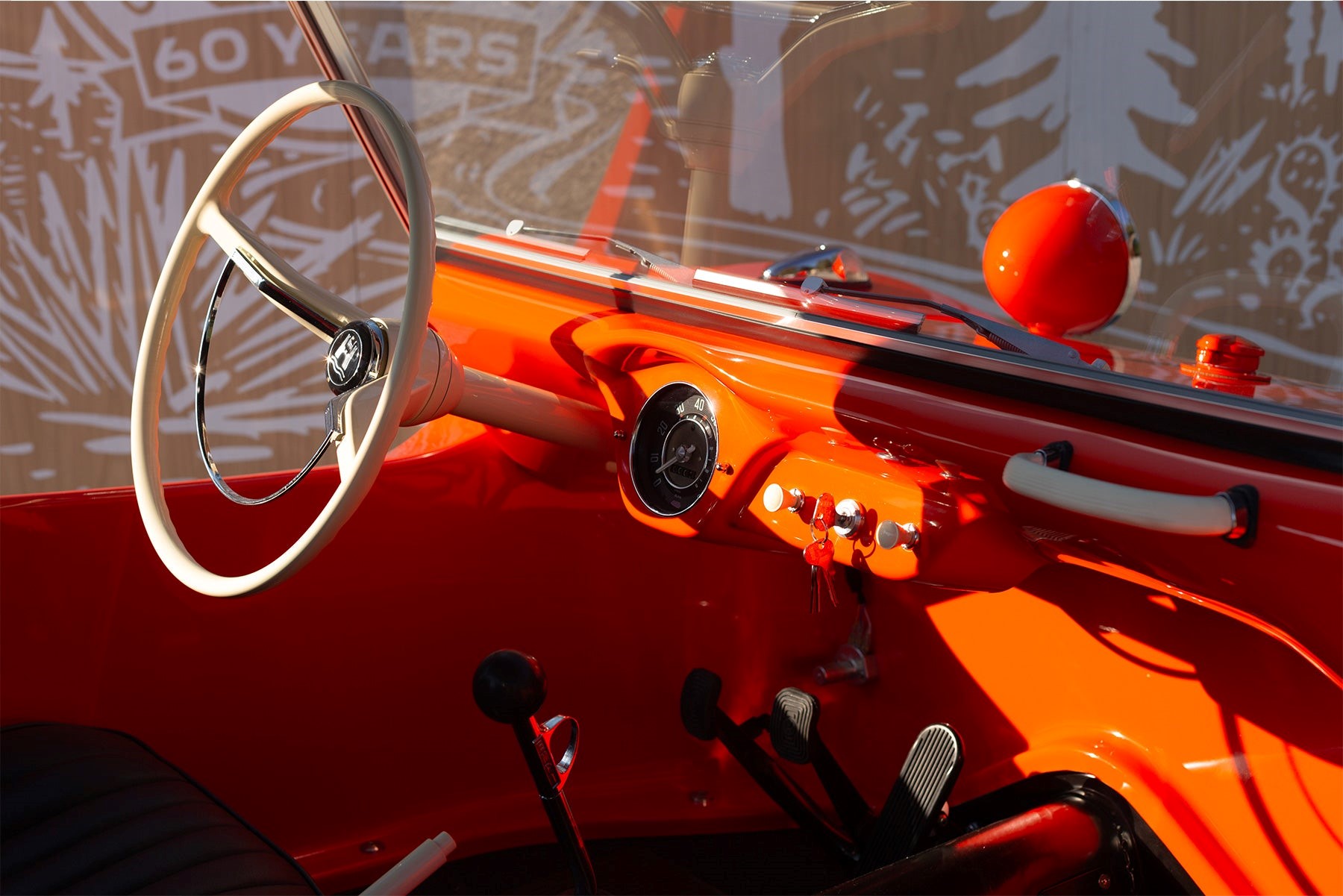
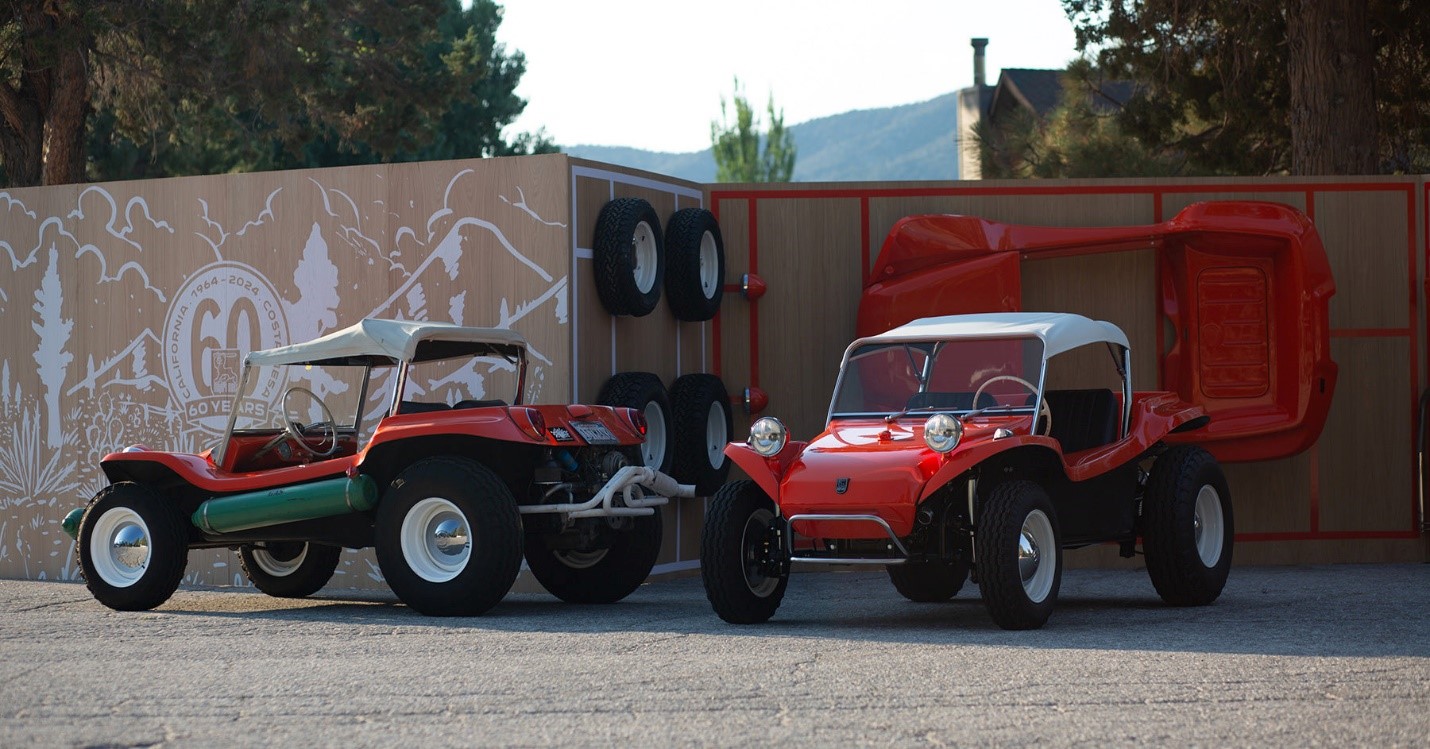
Meyers Manx shows out: introducing the 60th anniversary collection
Meyers Manx made a significant presence at the event, showcasing pieces of our rich history. Alongside the debut of the Remastered Old Red Kit, attendees got an up-close look at the Original Old Red and the exclusive Steve McQueen Meyers Manx, famous from the 1968 film ‘The Thomas Crown Affair.’
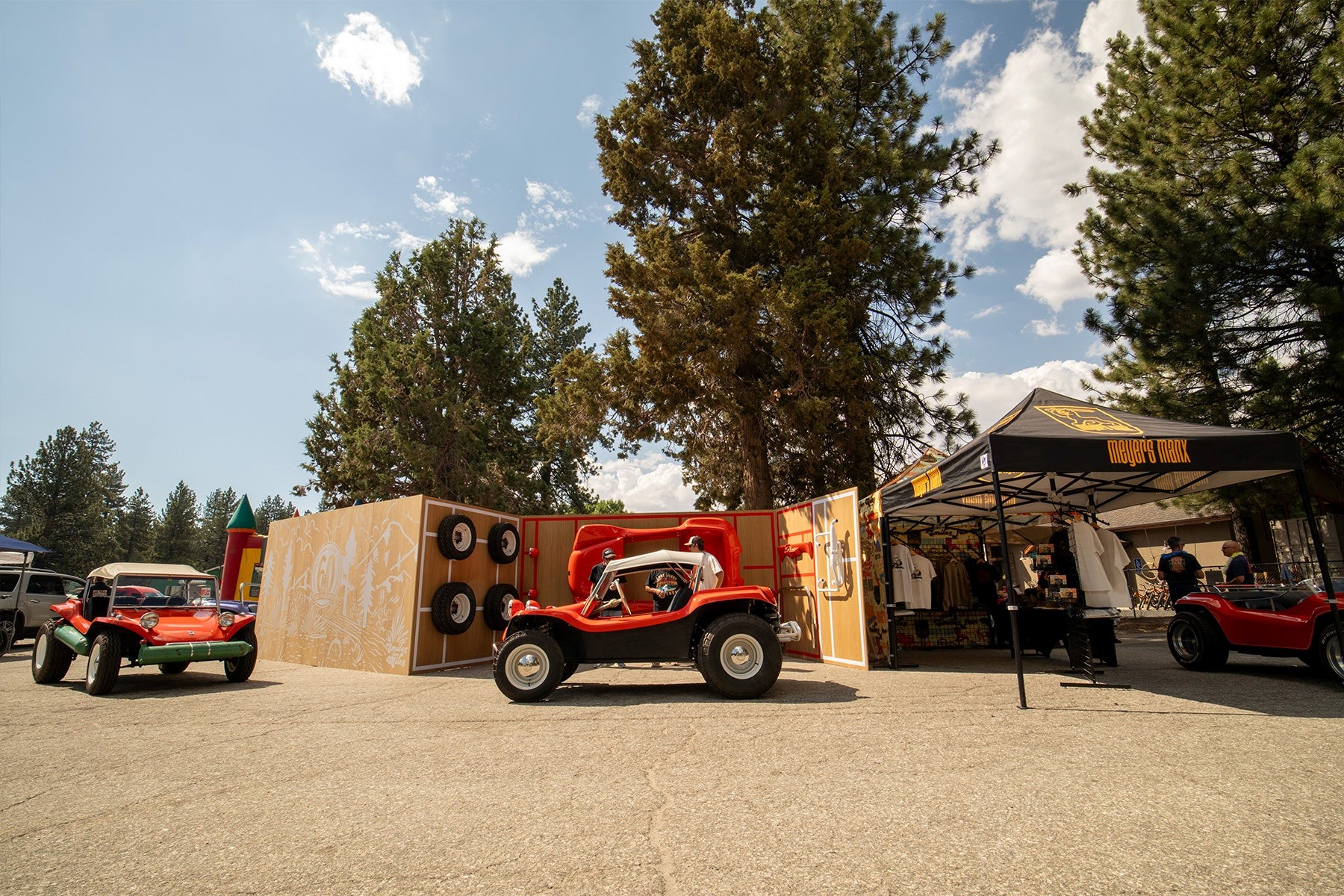
Manx Club members also had the first chance to purchase our 60th Anniversary merchandise collection, featuring three new t-shirts, one new hat and a limited-edition sticker pack.
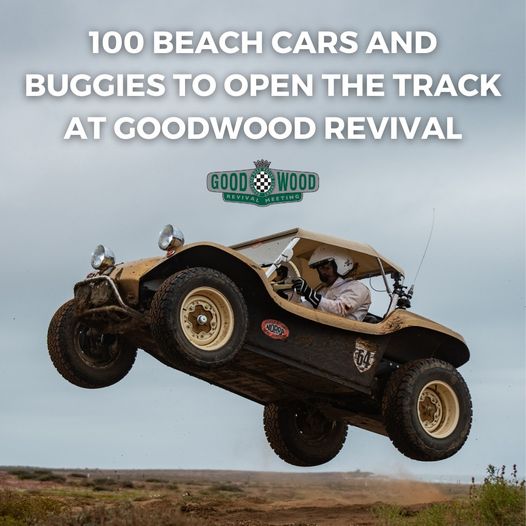
This year's Goodwood Revival track opening parade will celebrate the 60th anniversary of the original Meyers Manx beach buggy!
September at Goodwood Revival didn’t have the weather for the beach buggies but, if you close your eyes and dream hard enough, you can feel a Californian breeze.
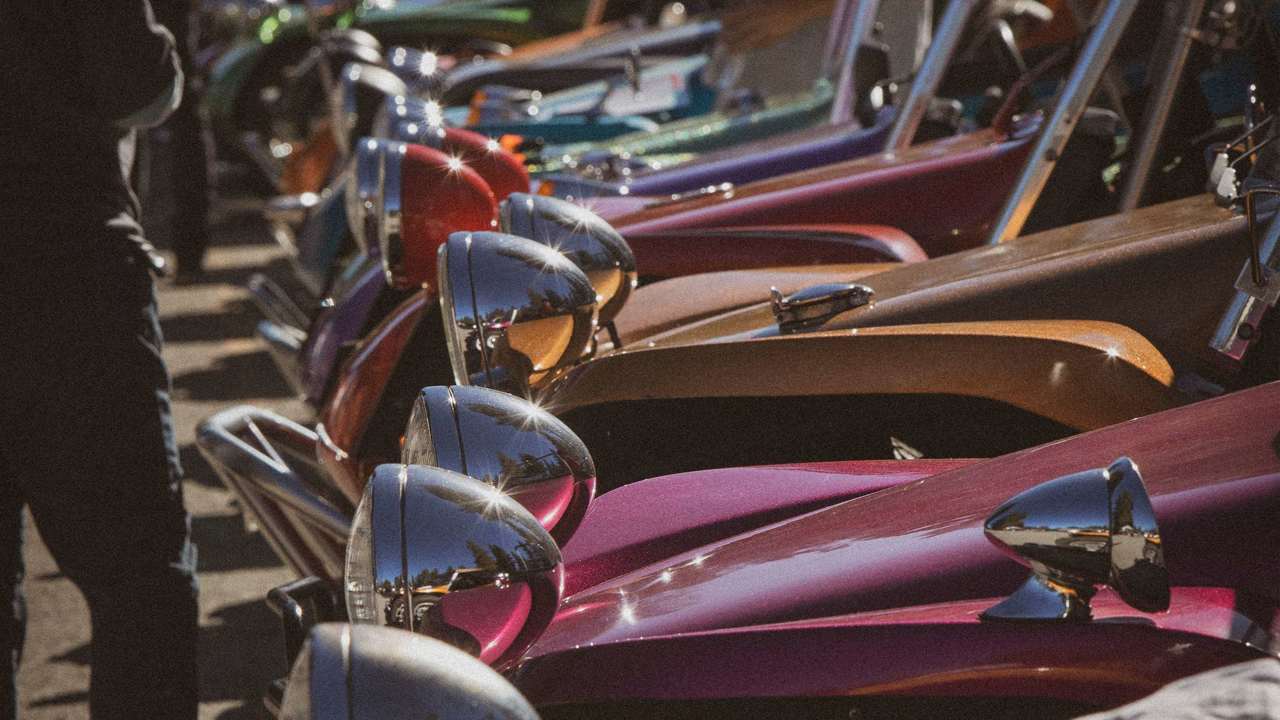
Meyers Manx Revival track opening parade.
The legendary Meyers Manx buggies launched the 2024 Goodwood Revival in style. It might not have been the Californian sunshine they’re used to, but wow, what a sight!
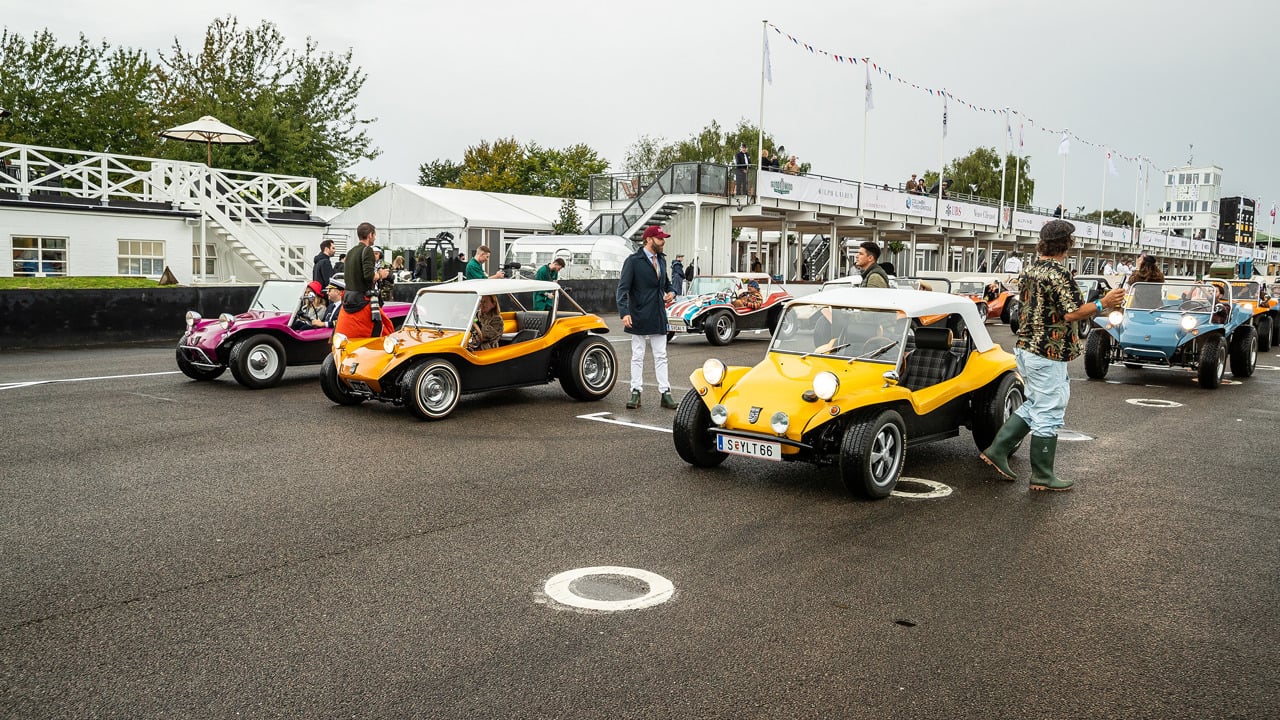
Photo by Joe Harding.
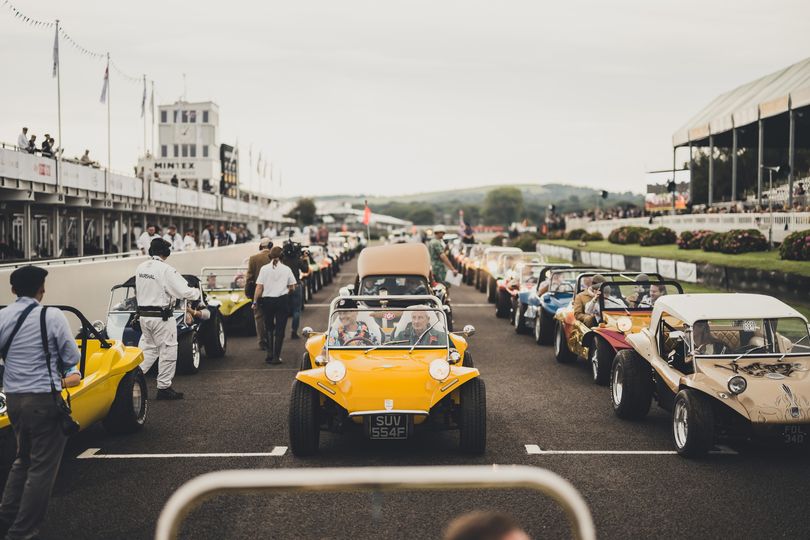
Conceived by Bruce Meyers, the beach buggy, or dune buggy as it was more commonly referred to at the time, proved an instant hit. Success in the Baja 1000 proved its performance mettle and an article in Car and Driver magazine got the phone ringing off the hook. People liked what they saw... and they wanted one.
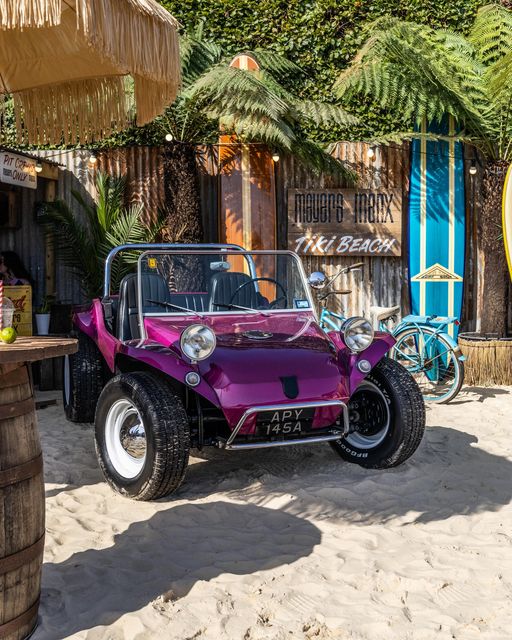
A large part of the appeal of the Manx is its simplicity. The one-piece main body tub sits on a shortened Volkswagen Beetle chassis creating a capable, lightweight machine. The name, incidentally, is derived from the tail-less cat breed, reflecting the car’s truncated appearance.
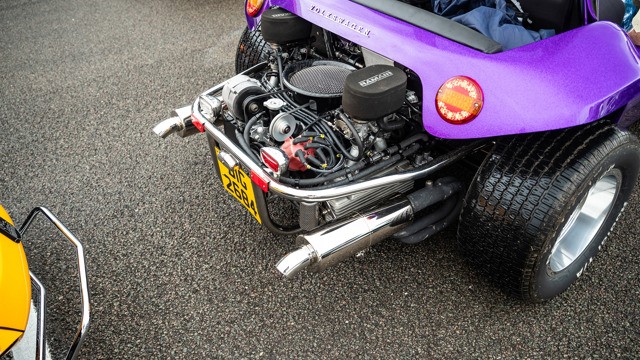
Photo by Joe Harding.
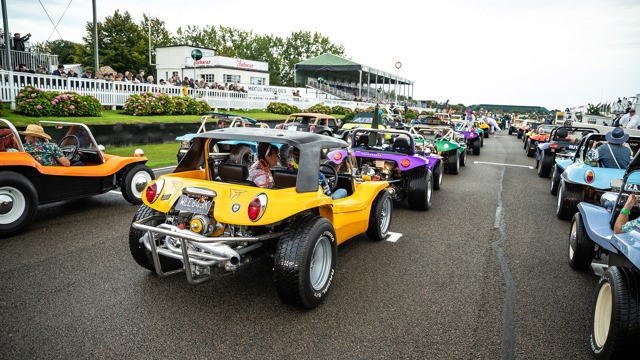
Photo by Joe Harding.
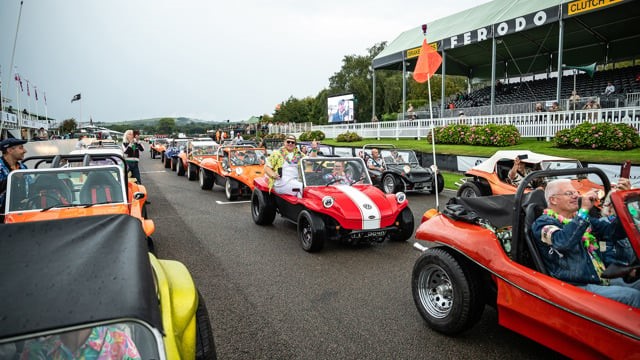
Photo by Joe Harding.
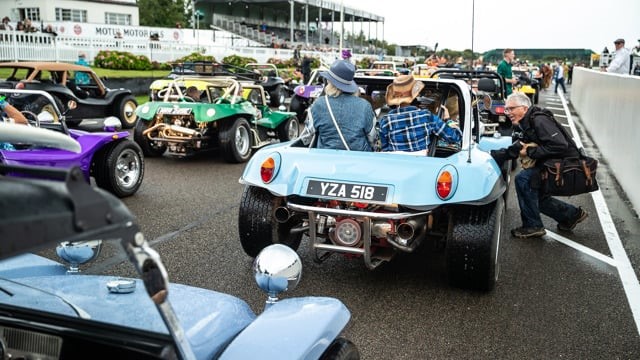
Photo by Joe Harding.
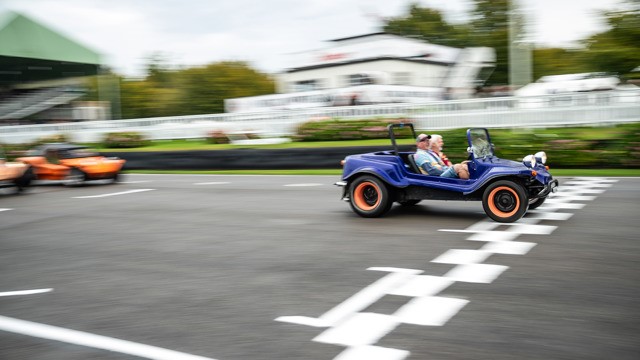
Photo by Joe Harding.
The pioneering machine inspired an entire genre of pretenders and, six decades on, the popularity of the beach buggy is as strong as ever. There has been a reassurance of interest this century, thanks in no small part to Bruce himself returning to the market with Meyers Manx Inc in 2000.
The Meyers Manx is undoubtedly the most imitated kit car of all time, with scores of manufacturers around the world taking a slice of the action. It’s for that reason that many of the cars in the parade were from other manufacturers. Meyers Manxes appeared in the greatest numbers, but you’ll also witness Moonface, Sidewinder, Predator and JAS models in the line-up.
Coinciding with the moving display of air-cooled fun cars is the European debut of the new Meyers Manx 2.0 EV, taking place this weekend at Revival. We wonder whether the electric buggy will have such a following in another sixty years’ time...
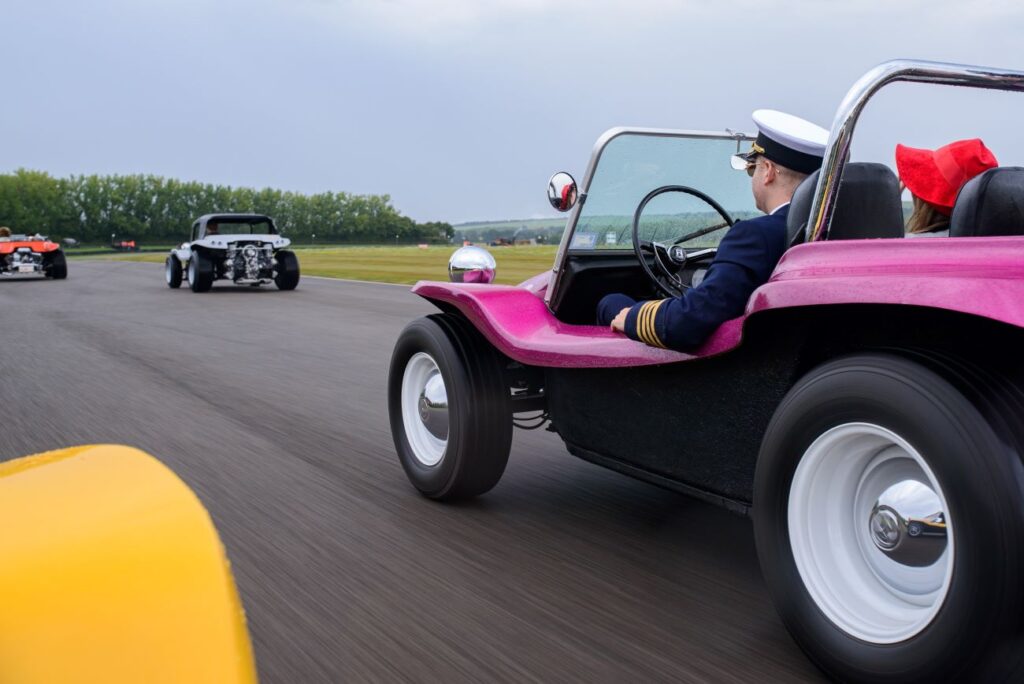
Meyers Manx celebrates 60th anniversary and European debut of 2.0 Electric Prototype at Goodwood Revival. September 06, 2024.
Meyers Manx kicked off its 60th anniversary bringing nostalgia and innovation together for a global audience with a spectacular parade featuring over 80 Meyers Manx dune buggies at the Goodwood Revival on the 6th of September.
The parade marked a milestone moment in the history of the brand. Over 80 buggies, driven by enthusiasts from around the world, navigated Goodwood’s historic track despite light rain, their unmistakable exhaust notes and cheerful drivers recalling the timeless appeal of these beloved machines.
At the forefront of this celebratory procession was Phillip Sarofim, Chairman of Meyers Manx, driving the Duke of Richmond and Gordon in a newly remastered Meyers Manx Resorter. This reimagined version, built on a 1966 Volkswagen Beetle chassis, features charming wicker seats and blends retro spirit with a modern touch, paying tribute to the adventurous roots of the brand while nodding toward a bright future.
The festivities continued at the Earls Court Motor Show, where Meyers Manx made waves with the European unveiling of the Meyers Manx 2.0 Electric Prototype. This highly anticipated debut introduced a bold new chapter in the brand’s storied history. The 2.0 Electric Prototype is an electric reimagination of the classic dune buggy, promising to deliver the same thrilling driving experience while embracing a sustainable future. With its seamless blend of heritage and forward-thinking design, the vehicle captivated both industry insiders and the public, proving once again that Meyers Manx remains at the cutting edge of automotive culture.
“Goodwood Revival is the perfect stage to honour 60 years of Meyers Manx while showcasing the future with our electric prototype. It’s a tribute to the legacy Bruce Meyers started and a look forward to how we’re keeping the Manx spirit alive in the electric age”, Phillip Sarofim said.
Meyers Manx’s participation in the Goodwood Revival serves as both a homage to its storied past and an unveiling of its future. As the brand celebrates six decades of innovation, freedom and the unmatchable joy of open-air driving, its latest creations, like the Meyers Manx 2.0, ensure that this legendary name will continue to inspire generations of adventurers.
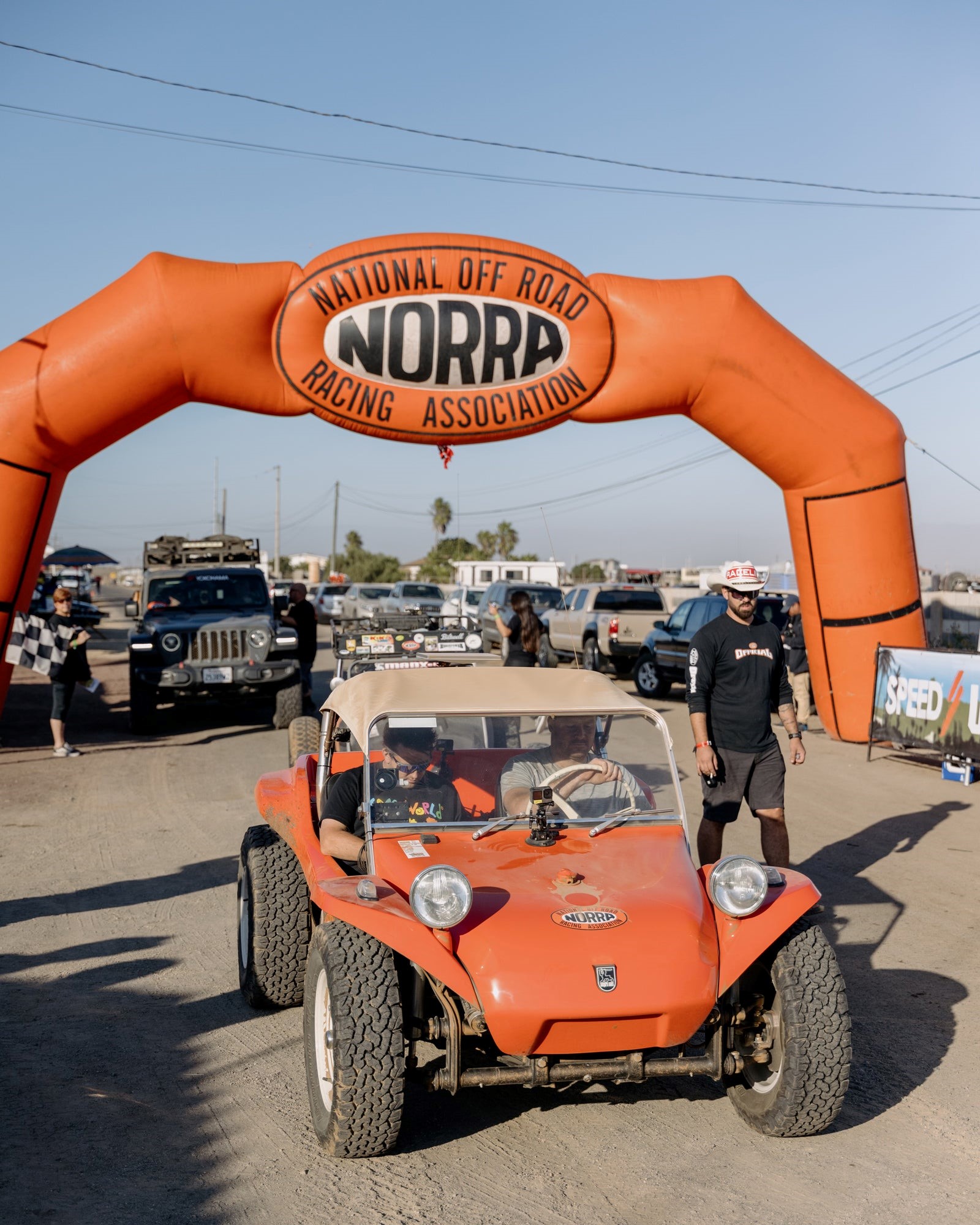
Celebrating 60 years of Meyers Manx: a return to Baja with Old Red. October 28, 2024.
To celebrate 60 years of Meyers Manx, we brought the Old Red Remastered Kit back to its roots in Baja California, honoring the spirit of Bruce Meyers and his iconic dune buggy.
This journey wasn’t just about retracing history; it was about experiencing the freedom and thrill that made the original Old Red a symbol of exploration. Jack Carlson — archaeologist, designer and founder of Rowing Blazers — and his best friend, Joe Guppy, a former Great Britain national team oarsman, took the wheel and embraced the same adventurous spirit that defined Bruce’s Baja journeys.
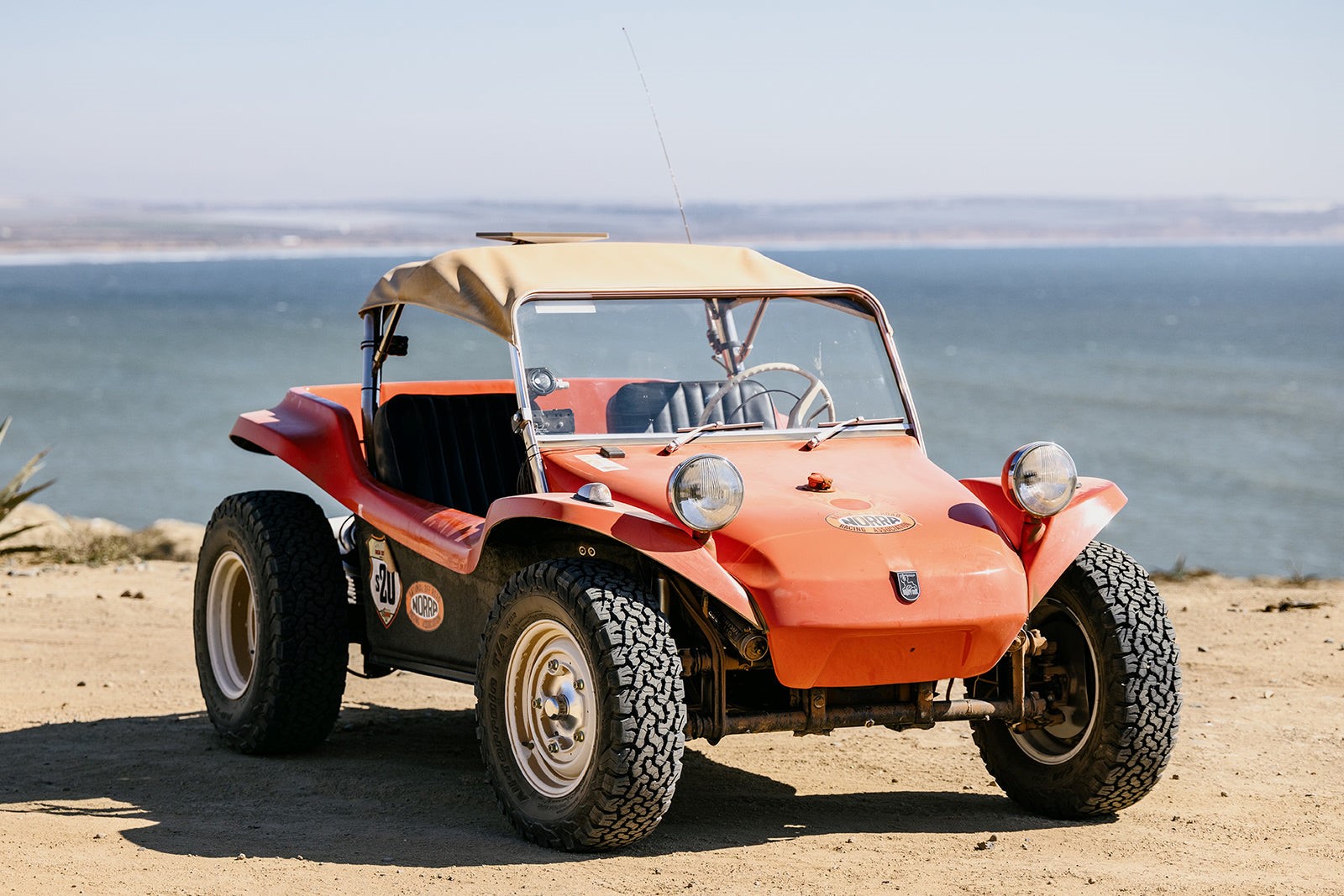
From San Diego to Ensenada Jack and Joe navigated winding coastal roads, raced up sunlit beaches and tackled rugged trails in the remastered Old Red, participating in the NORRA 500 Safari Class, presented by Meyers Manx. With little off-road experience, they relied on the craftsmanship and durability of the Old Red Remastered Kit, built for the ultimate self-assembly experience and featuring unique touches that set it apart.
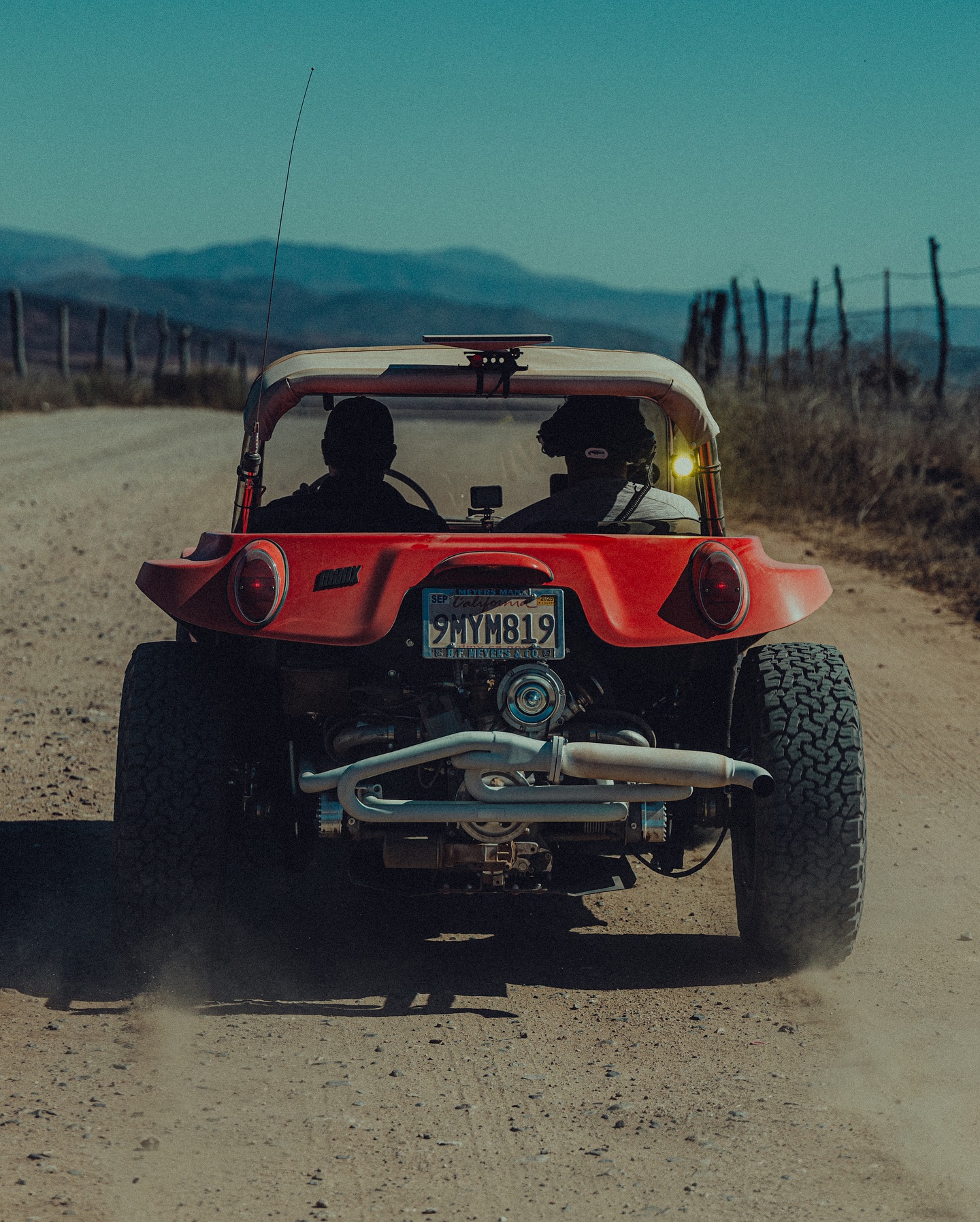
The dash is sculpted just like Bruce’s original handiwork from 1964, giving drivers a view over the color-matched headlight buckets that capture the same timeless look of the first Old Red.
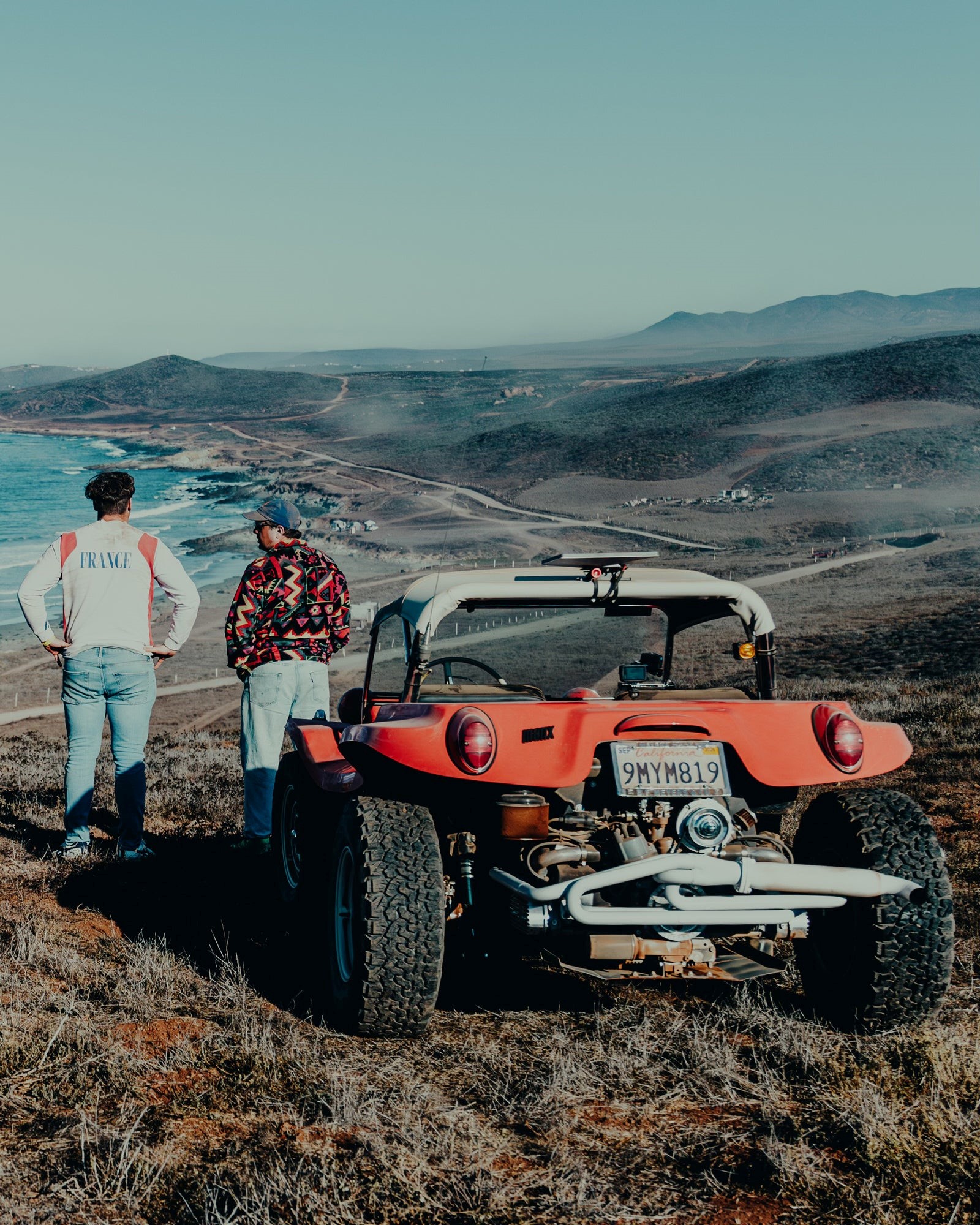
But the magic wasn’t just in the drive. After hours of navigating the backroads of Baja, they found themselves at local taco stands, sharing stories over fresh fish tacos and cold cervezas. And when hunger struck in the middle of nowhere, they even made sandwiches on the white Sidewinder muffler included with each Old Red kit.
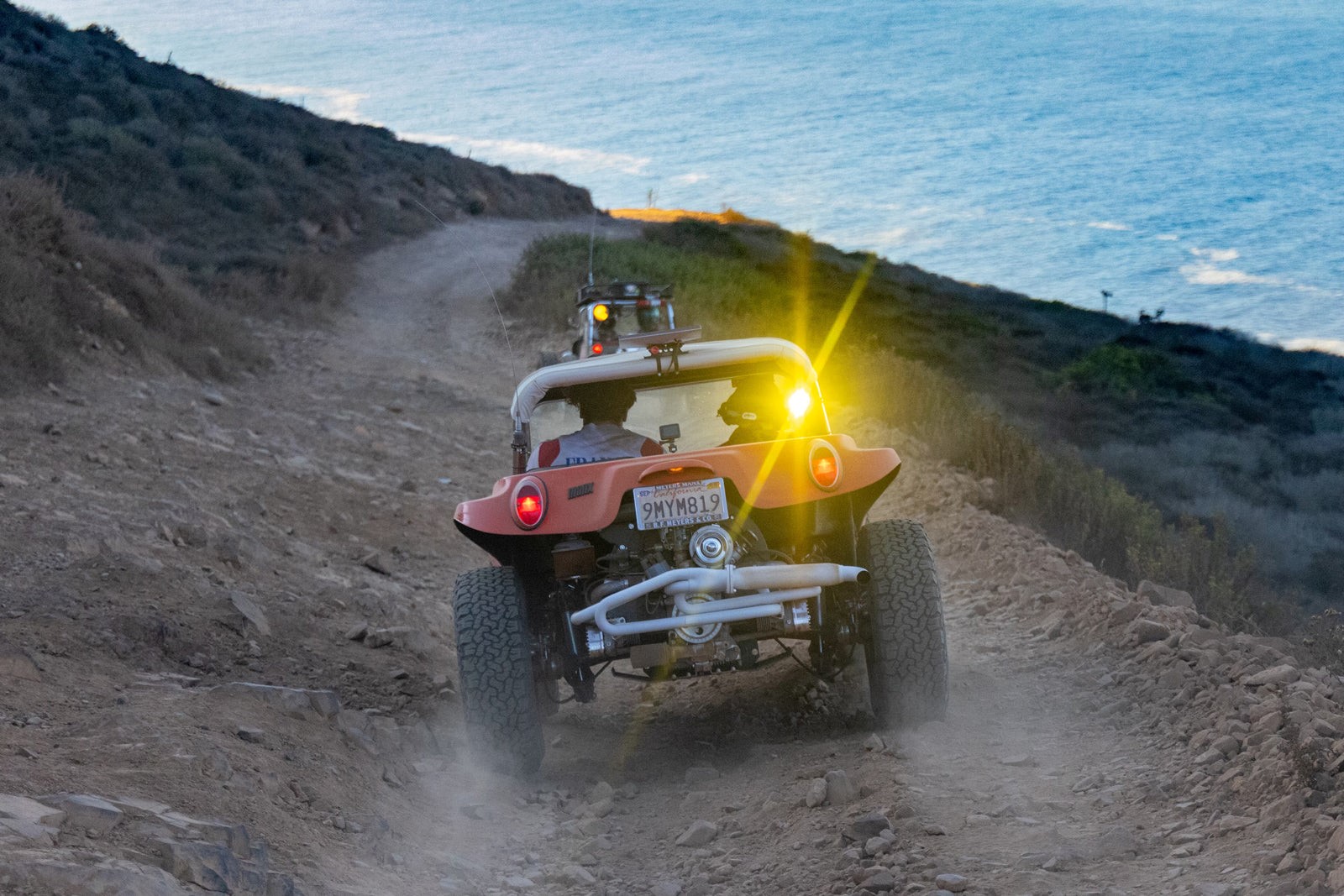
Each sunset stop, every off-road detour, reminded them of what Bruce discovered decades ago, a sense of adventure that lives in every moment and every mile in a Meyers Manx.
Videos

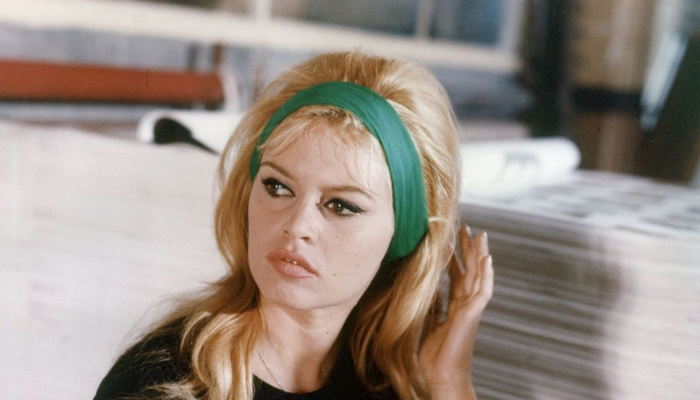
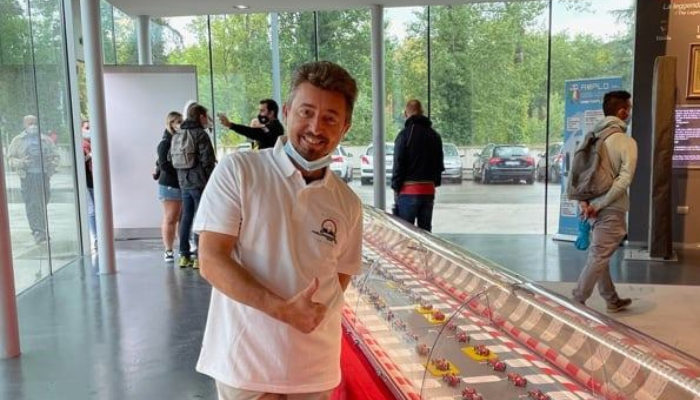
Comments
Authorize to comment